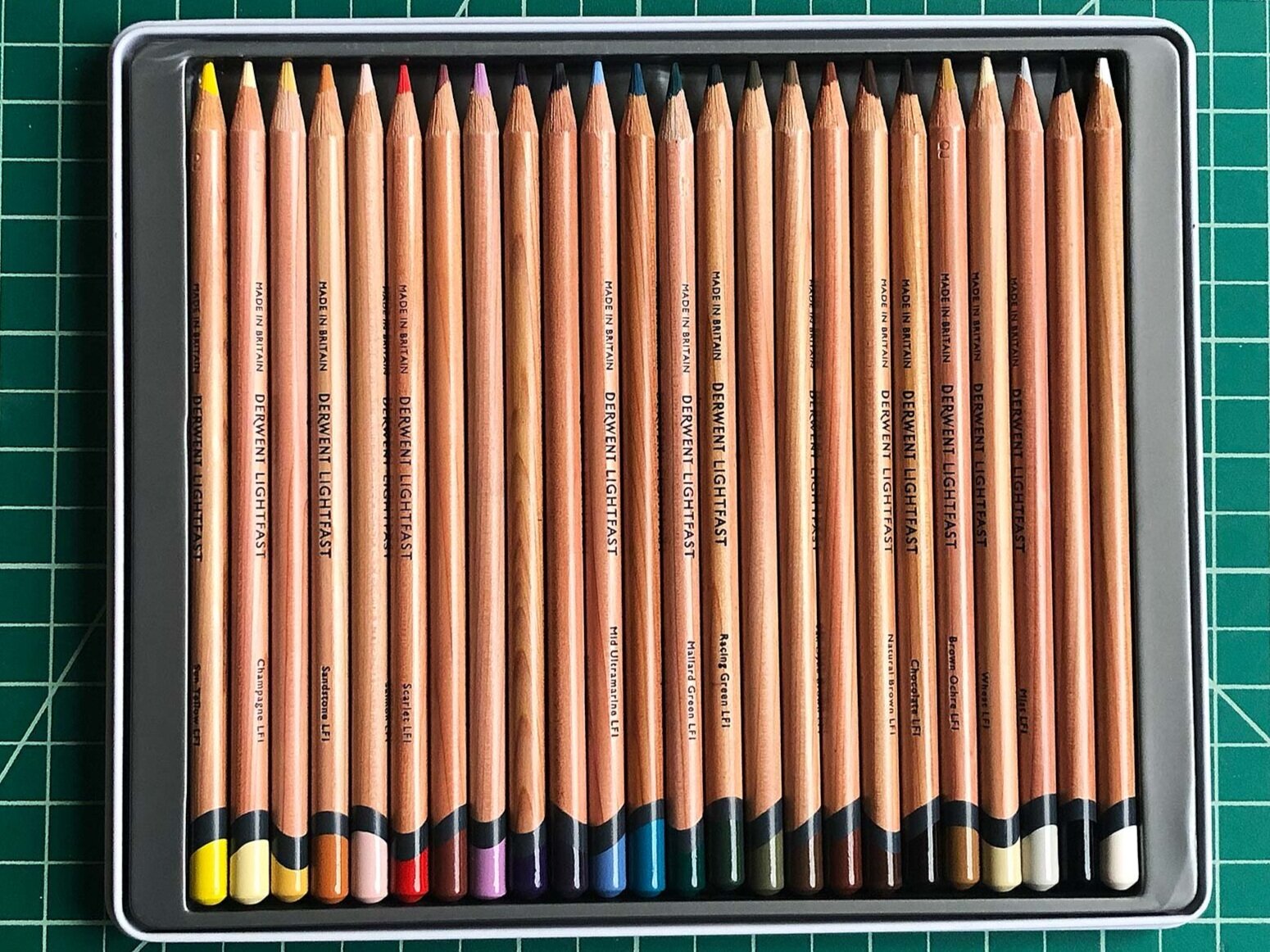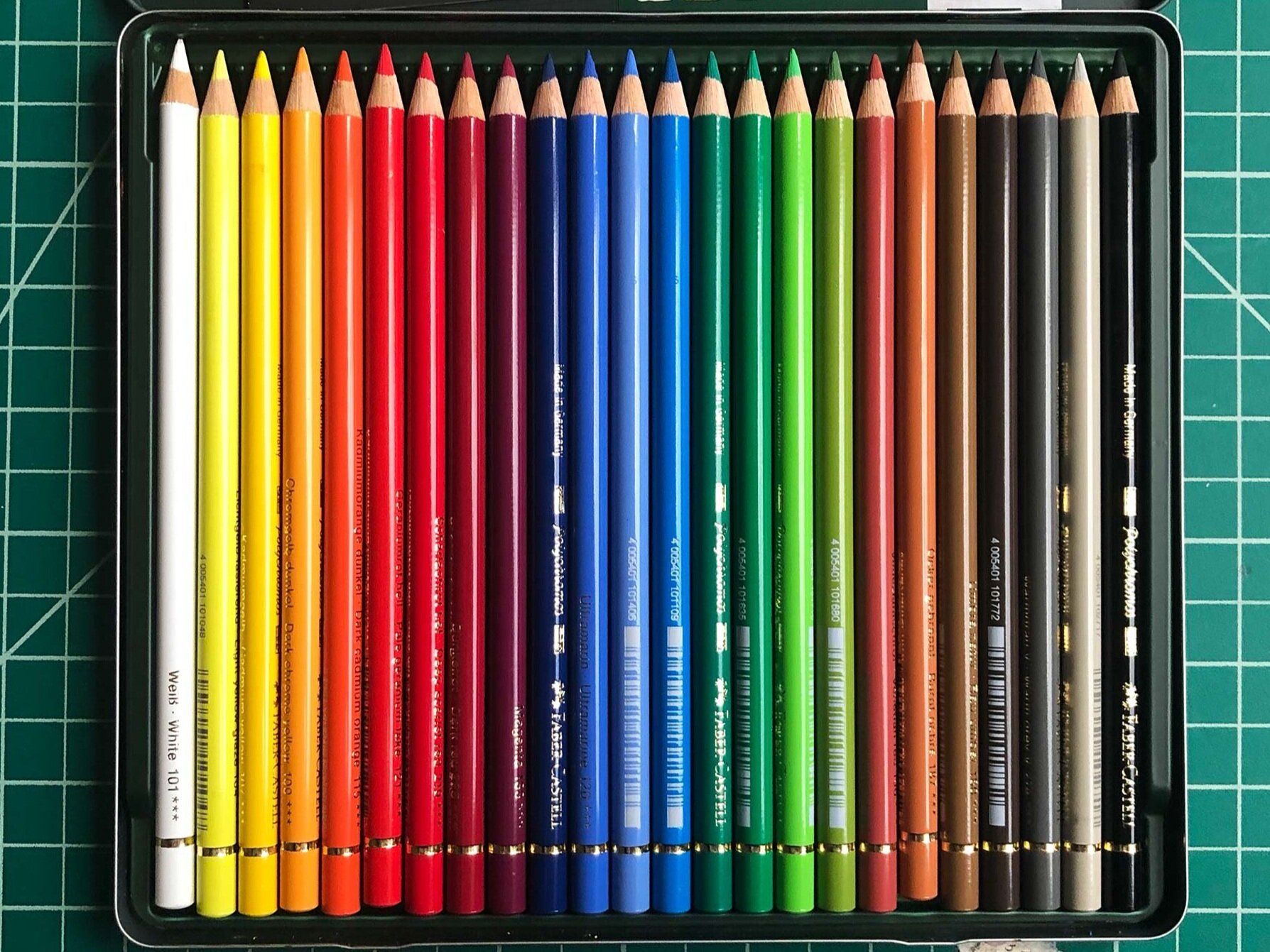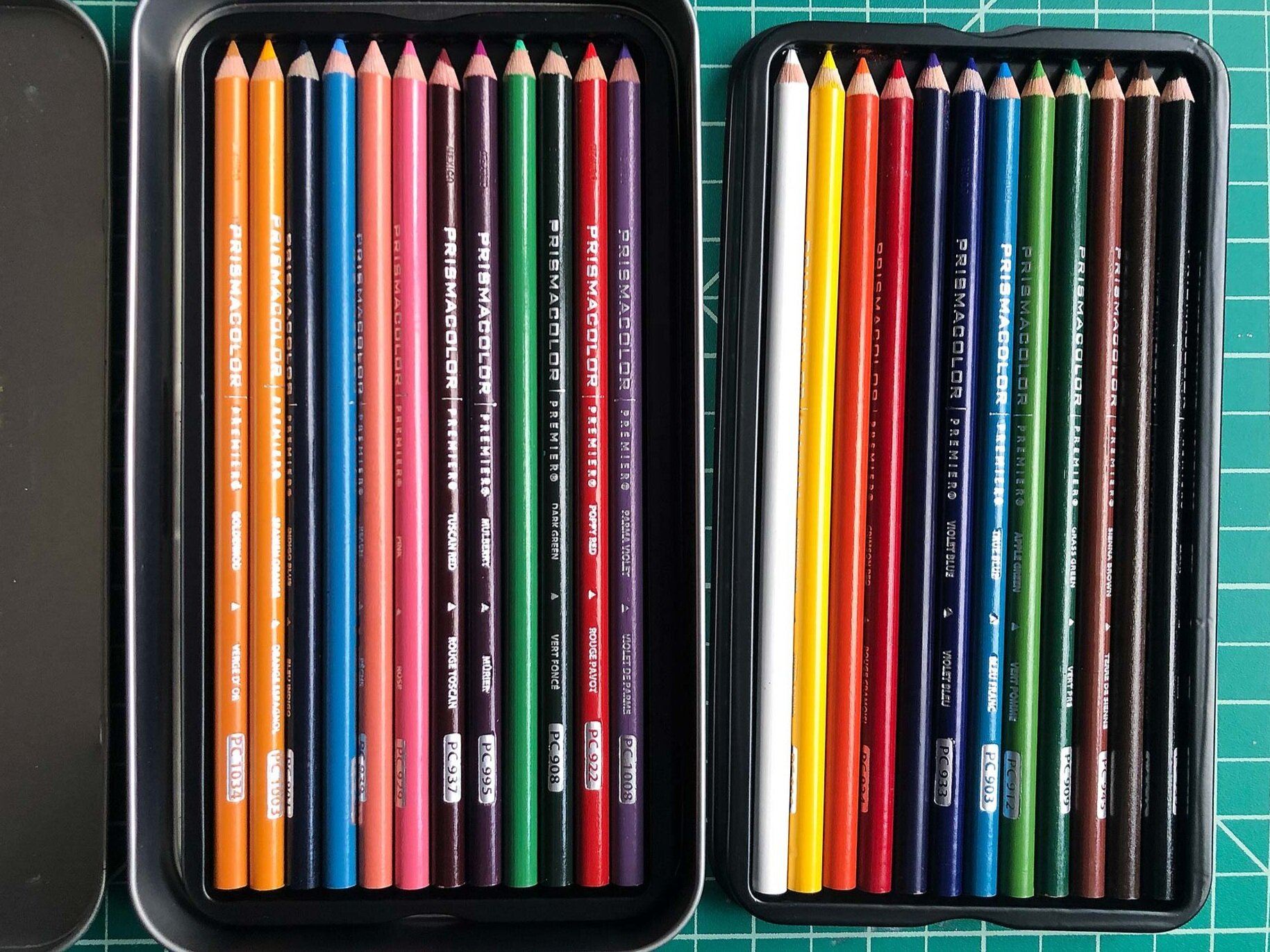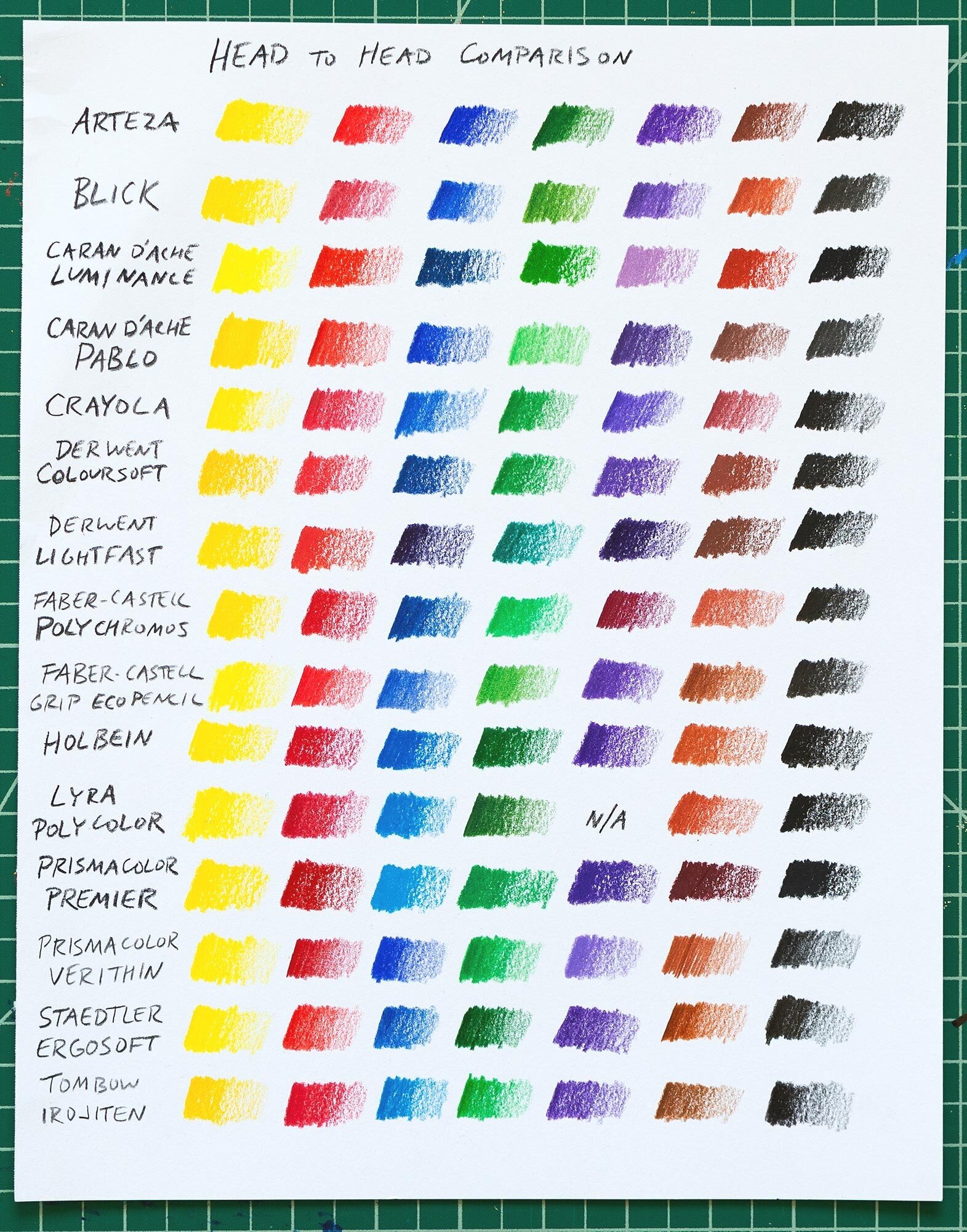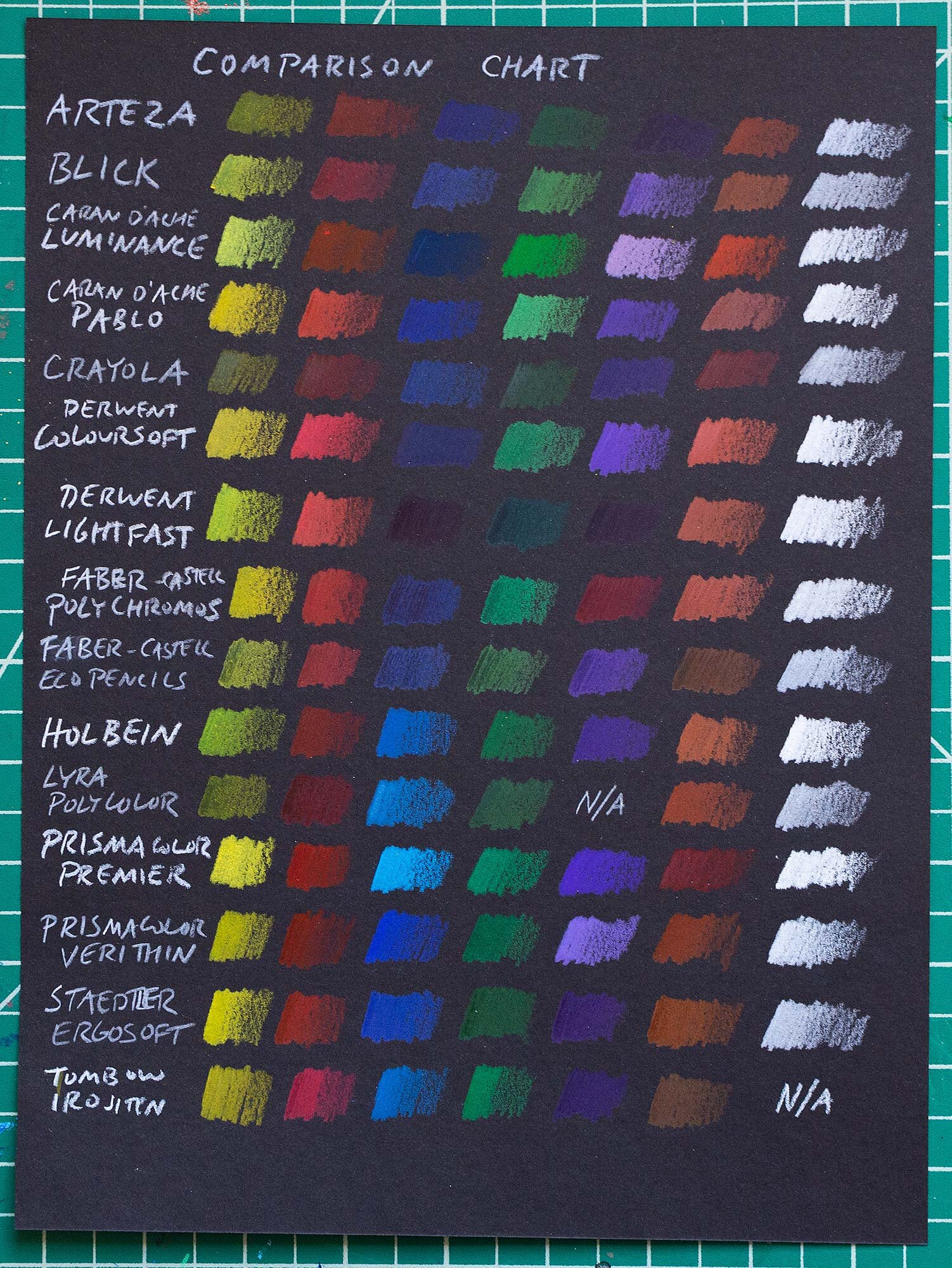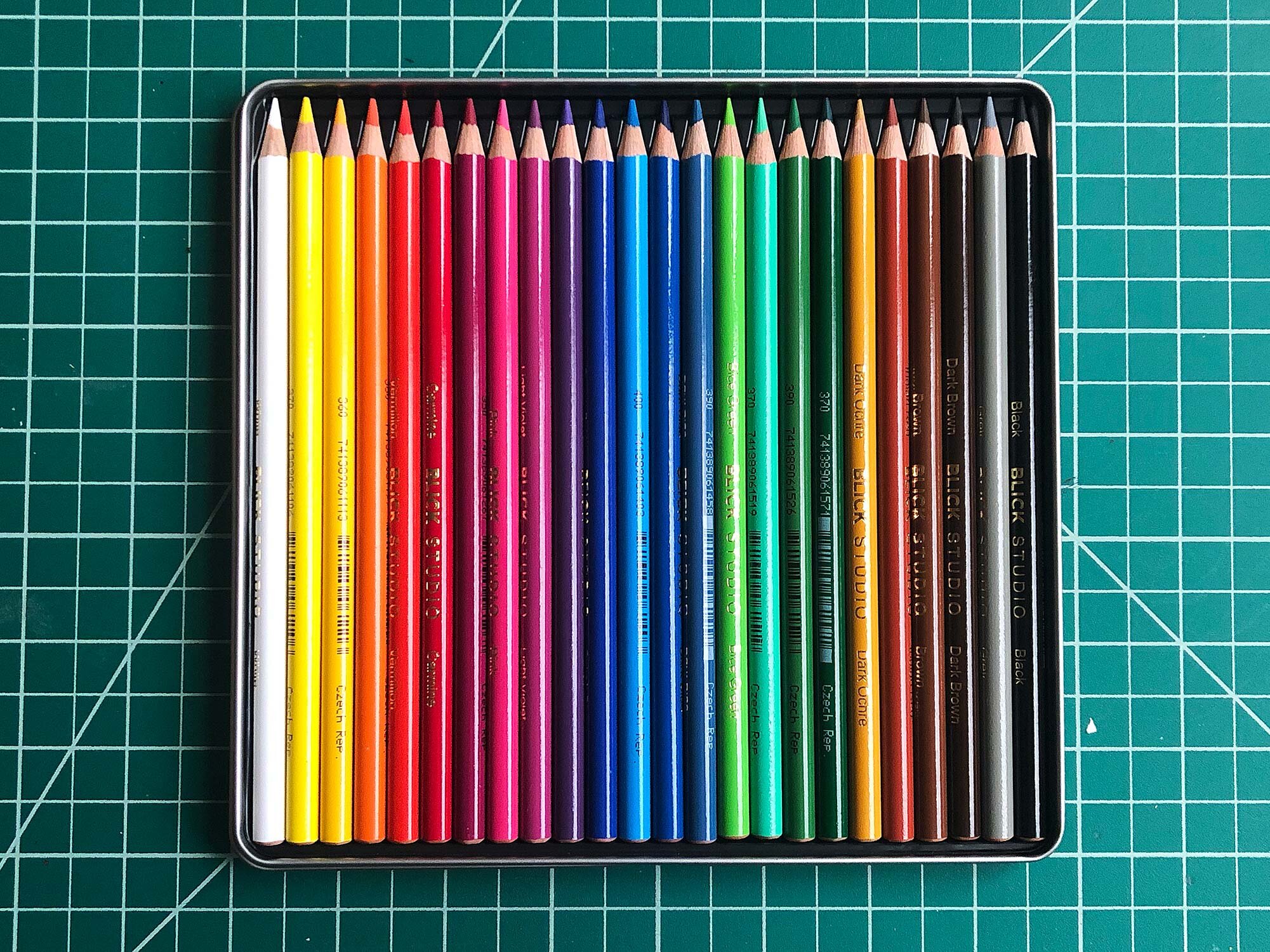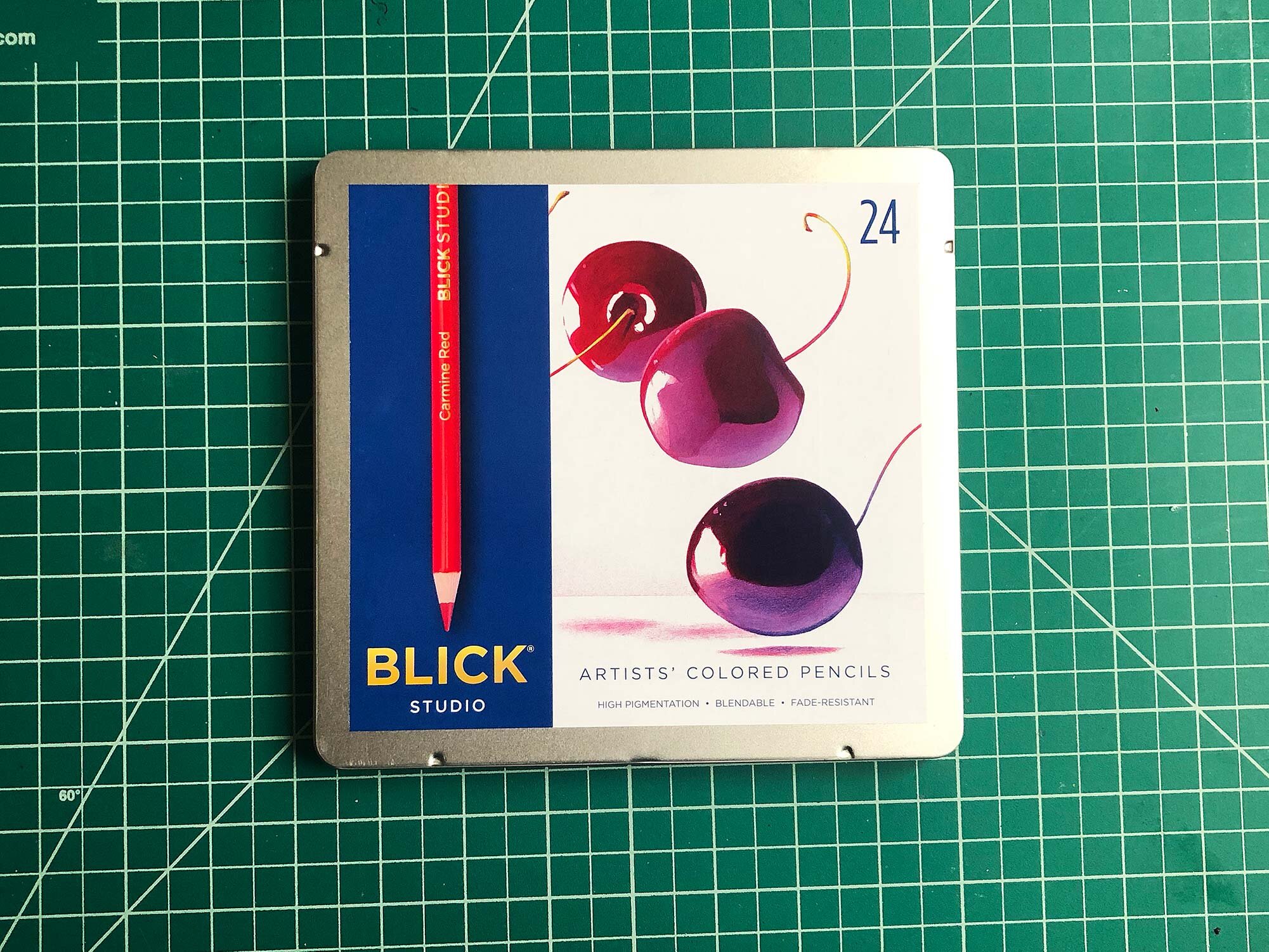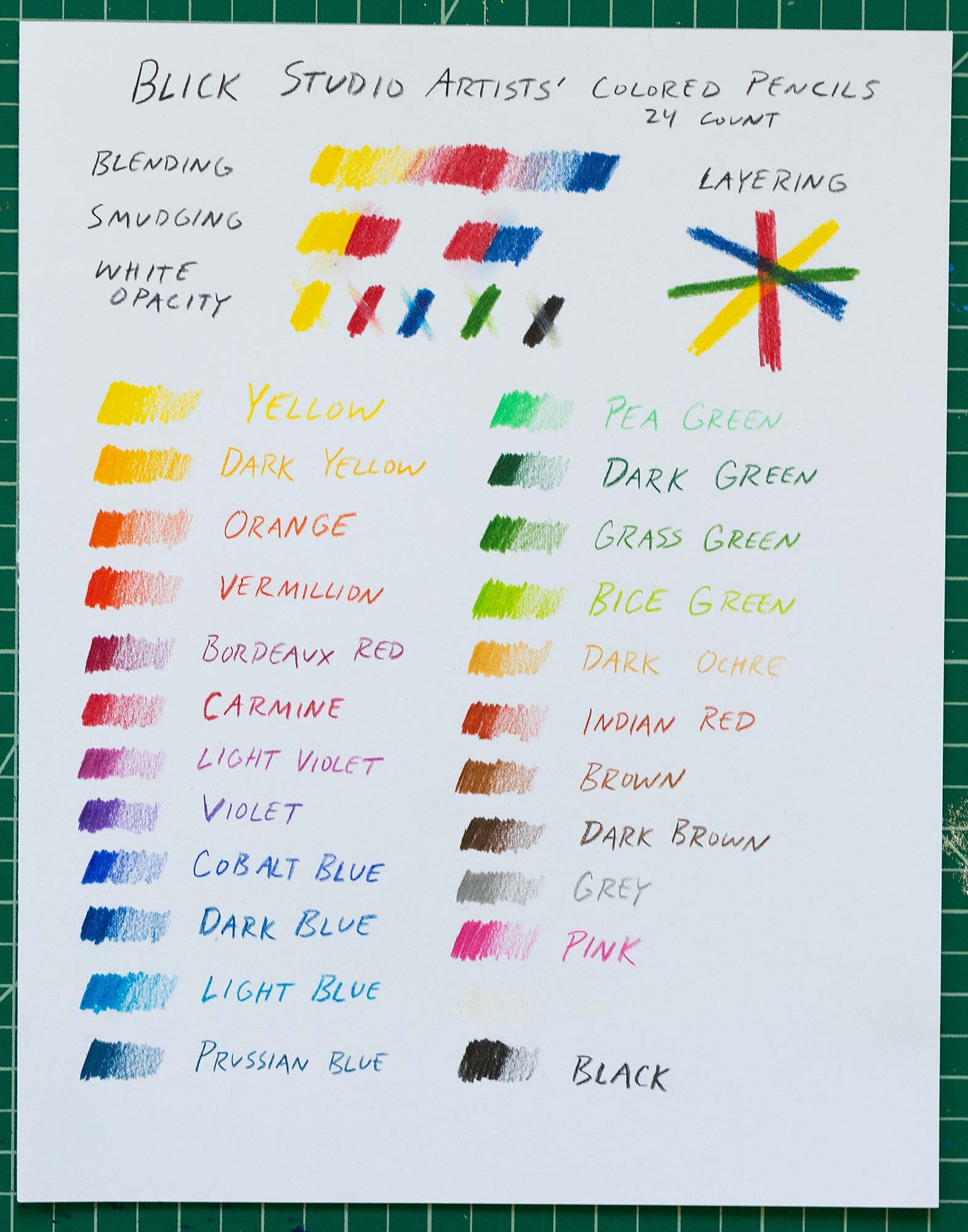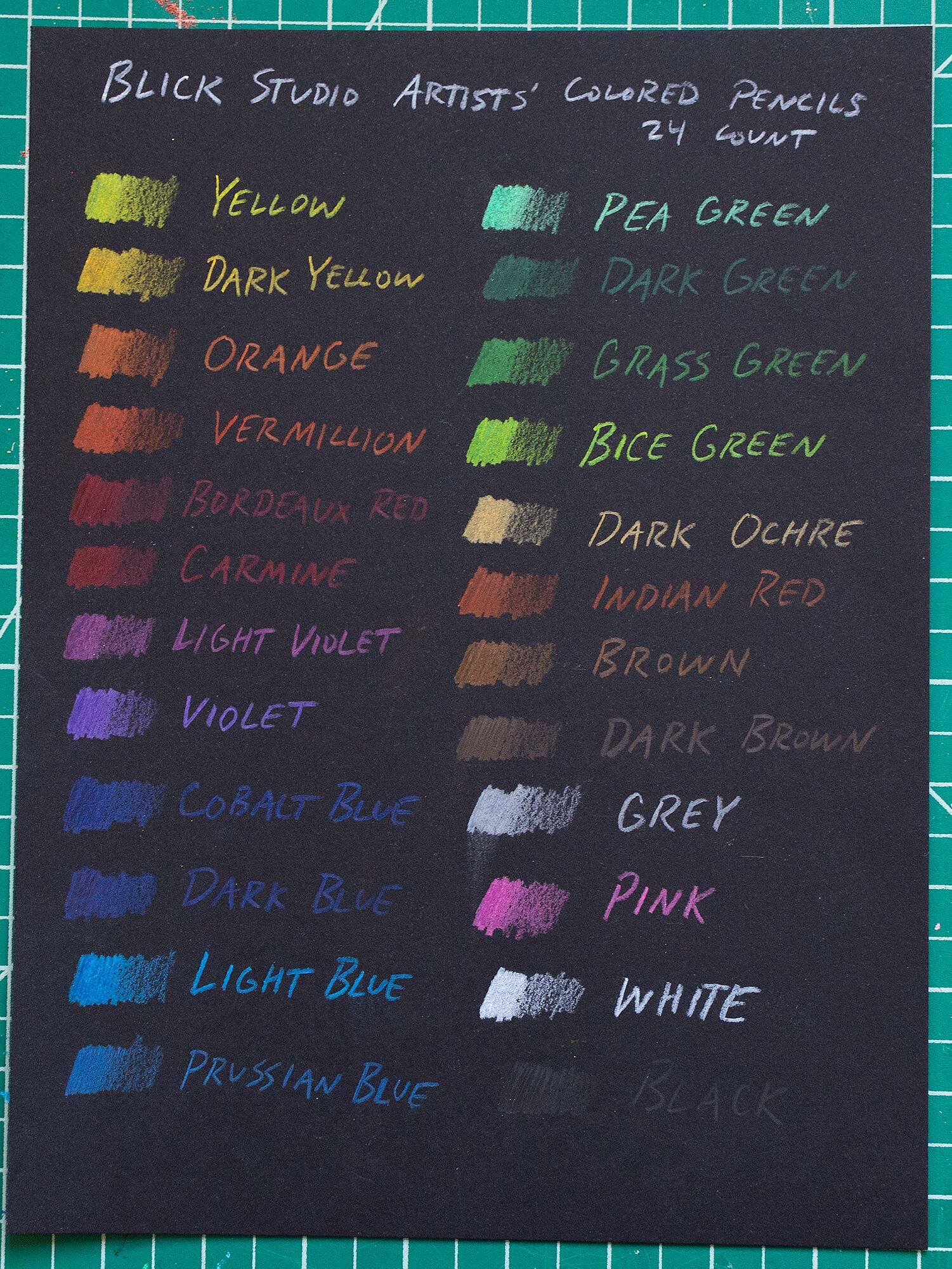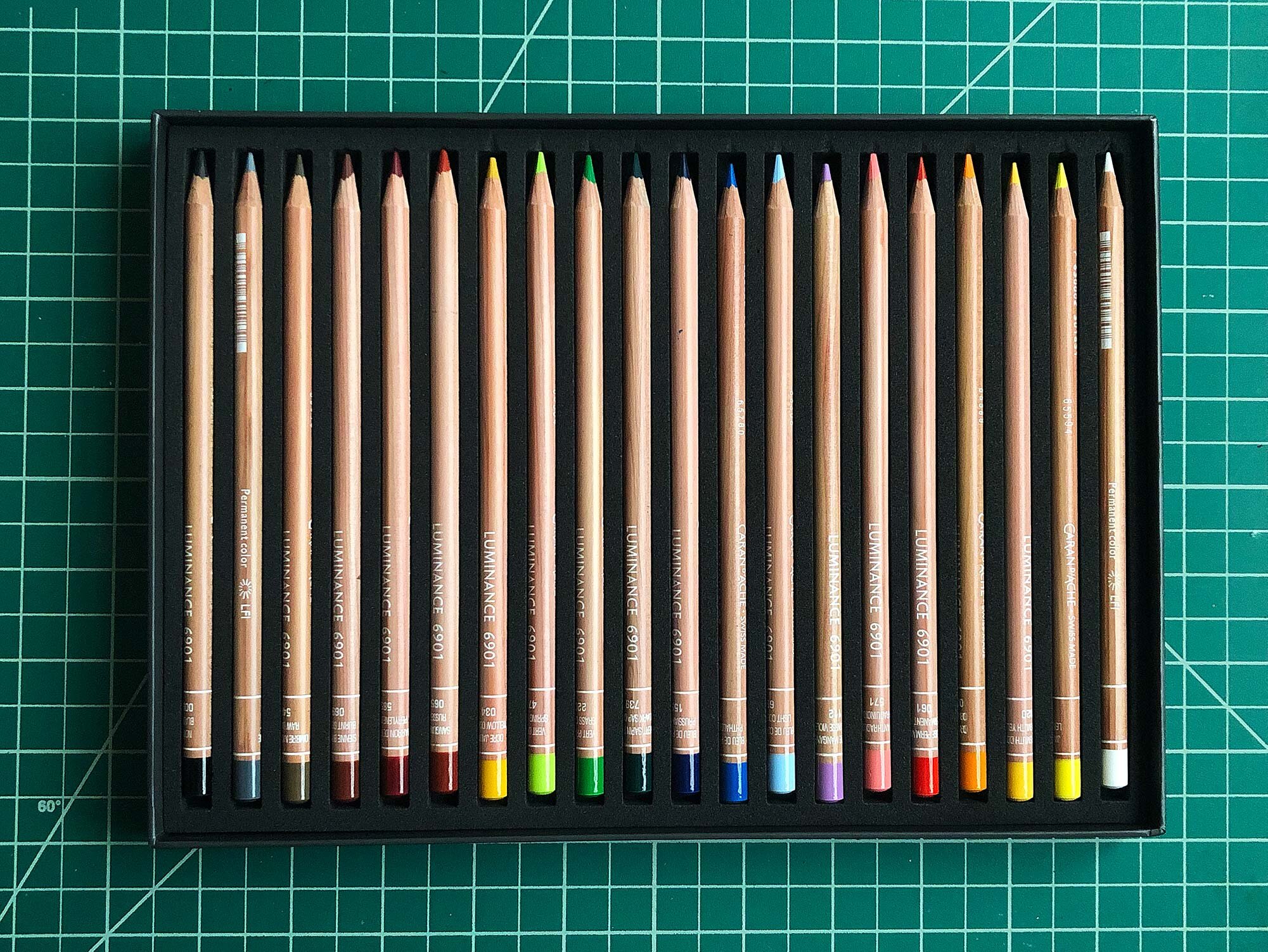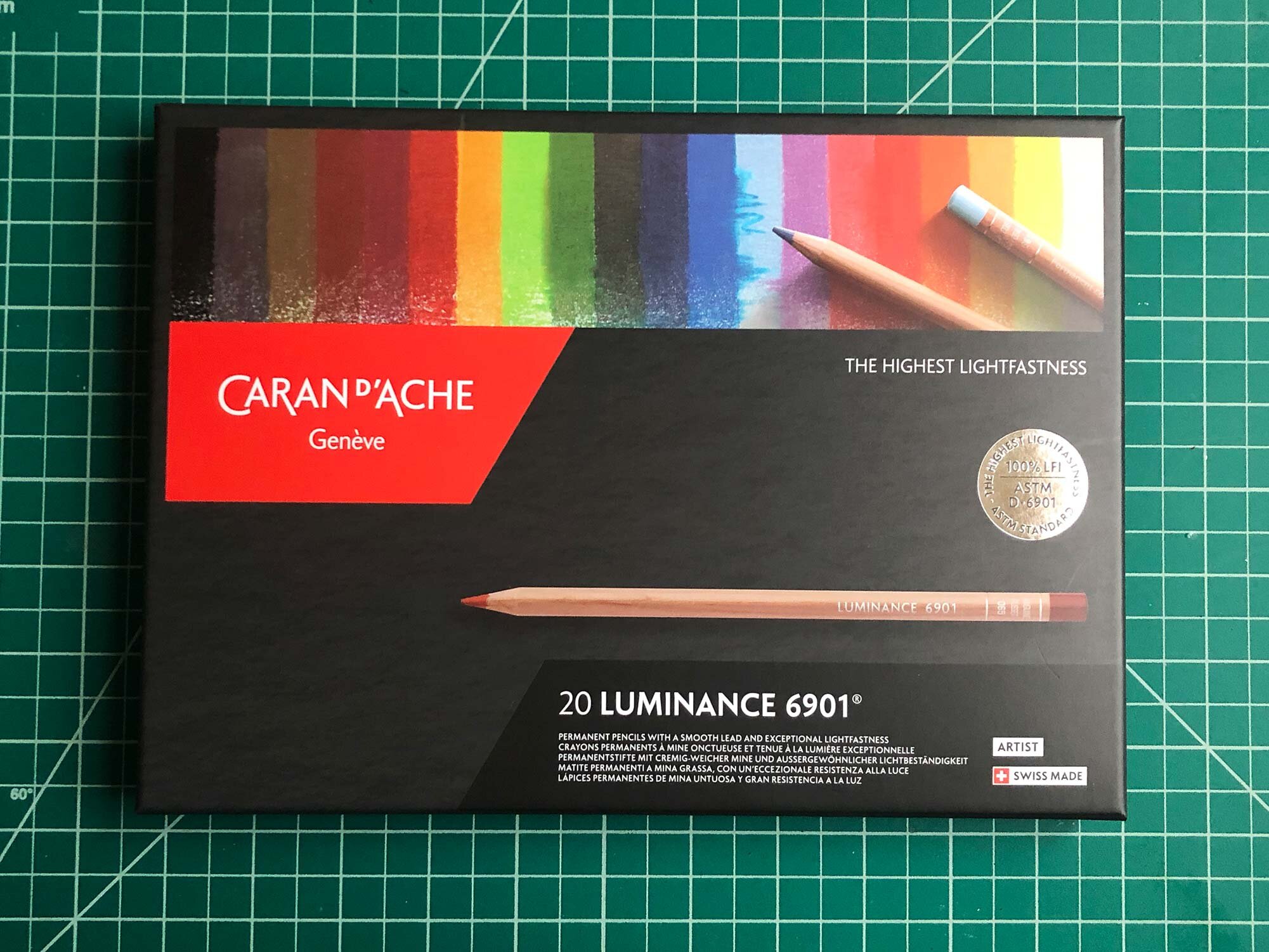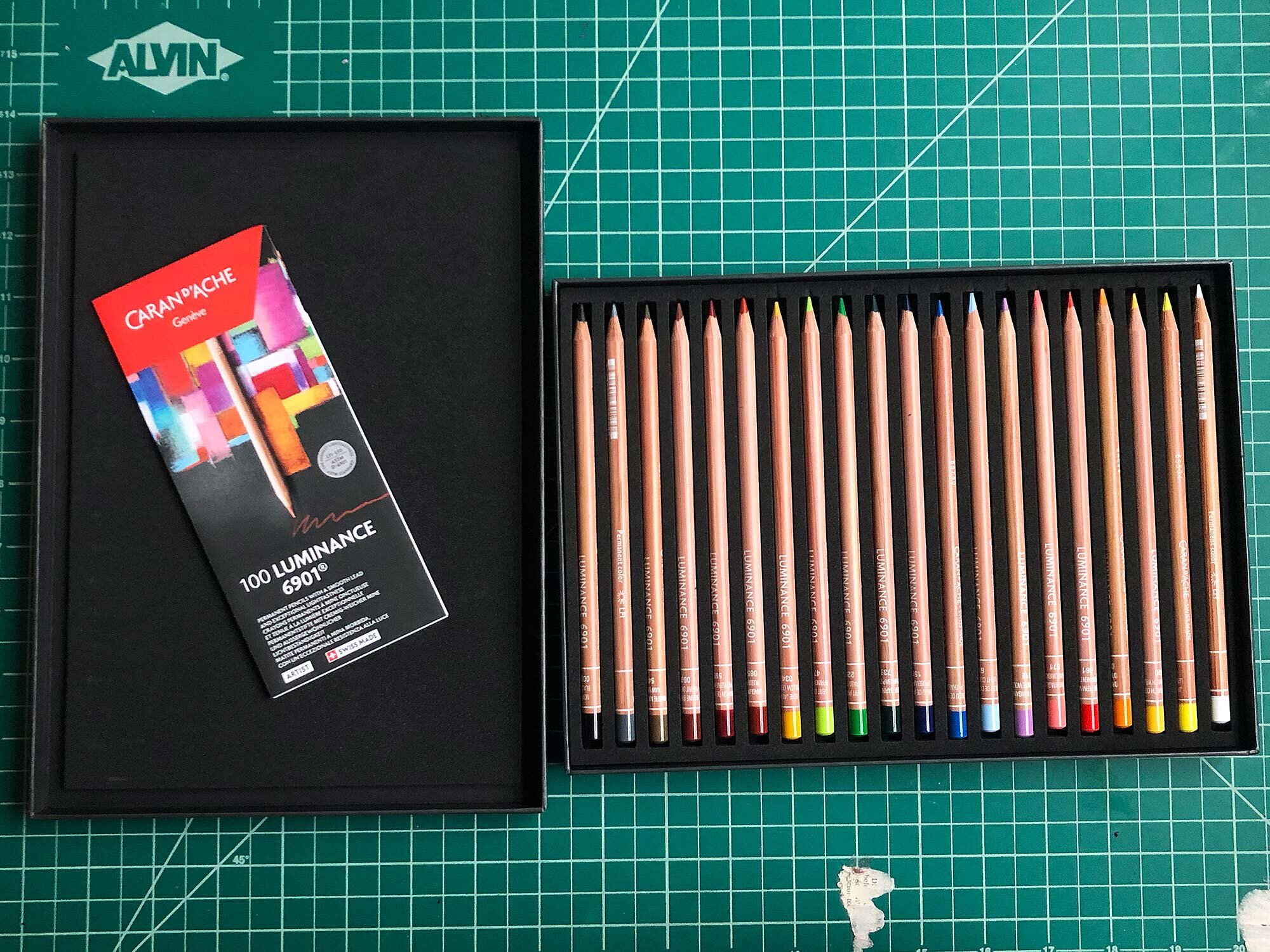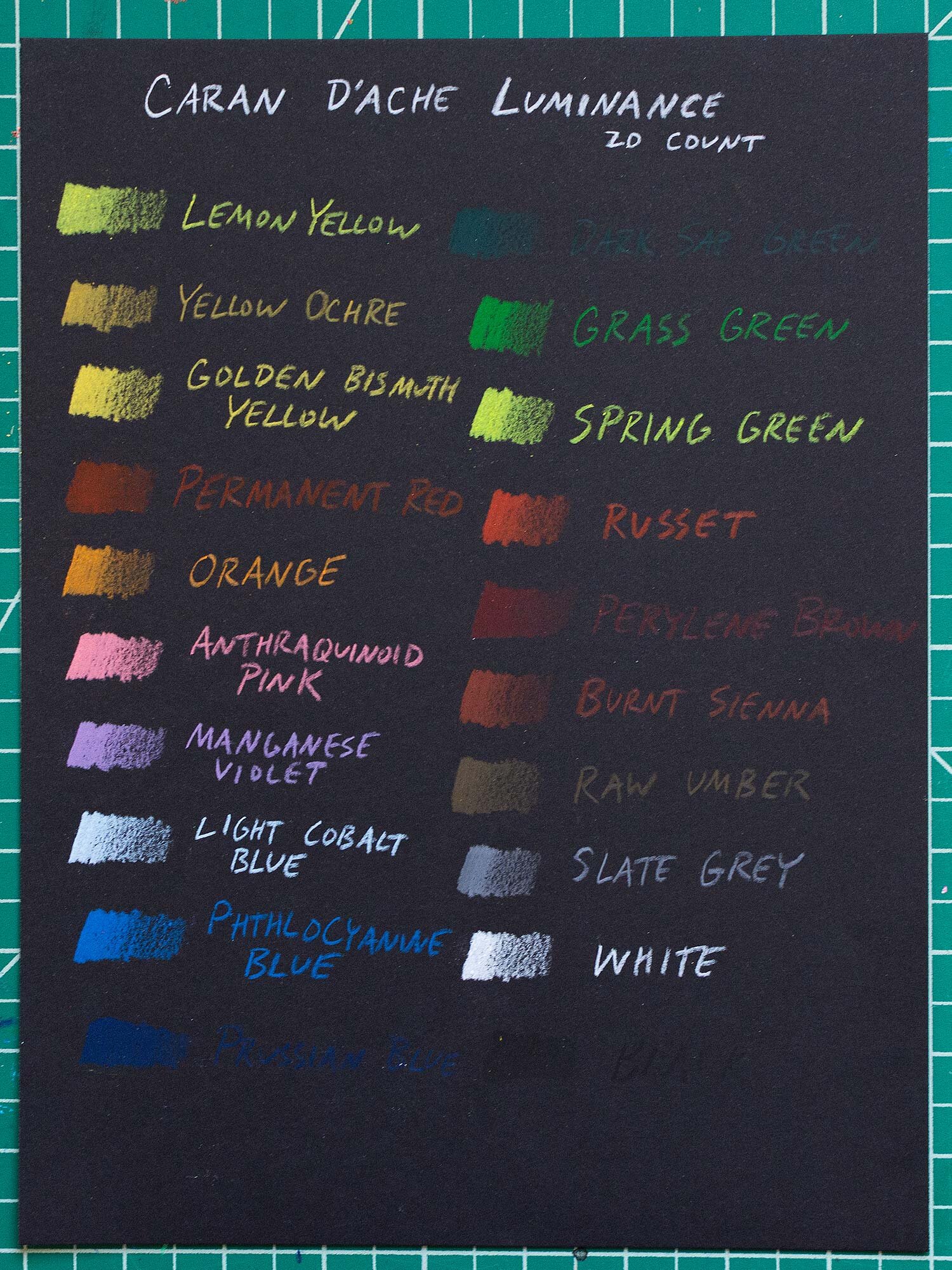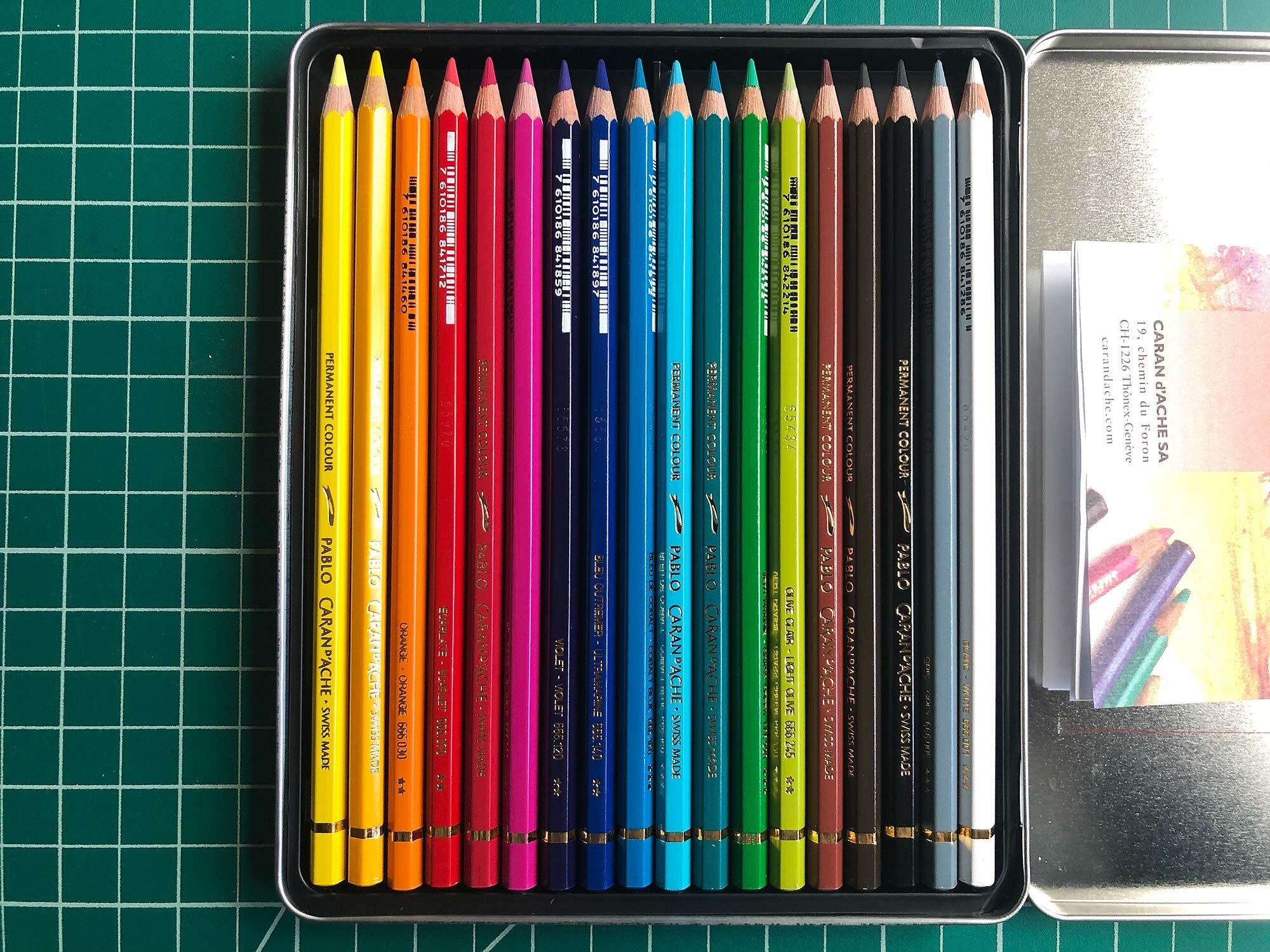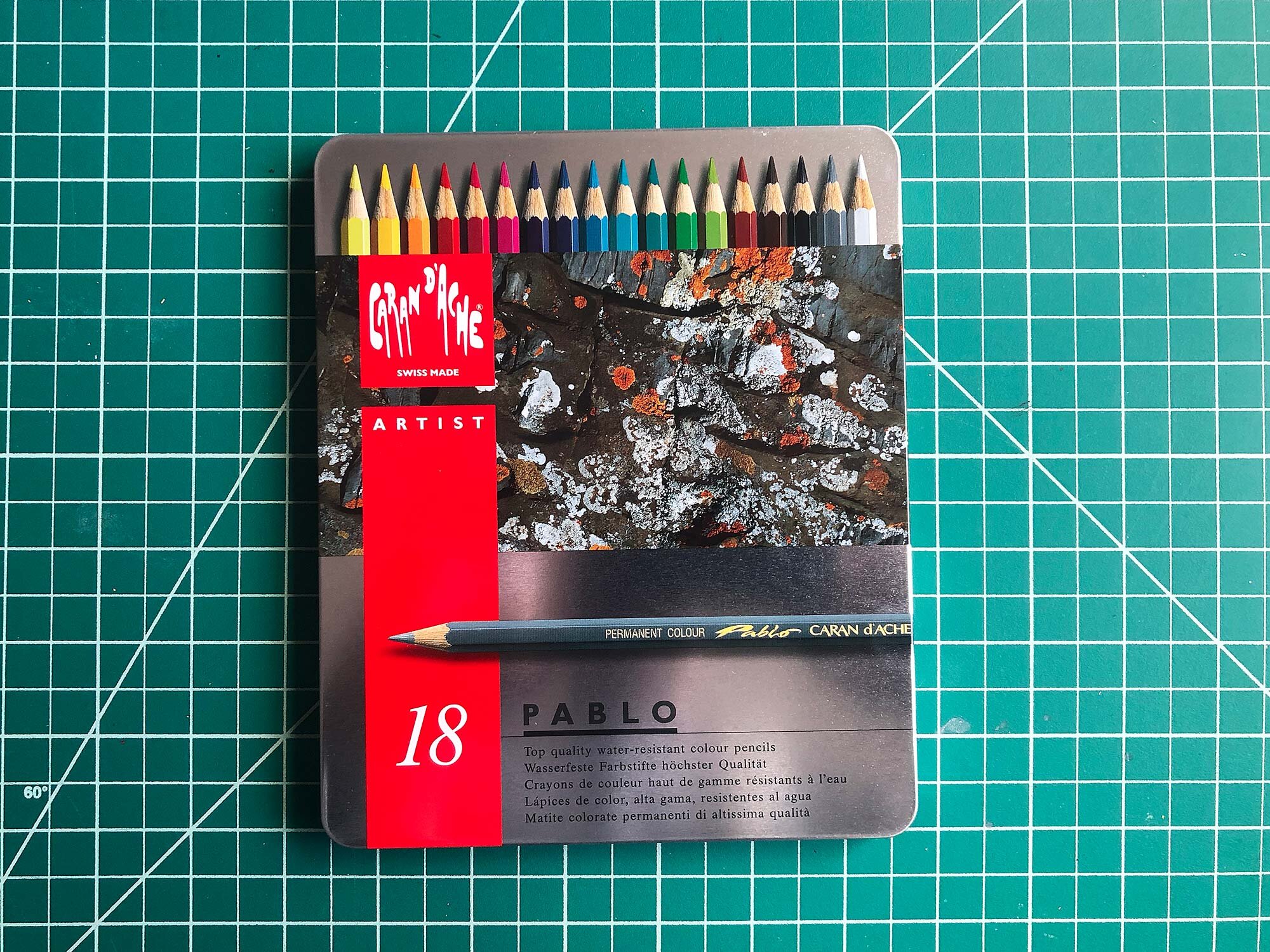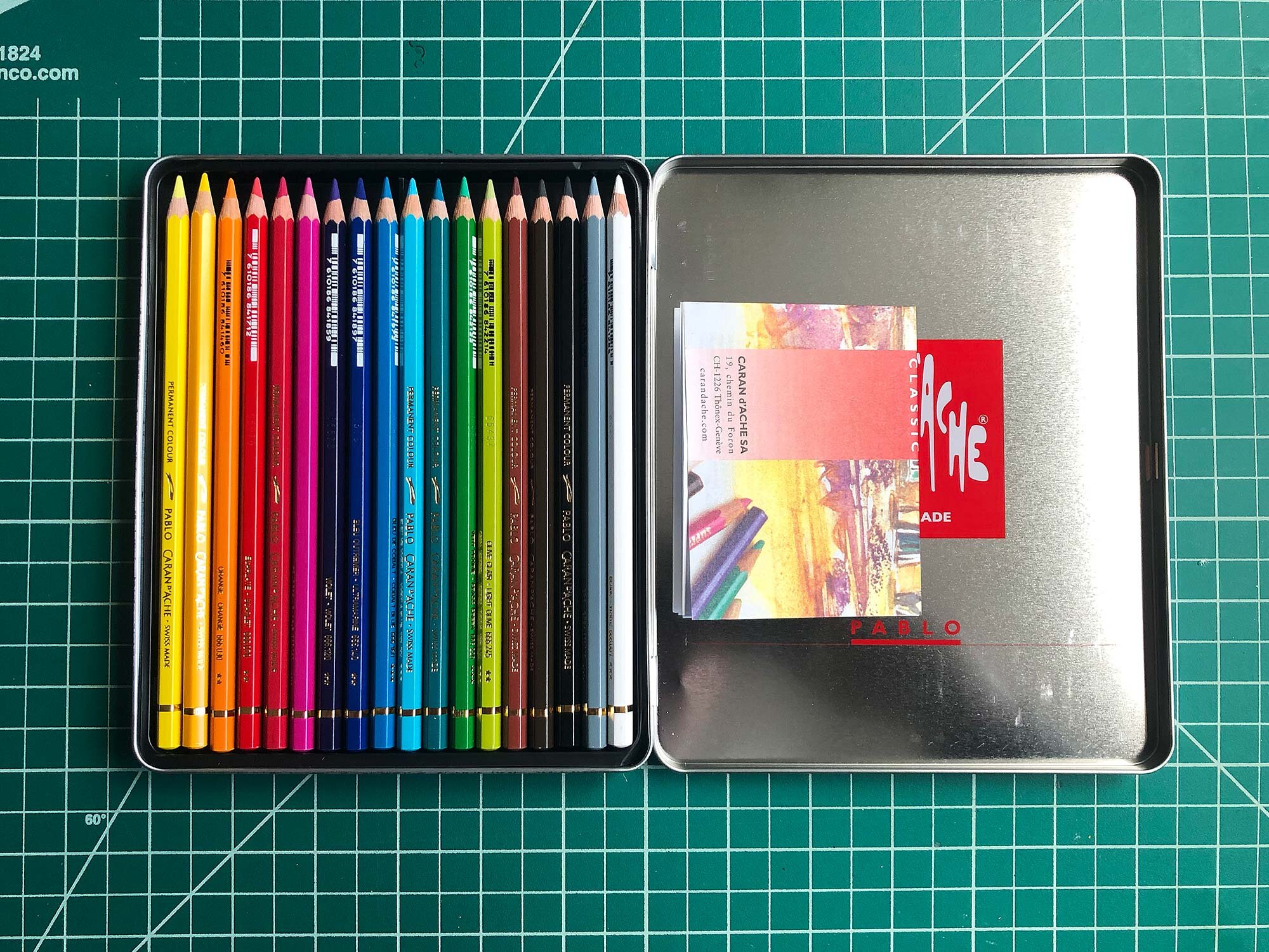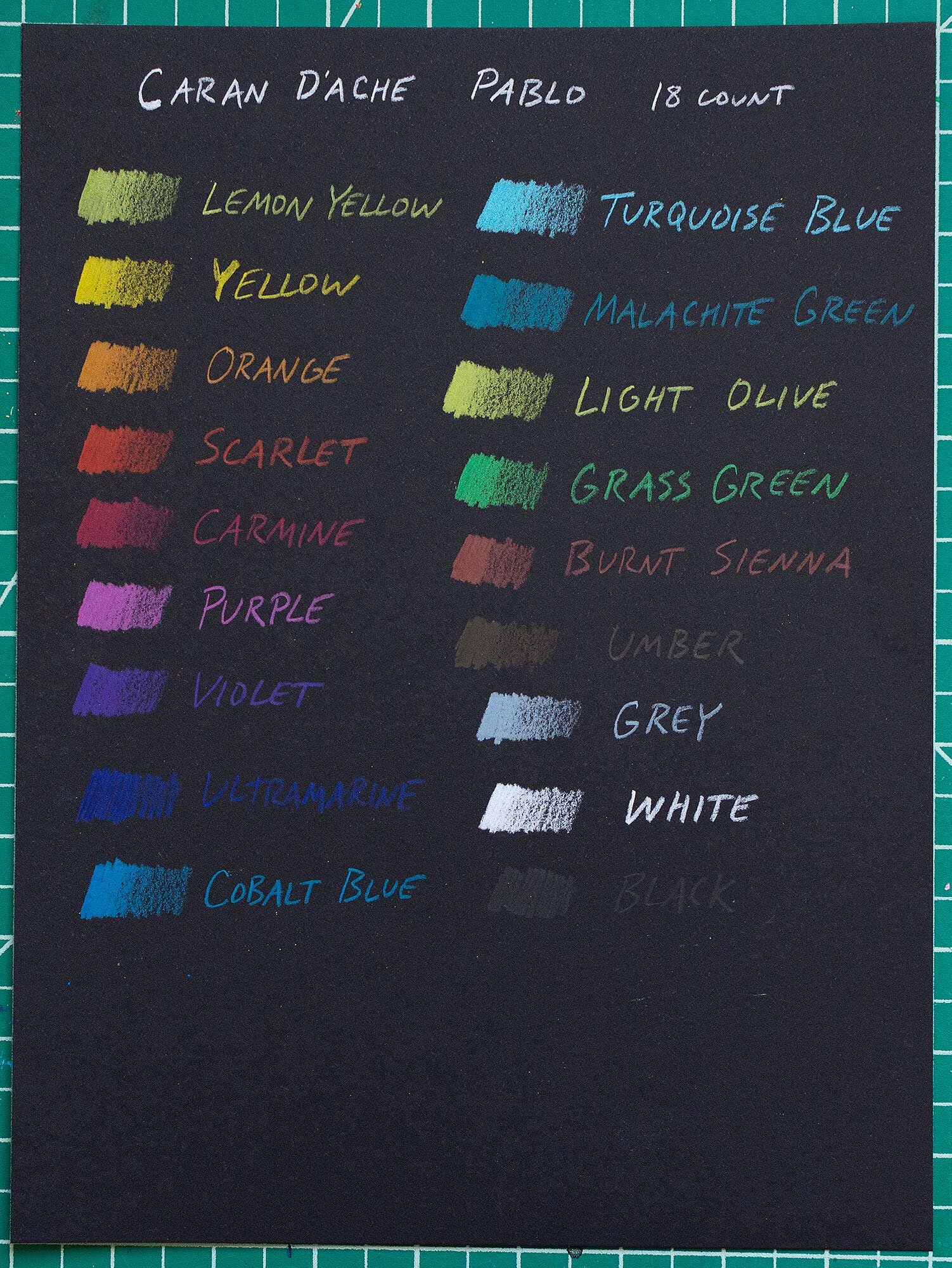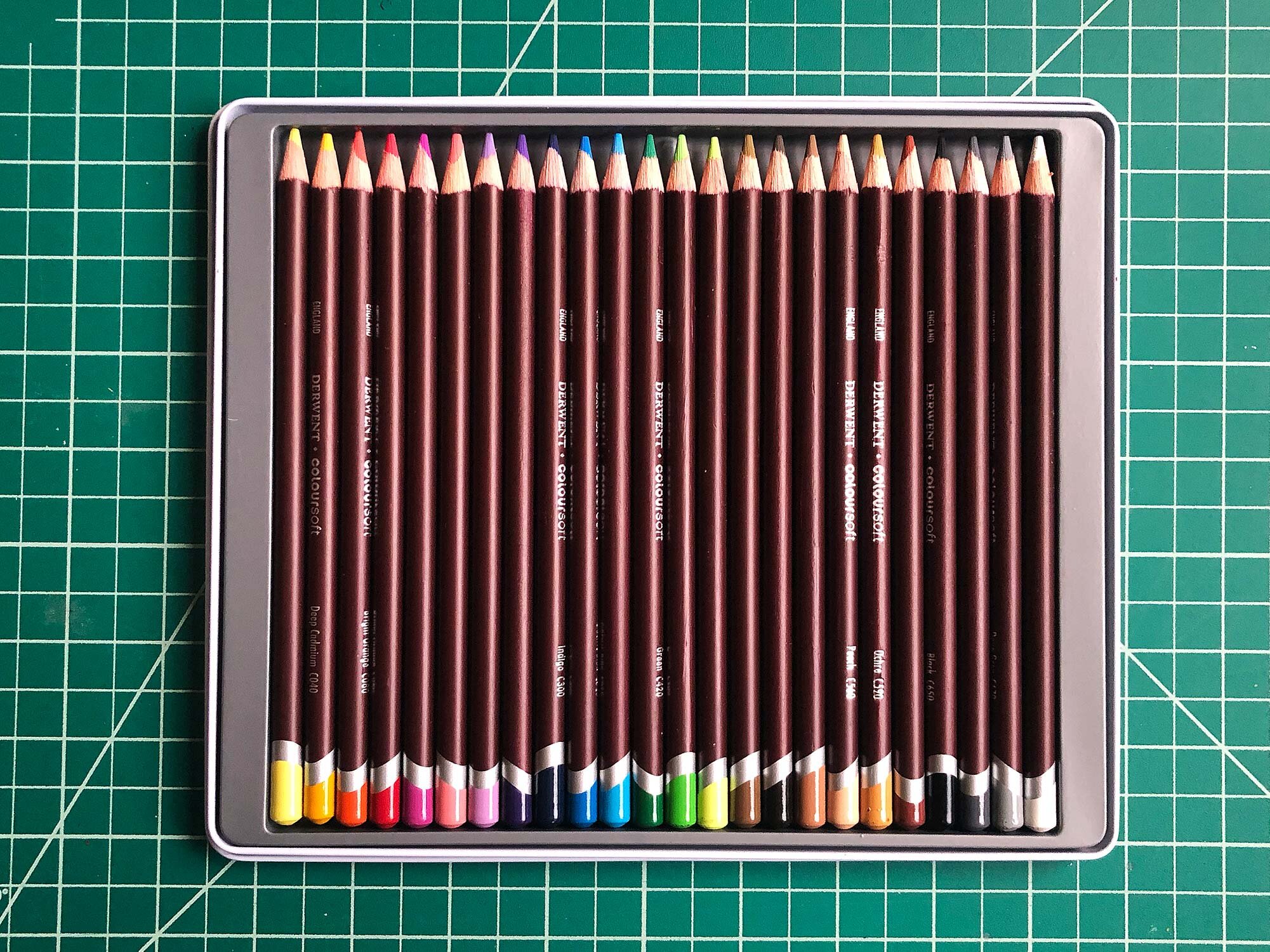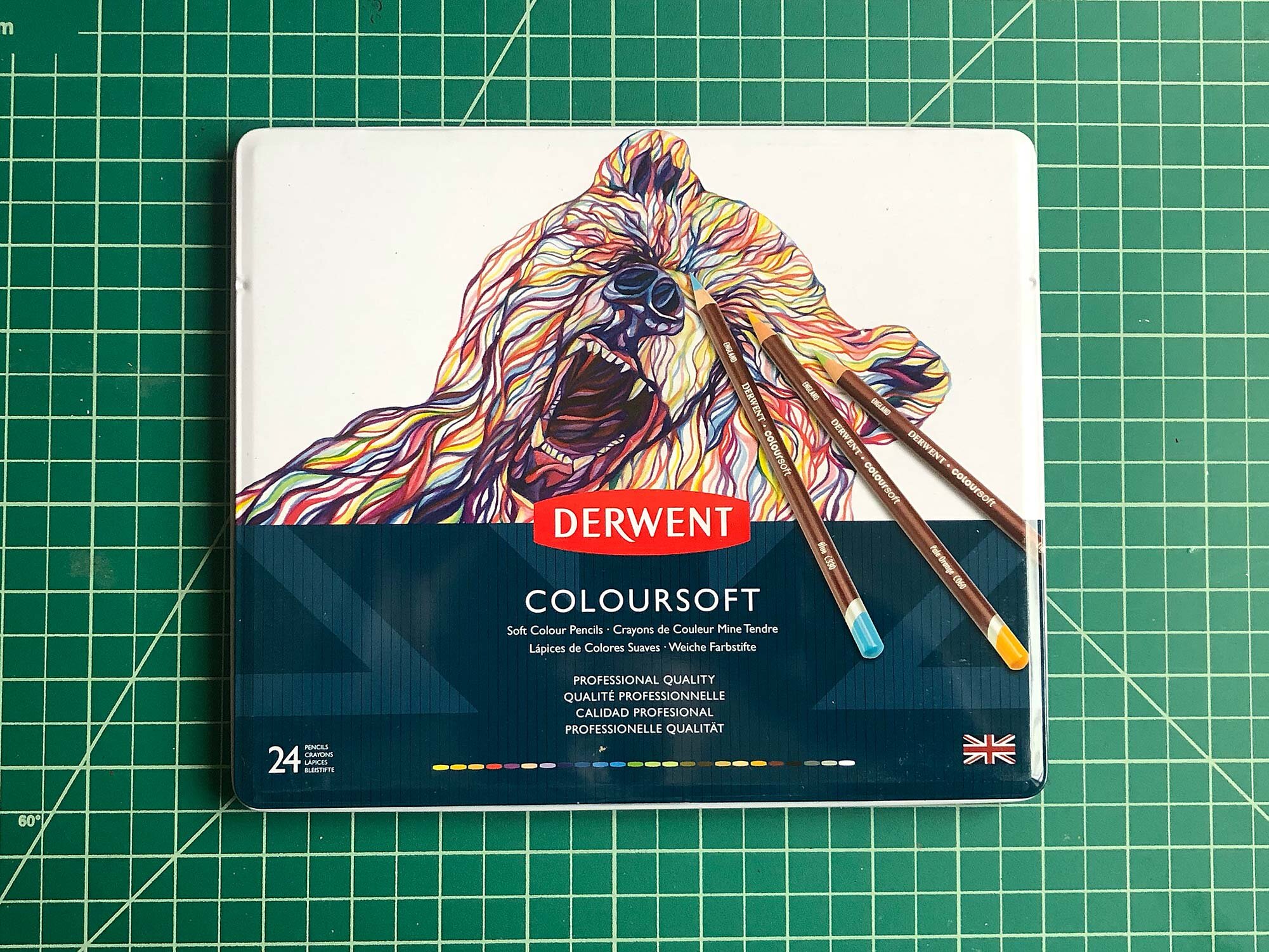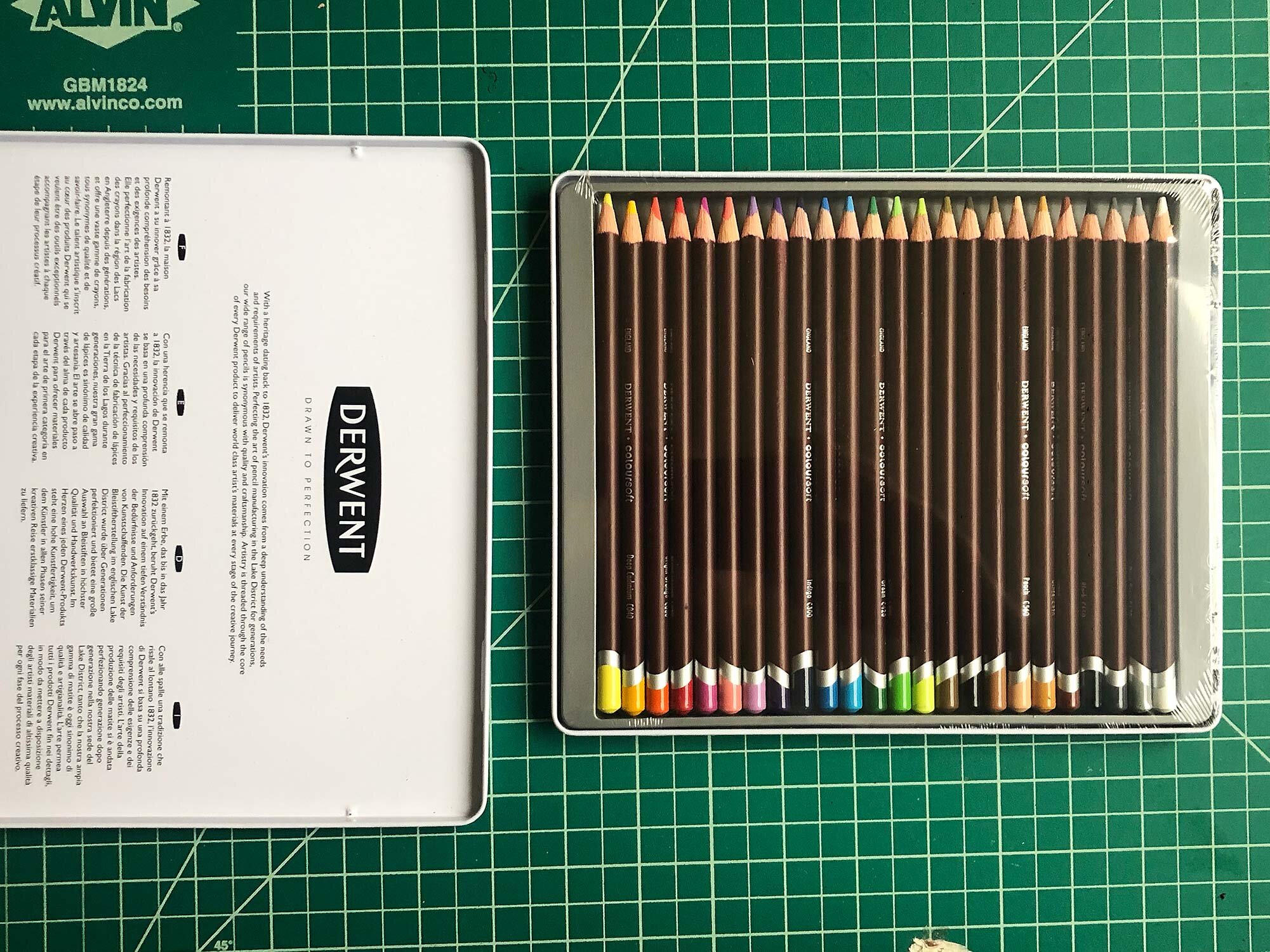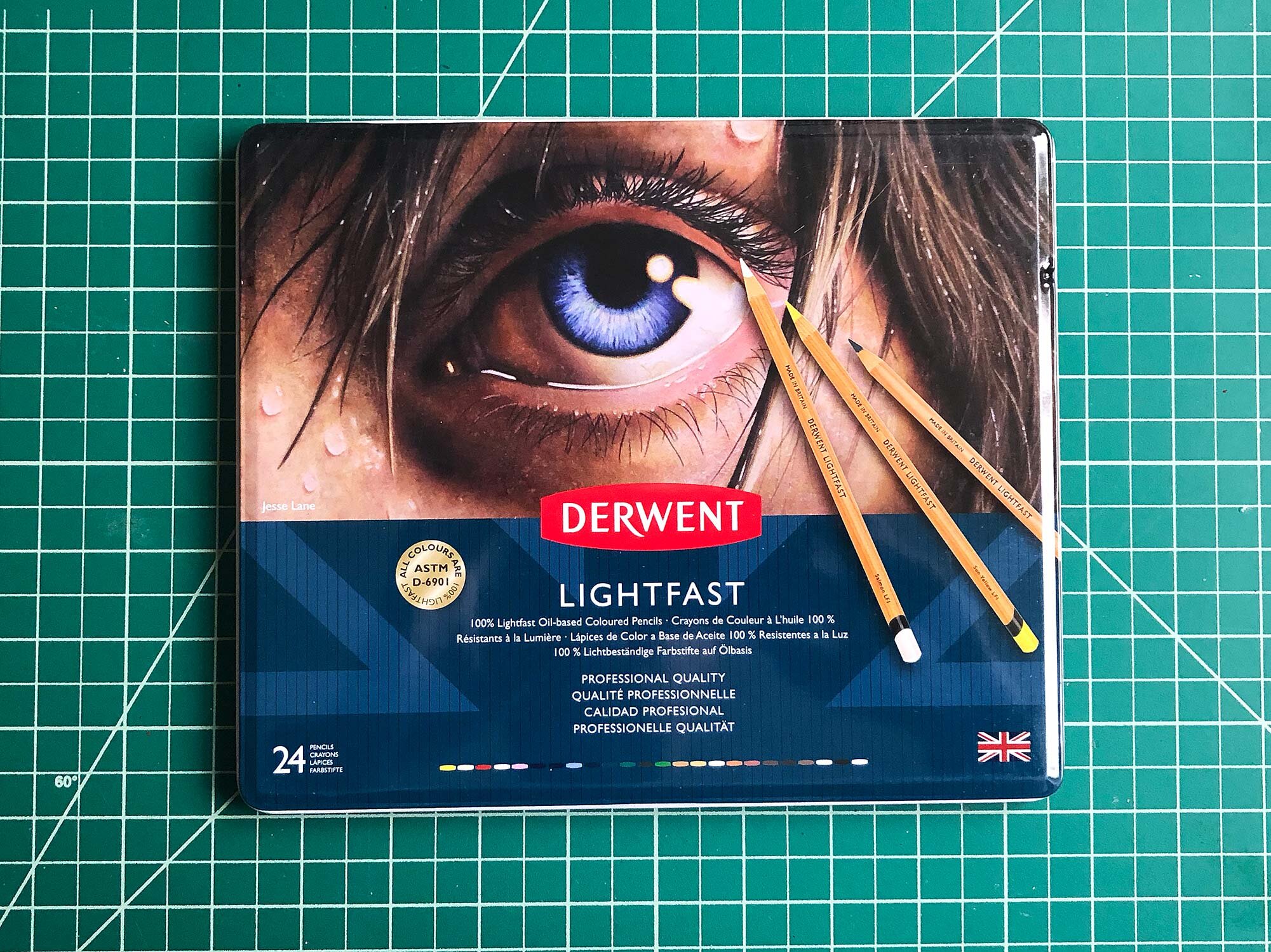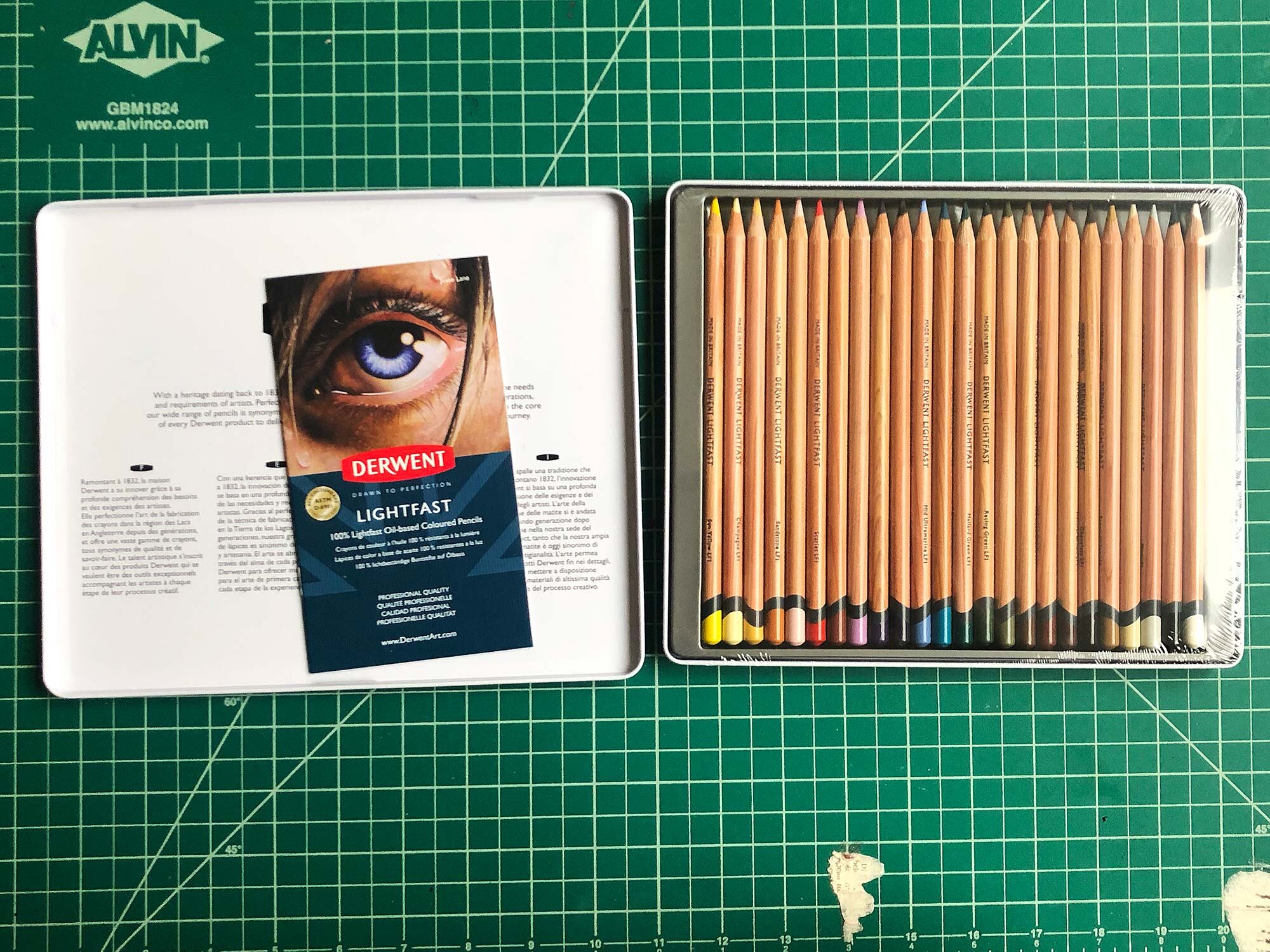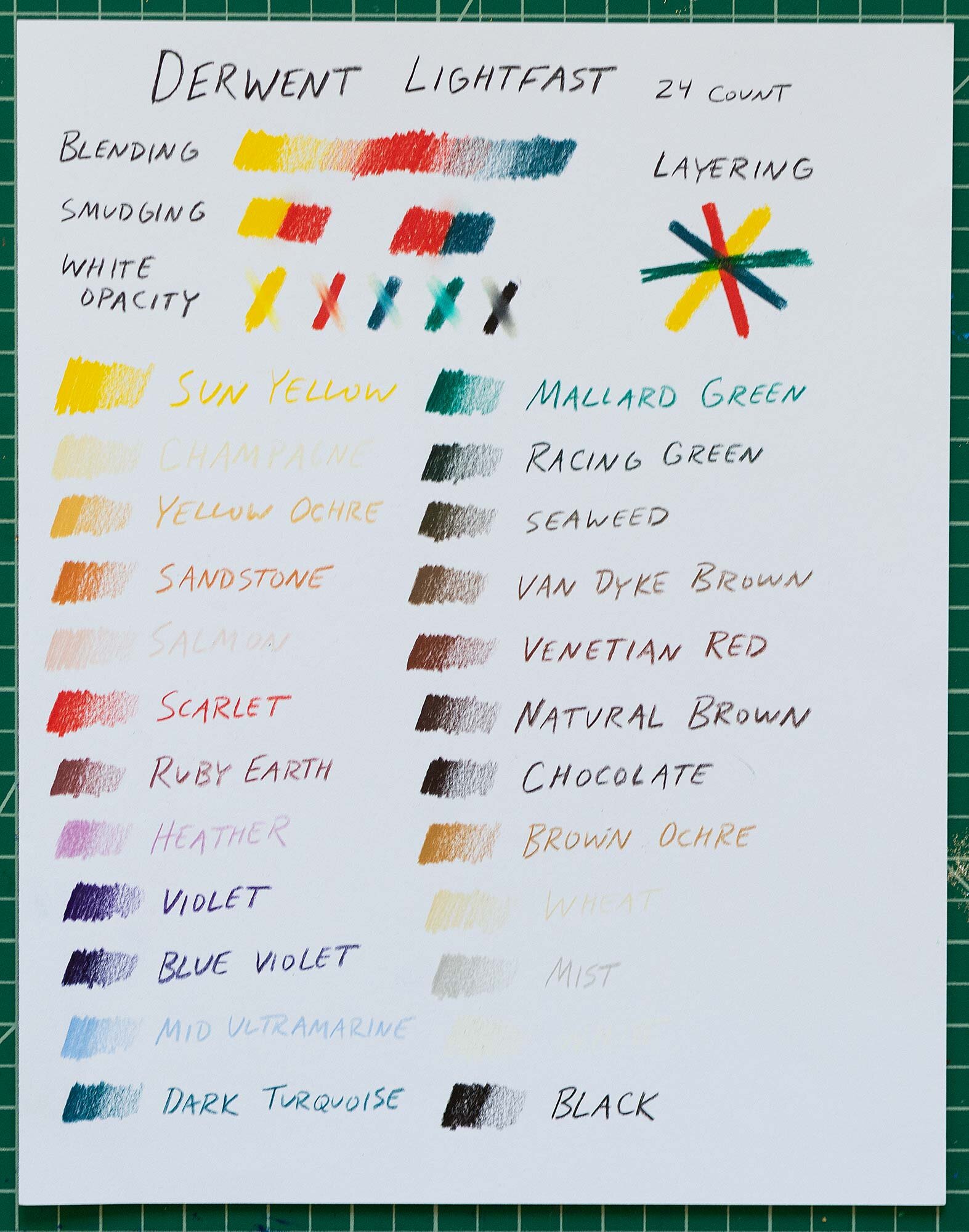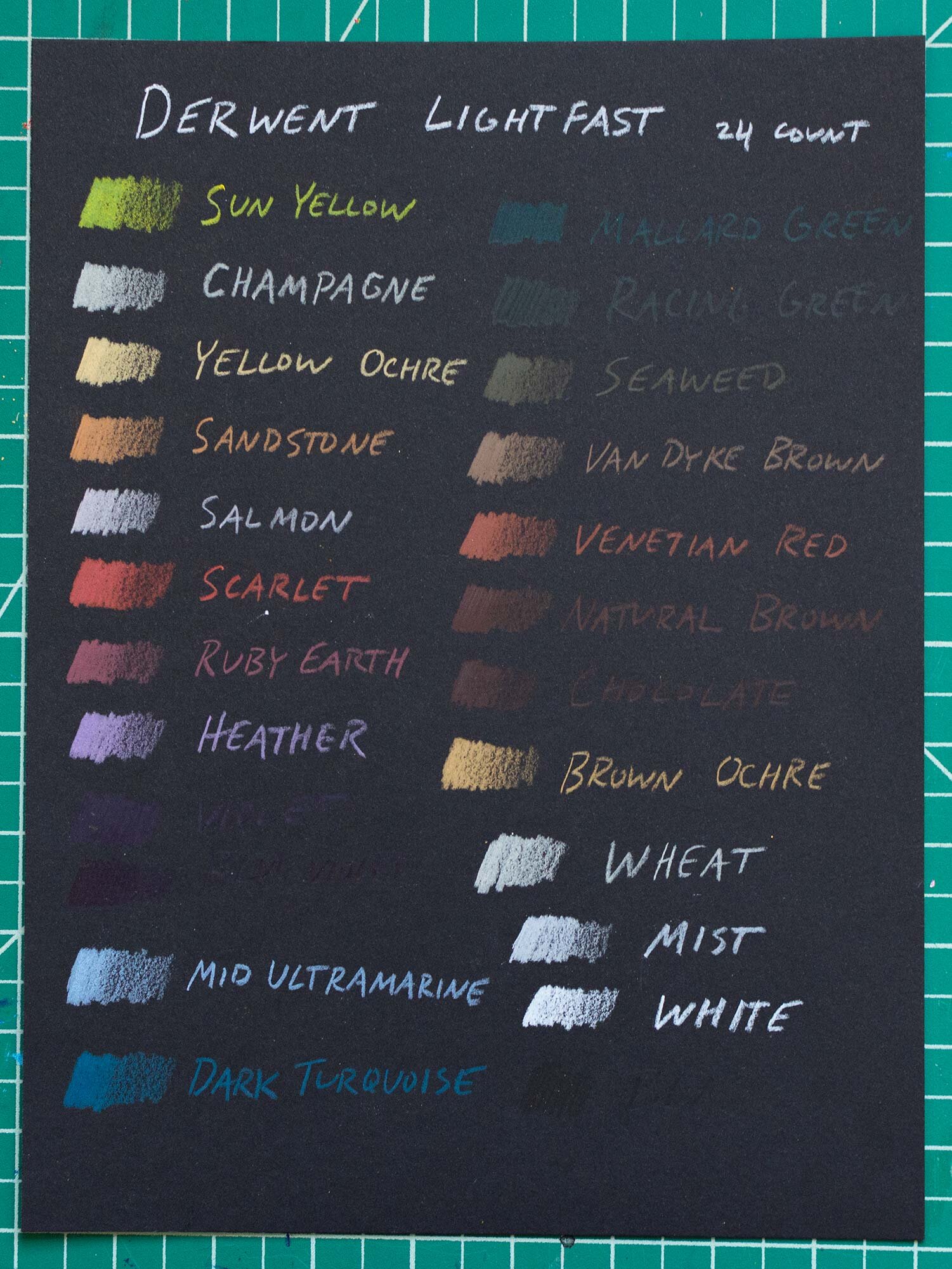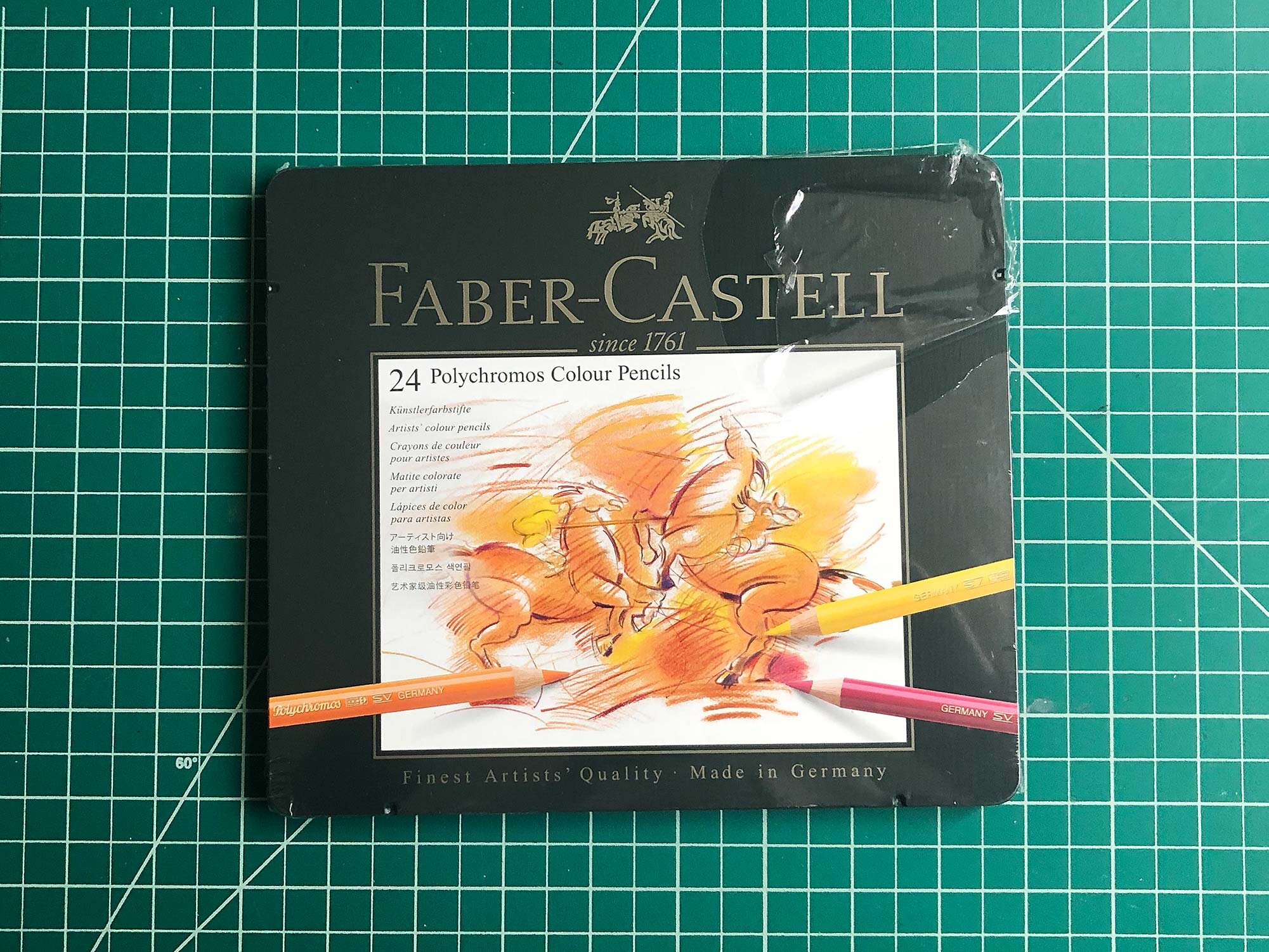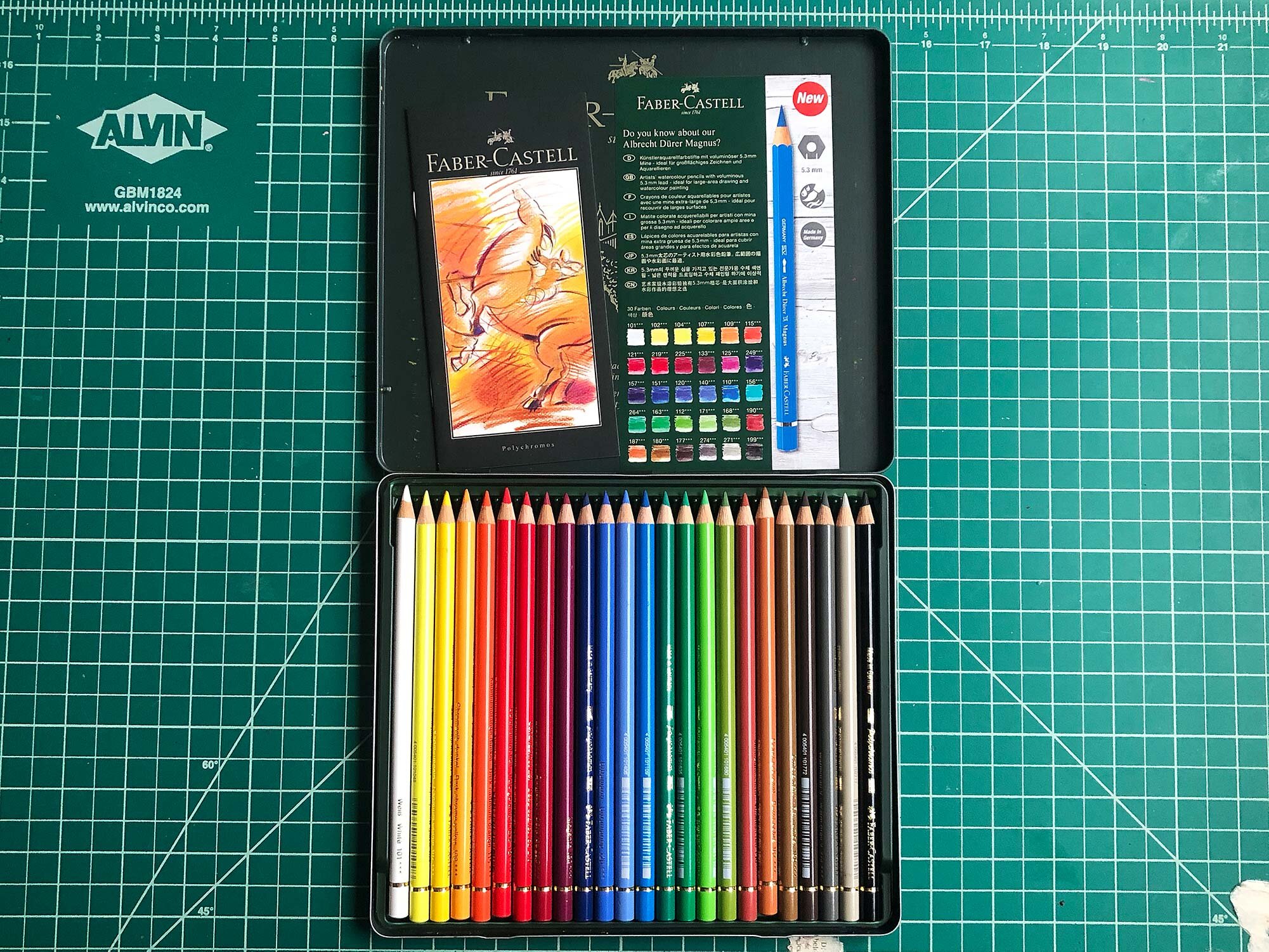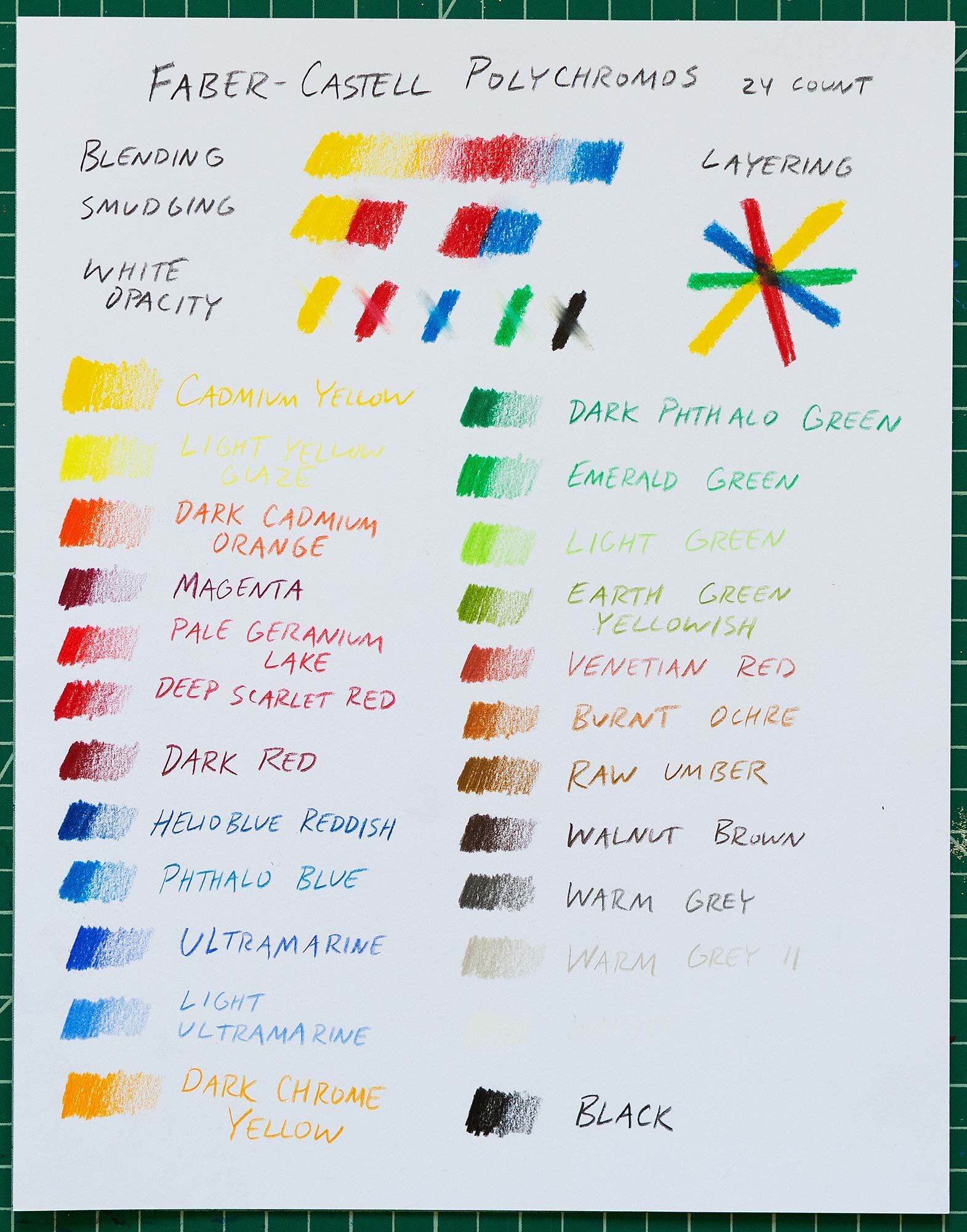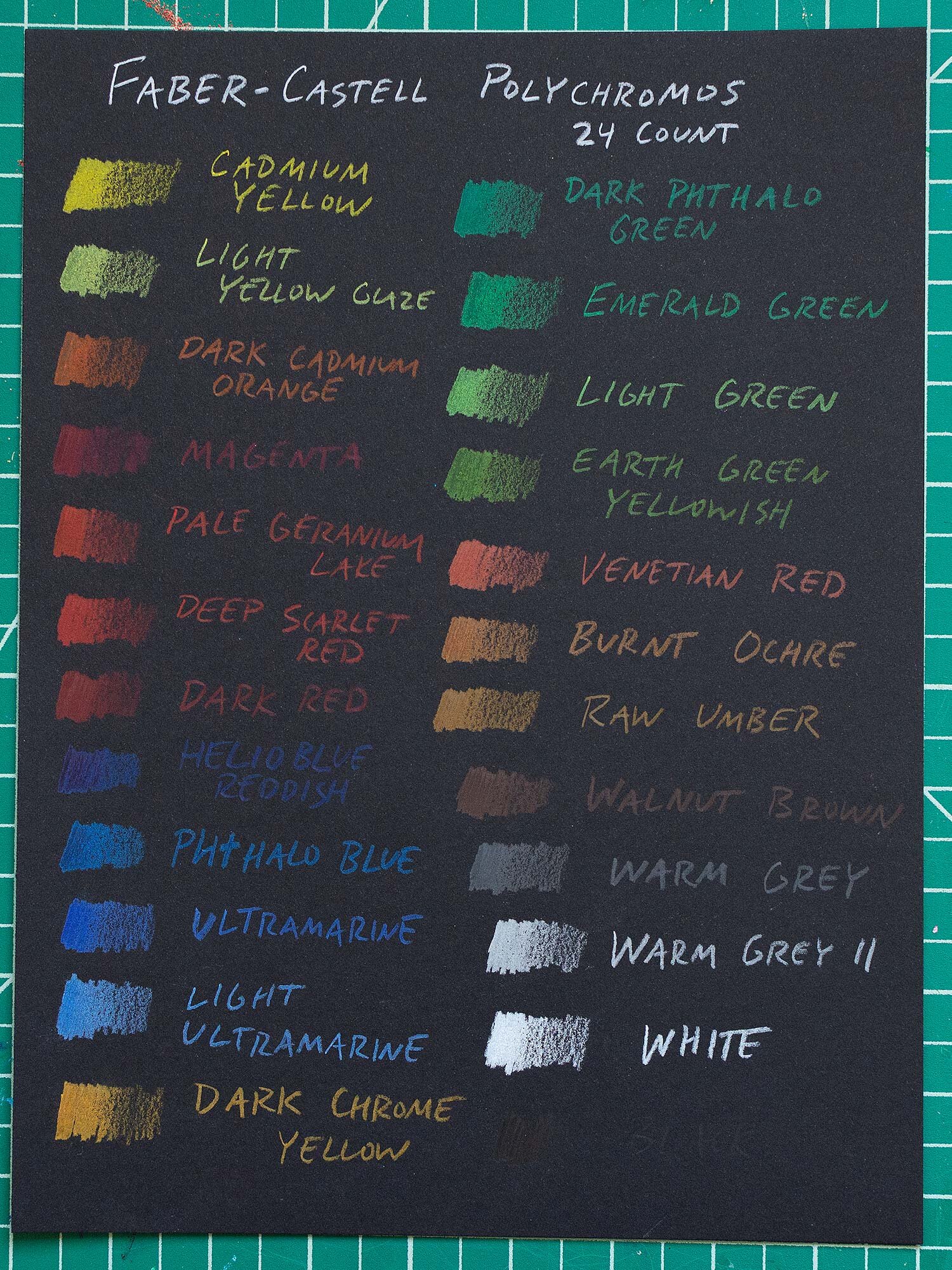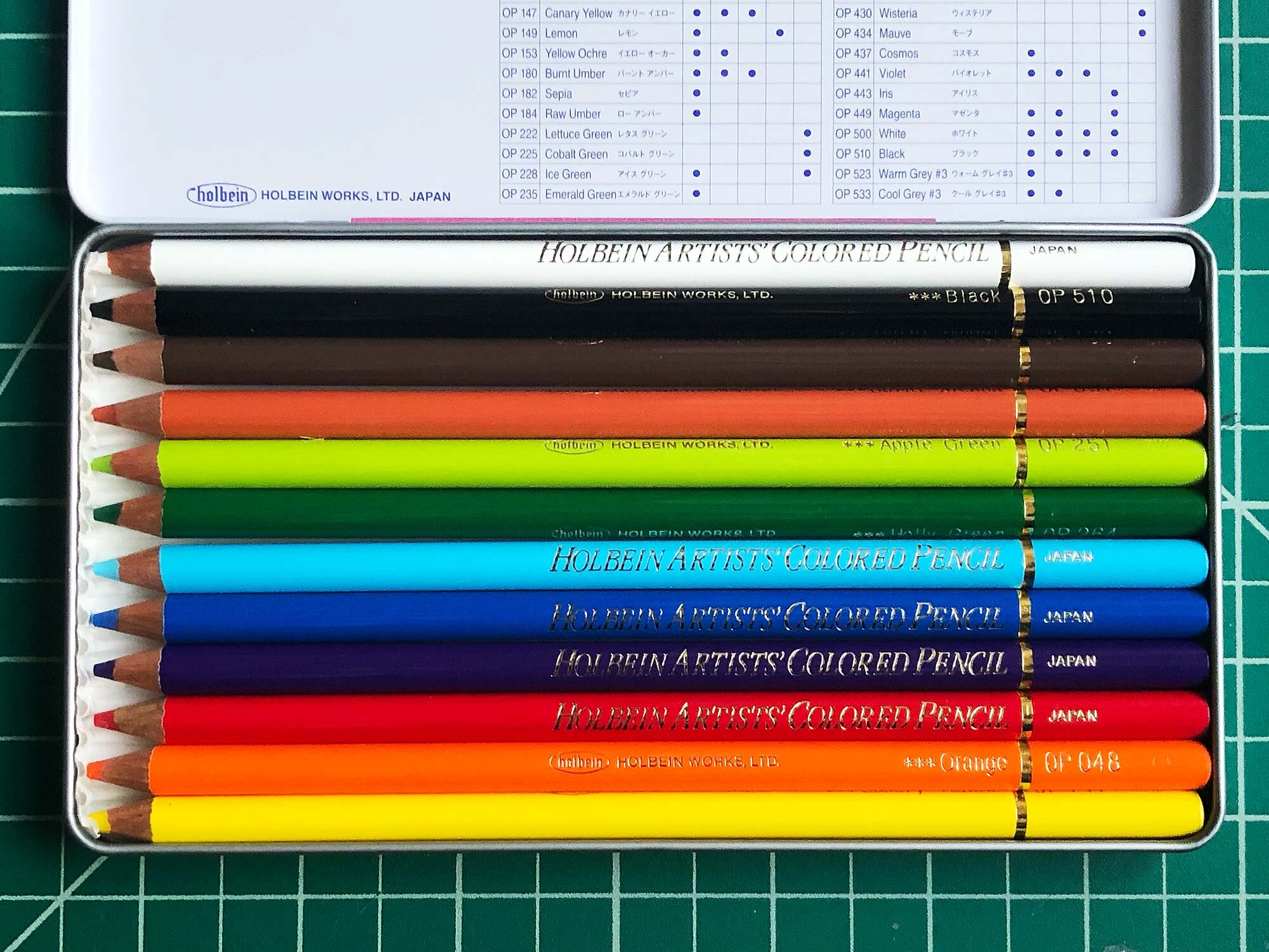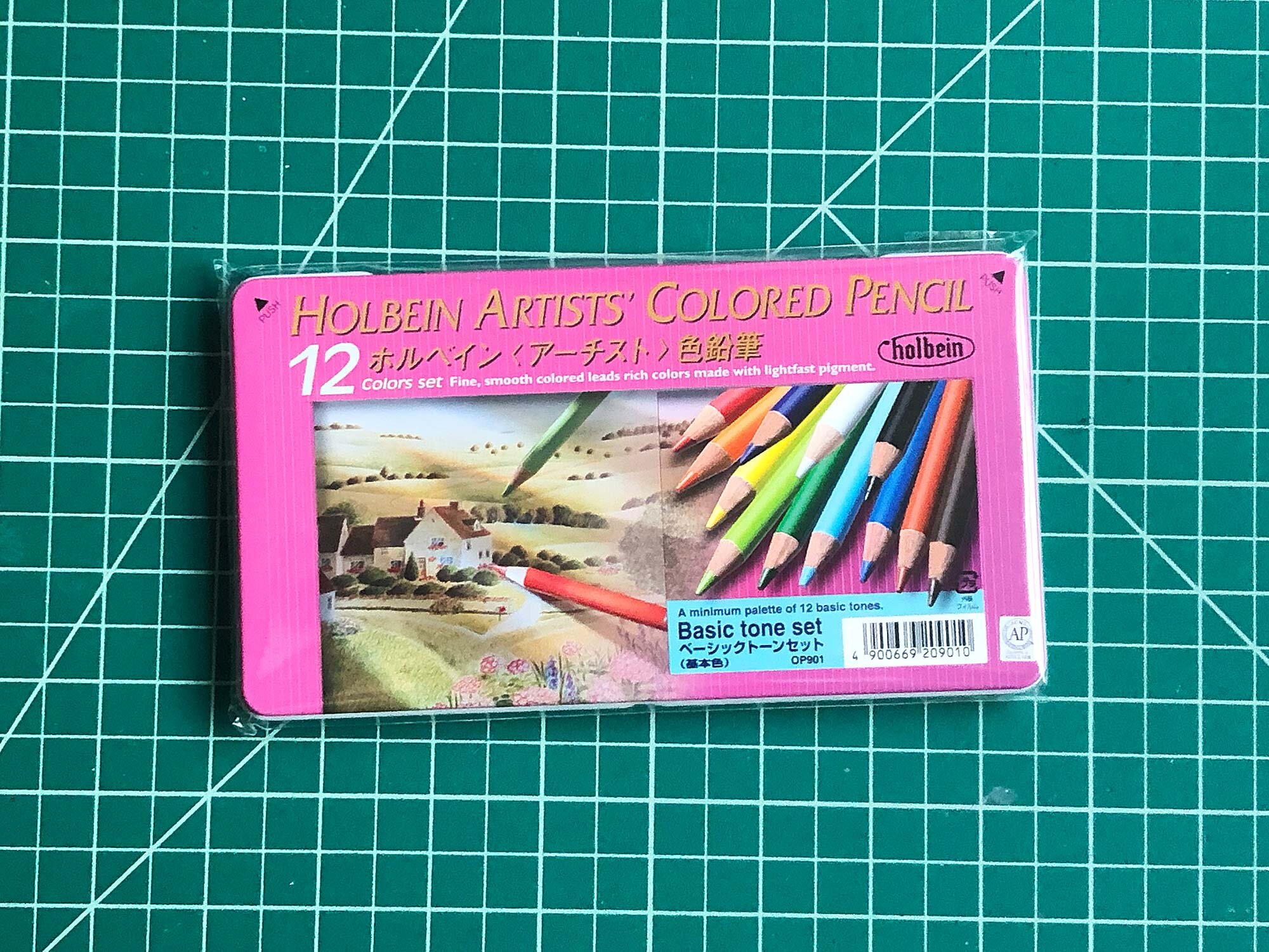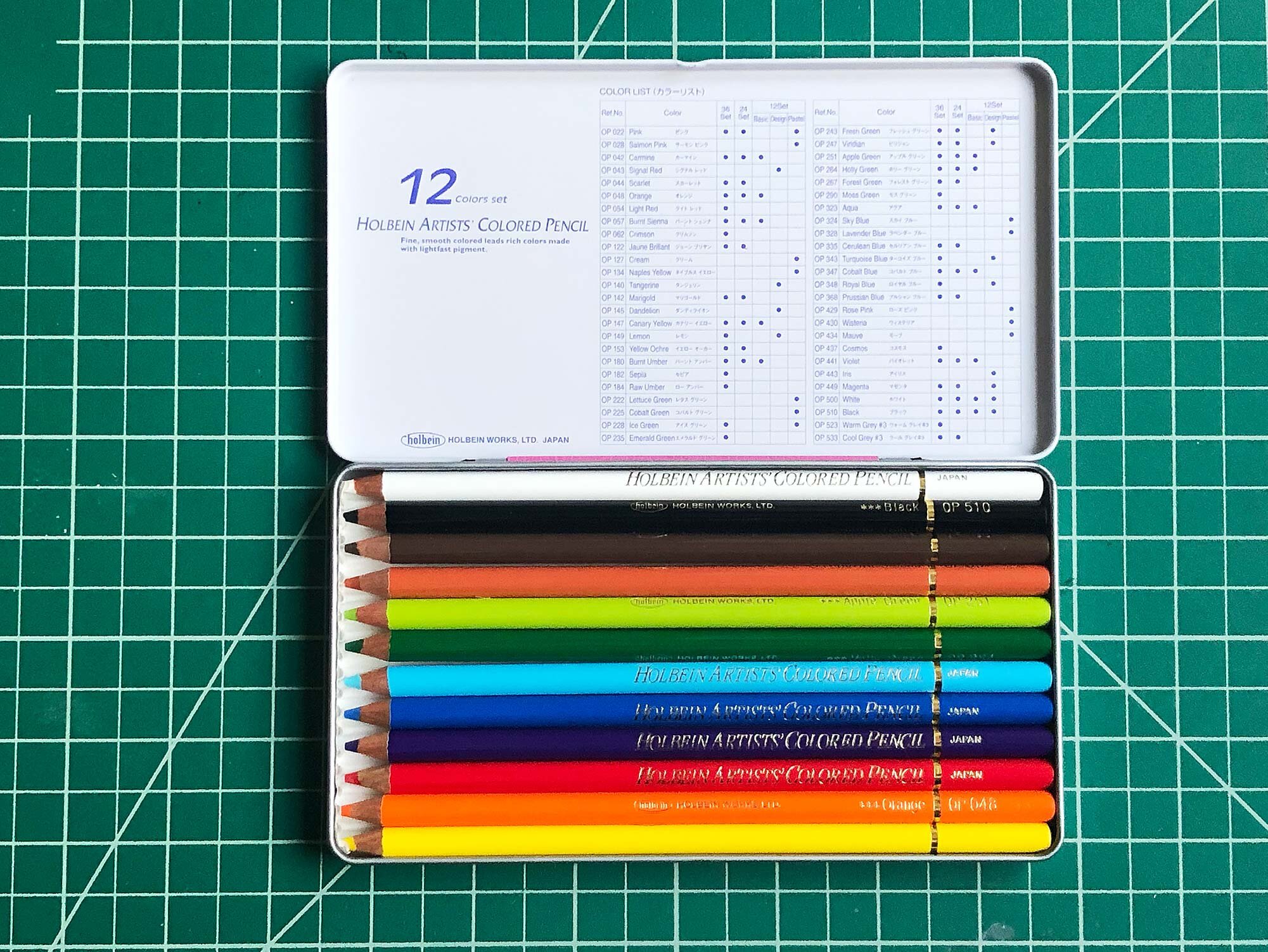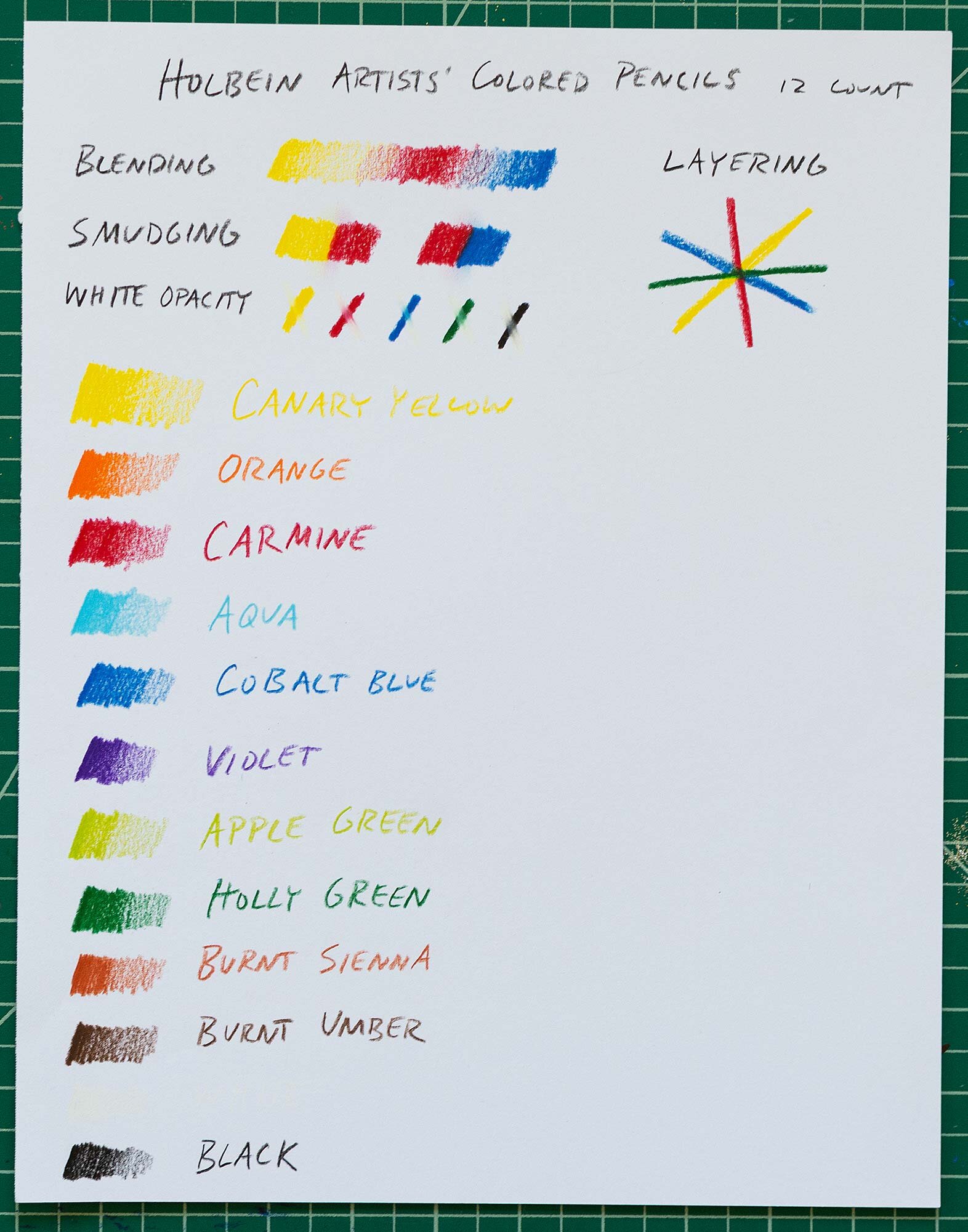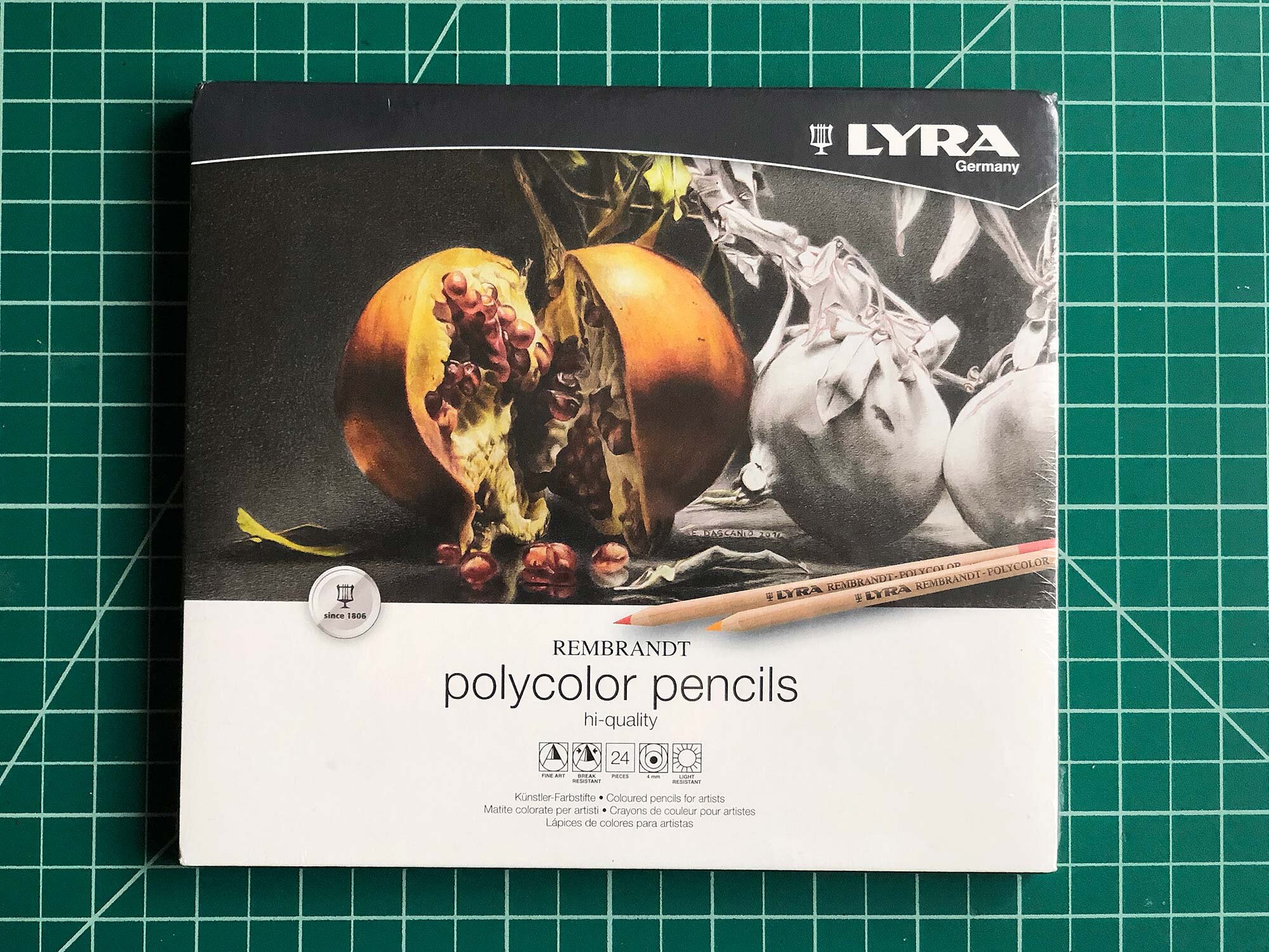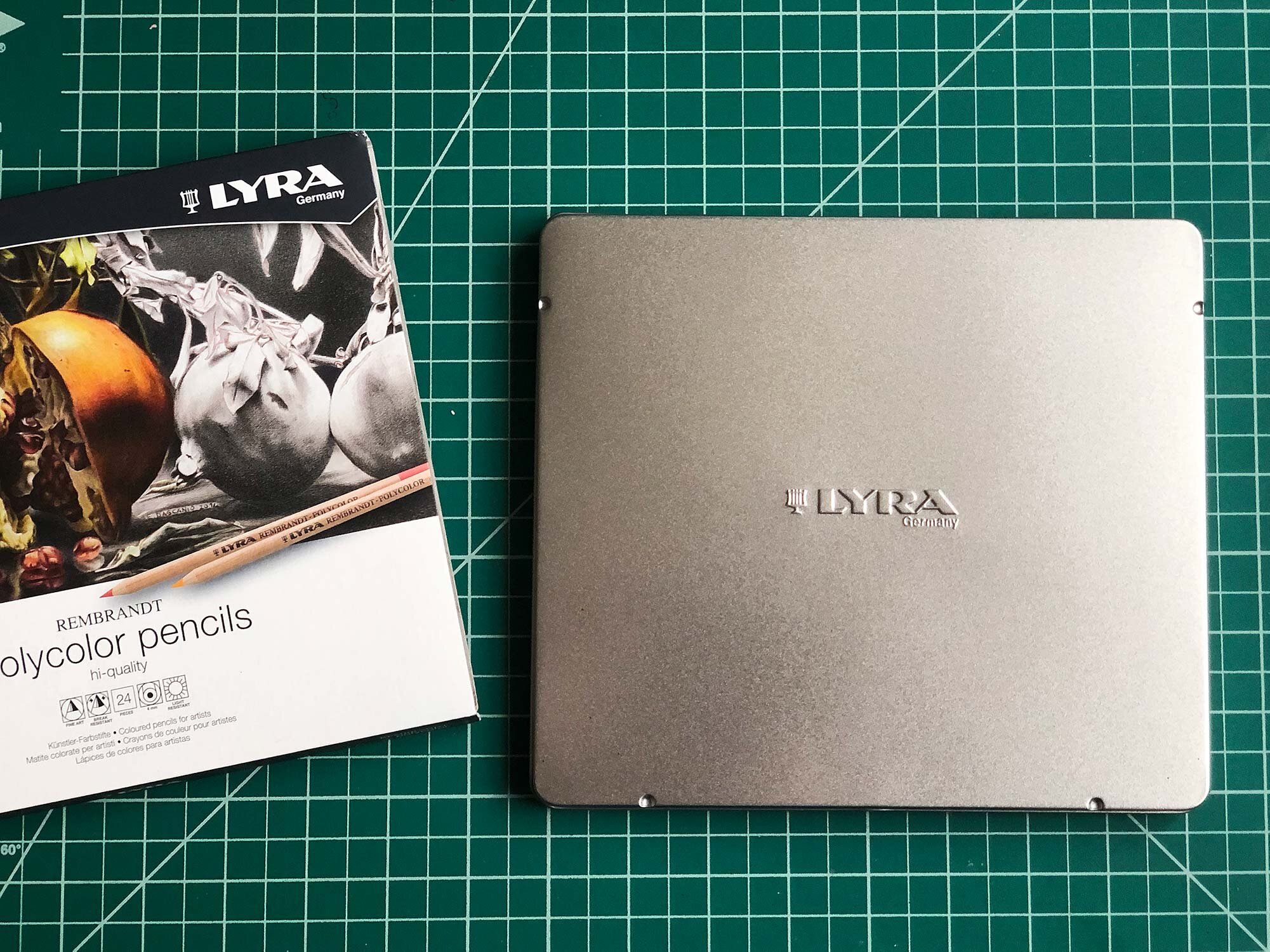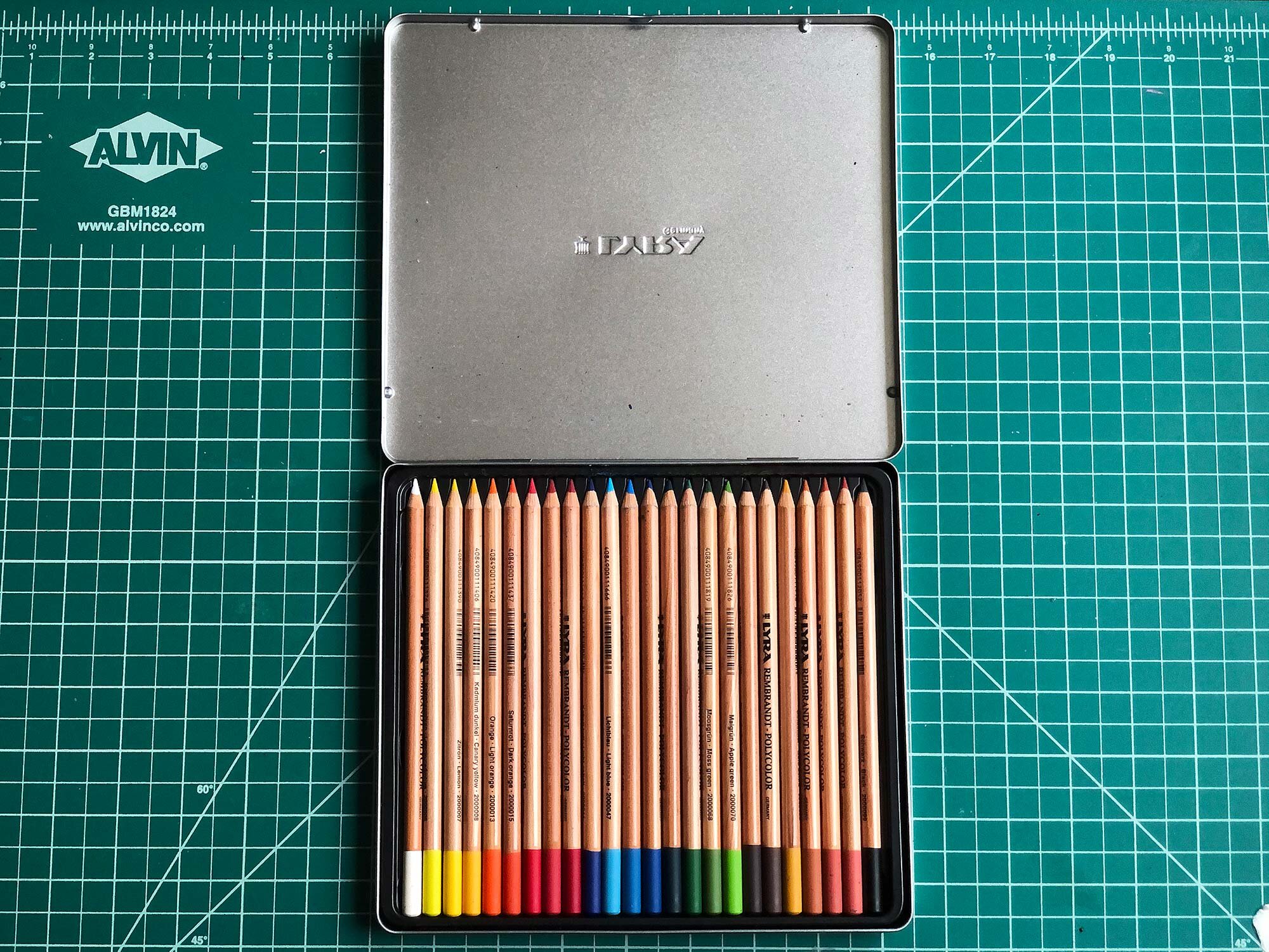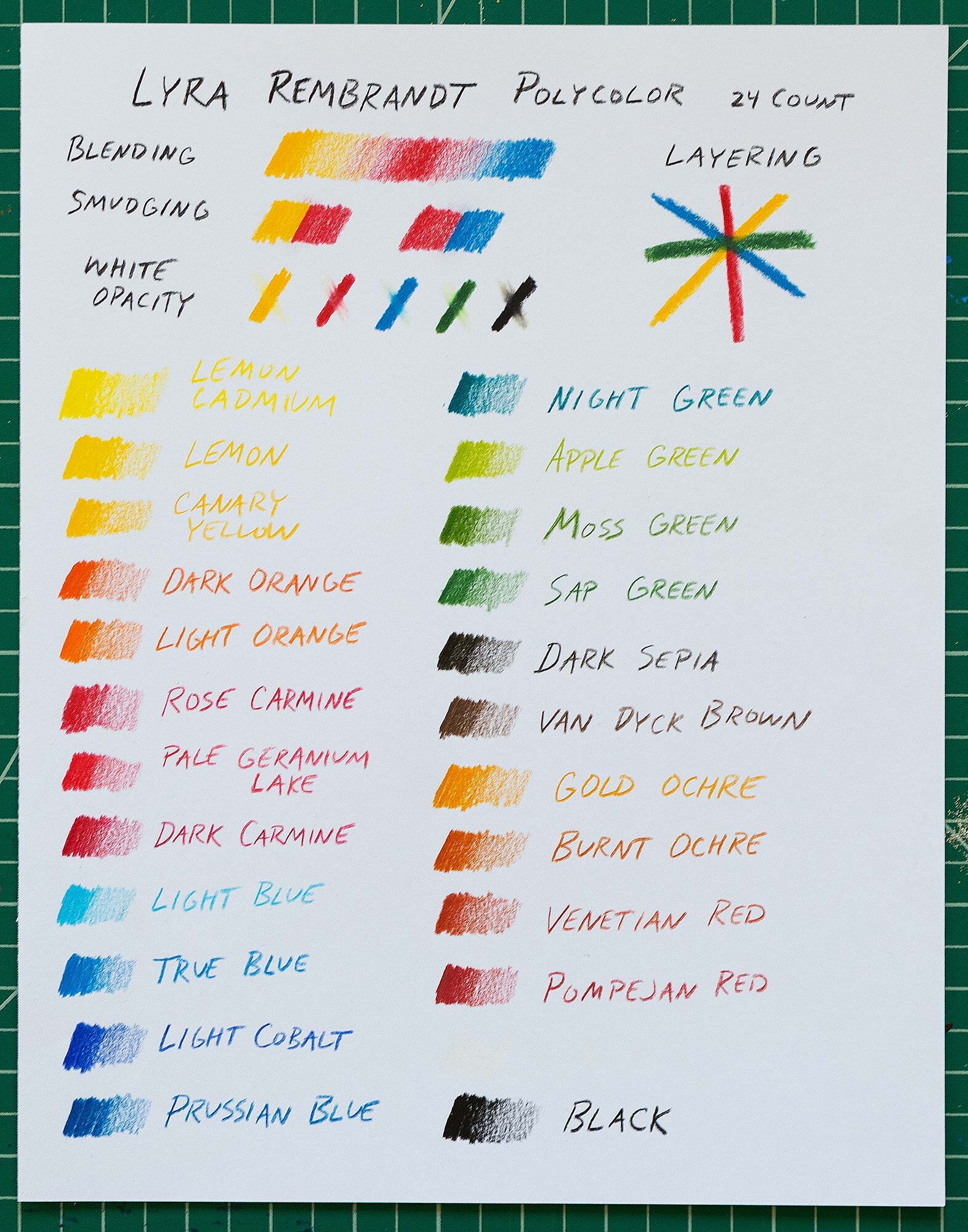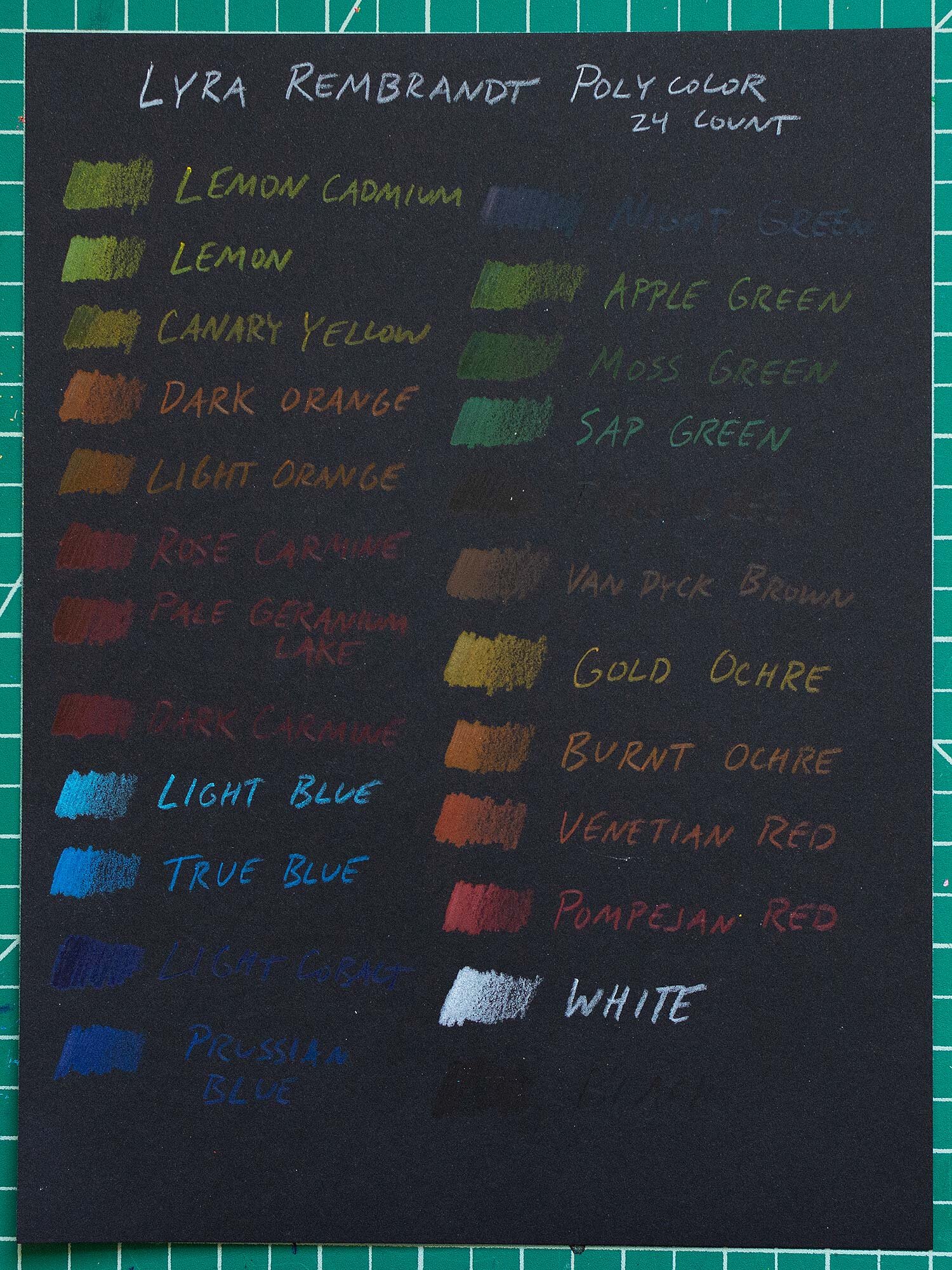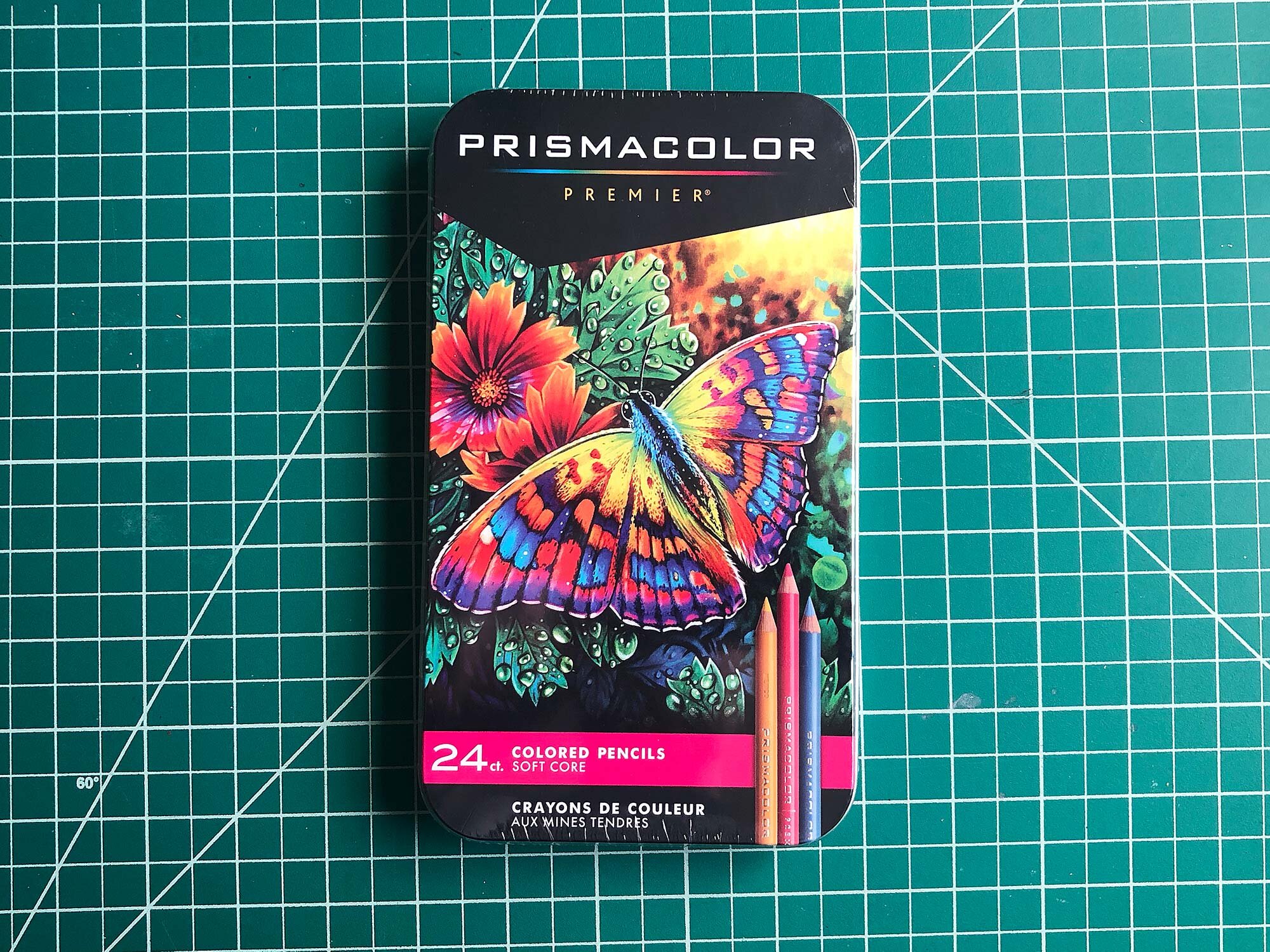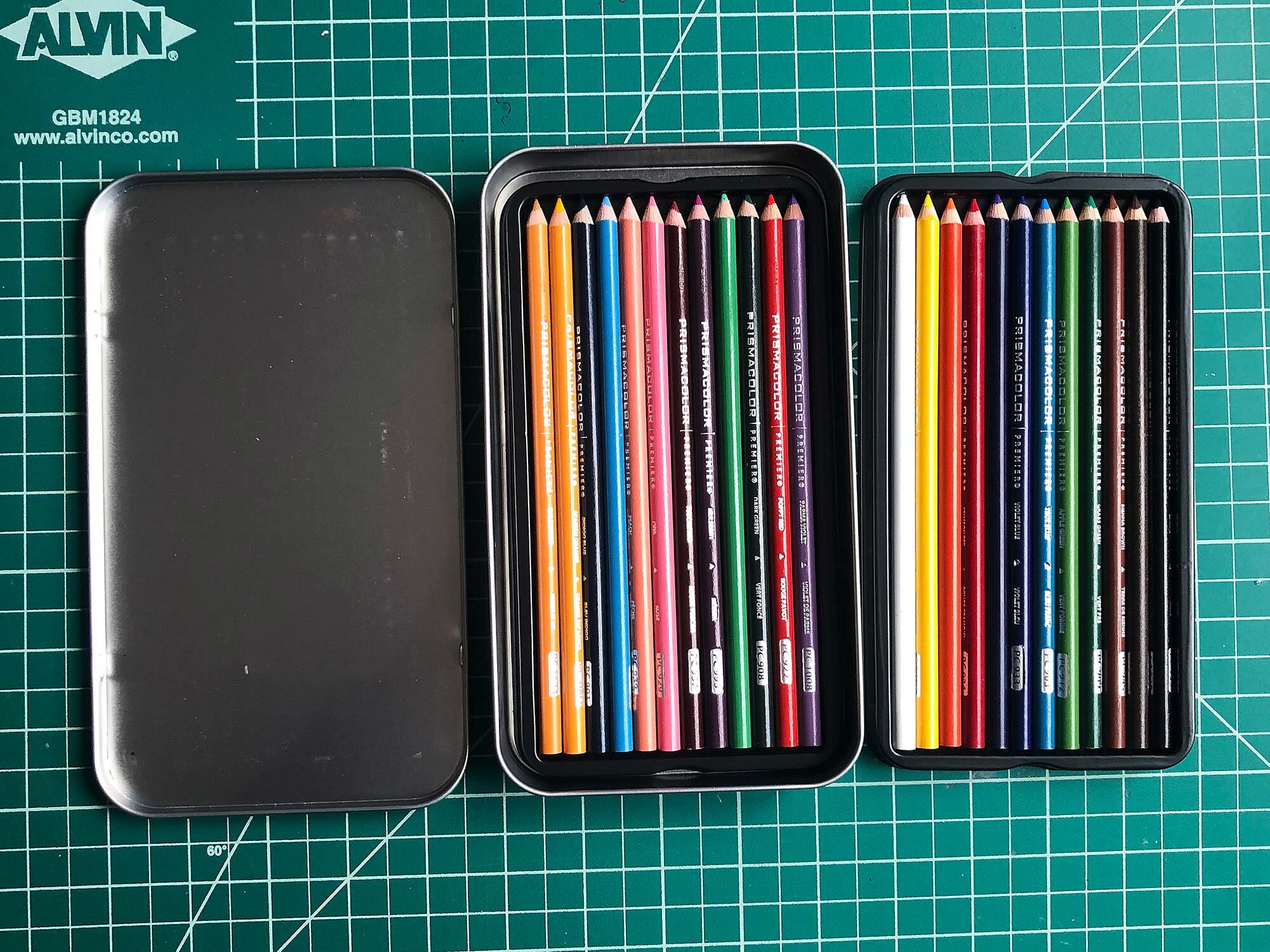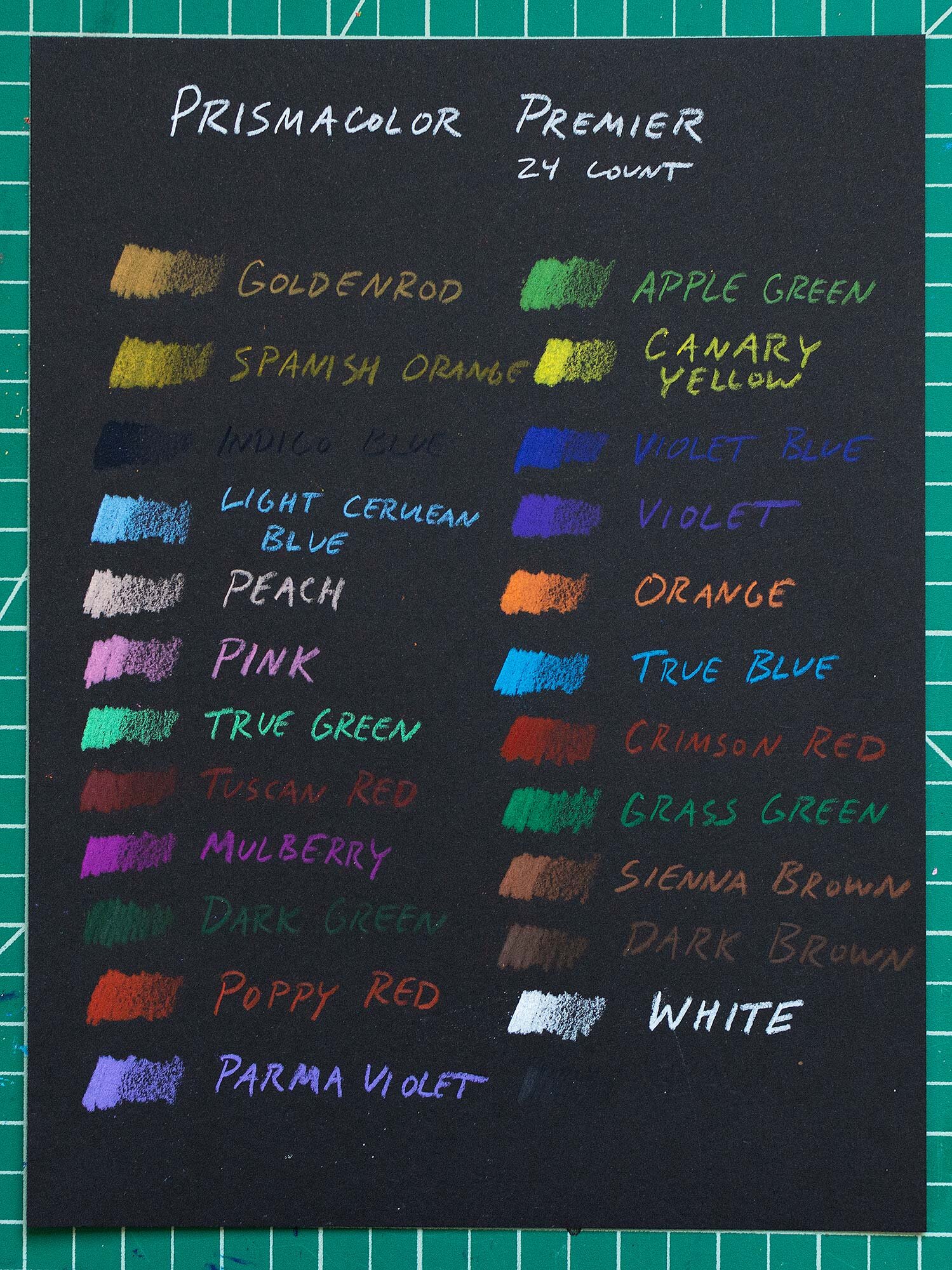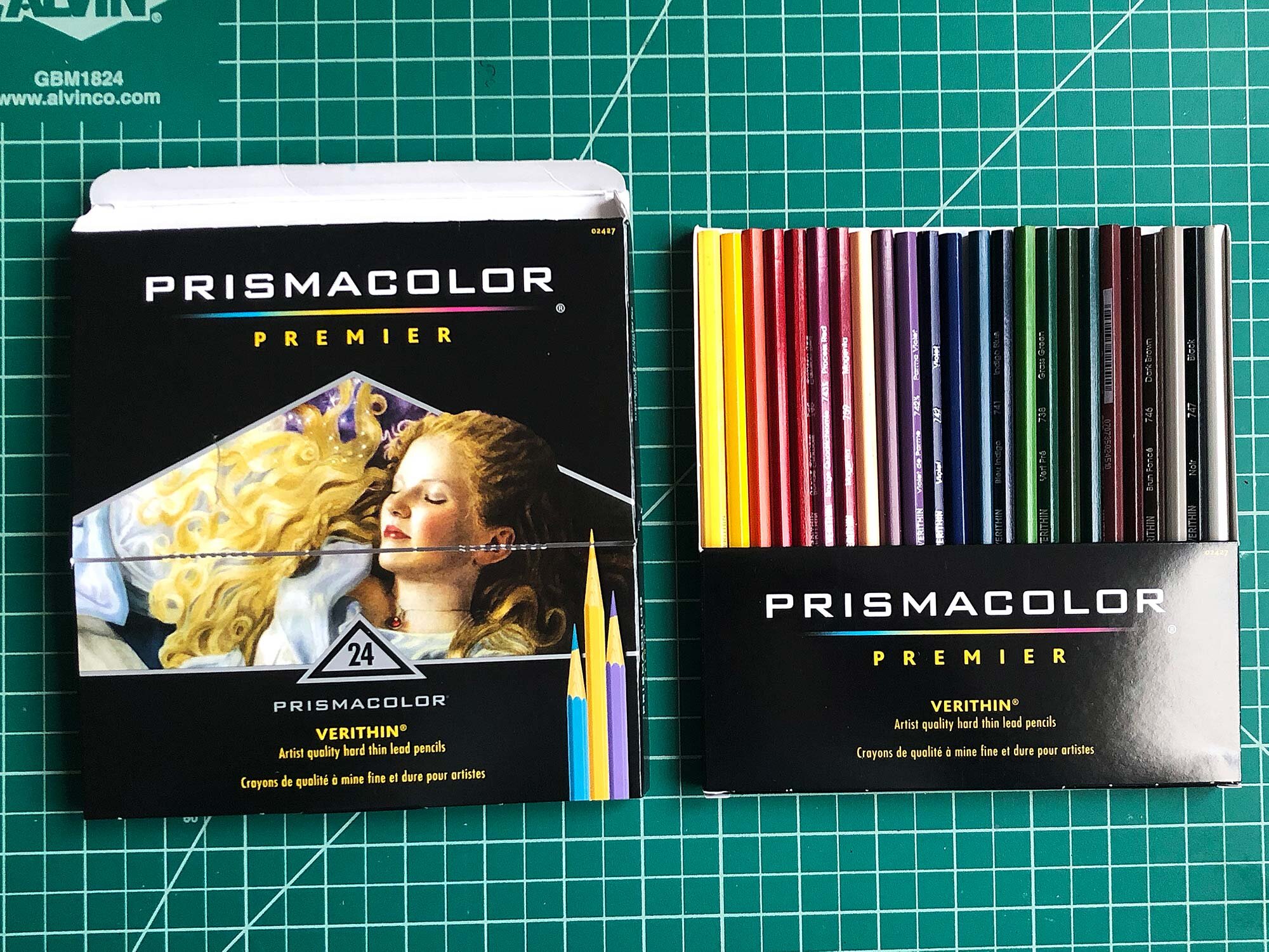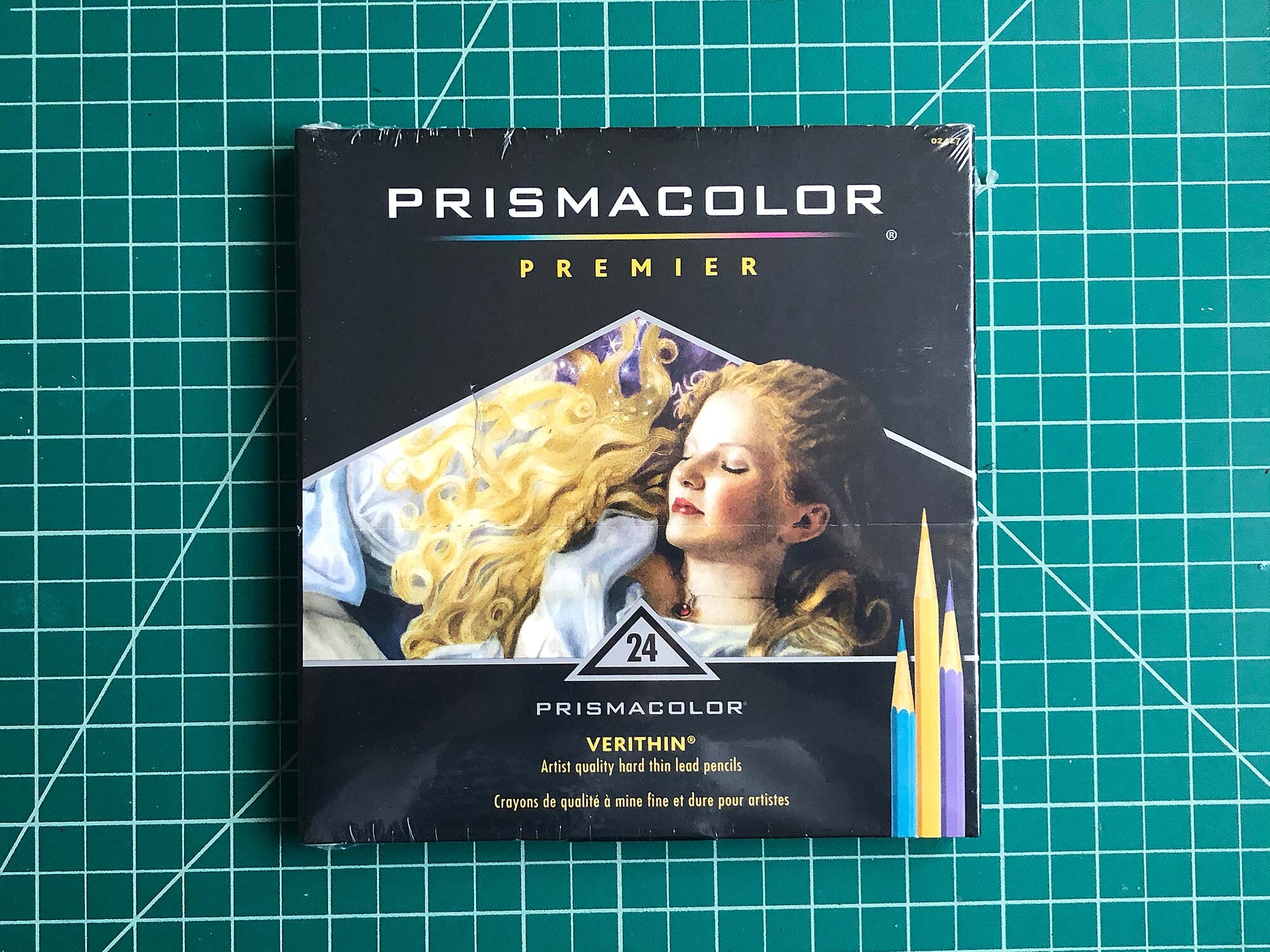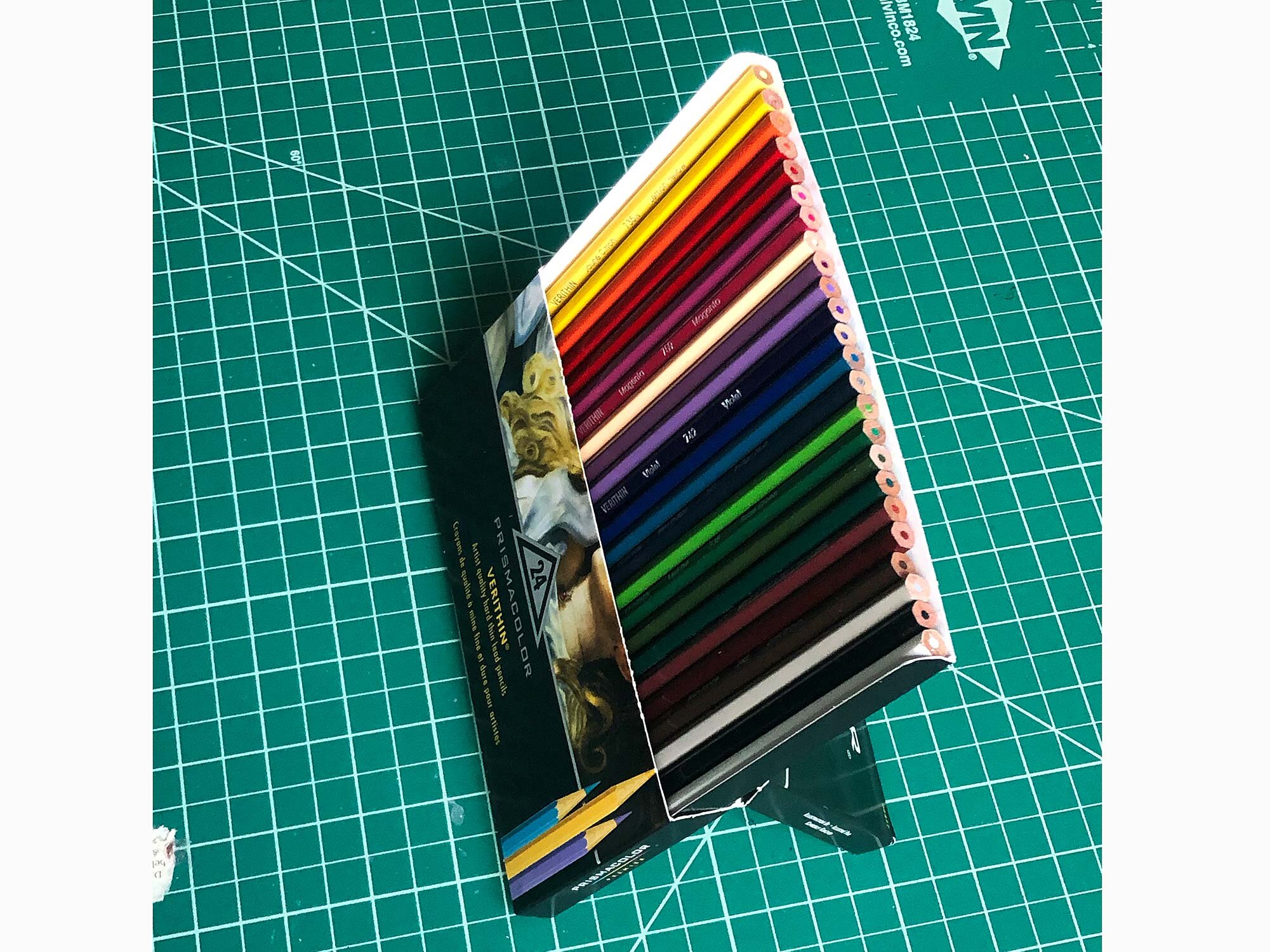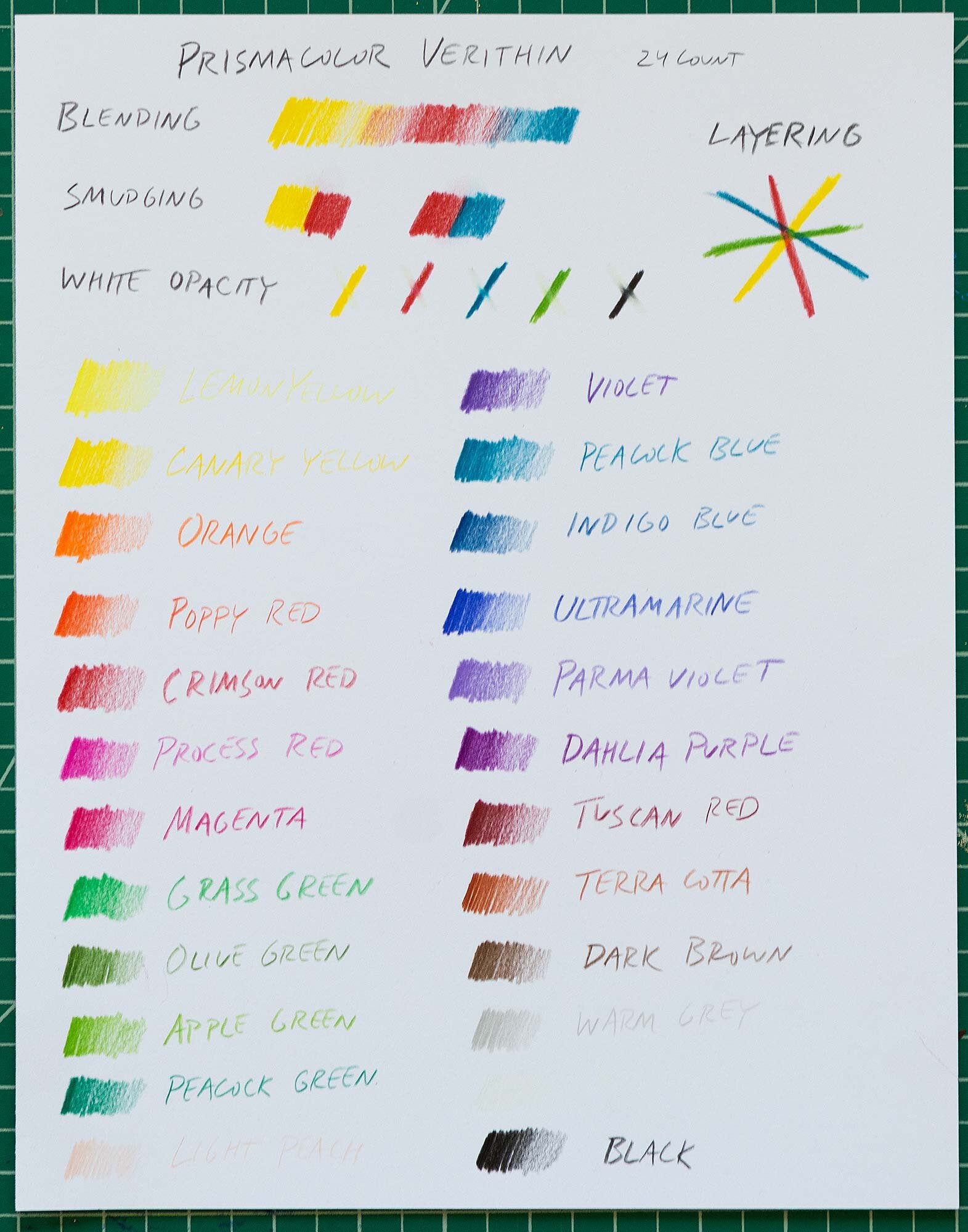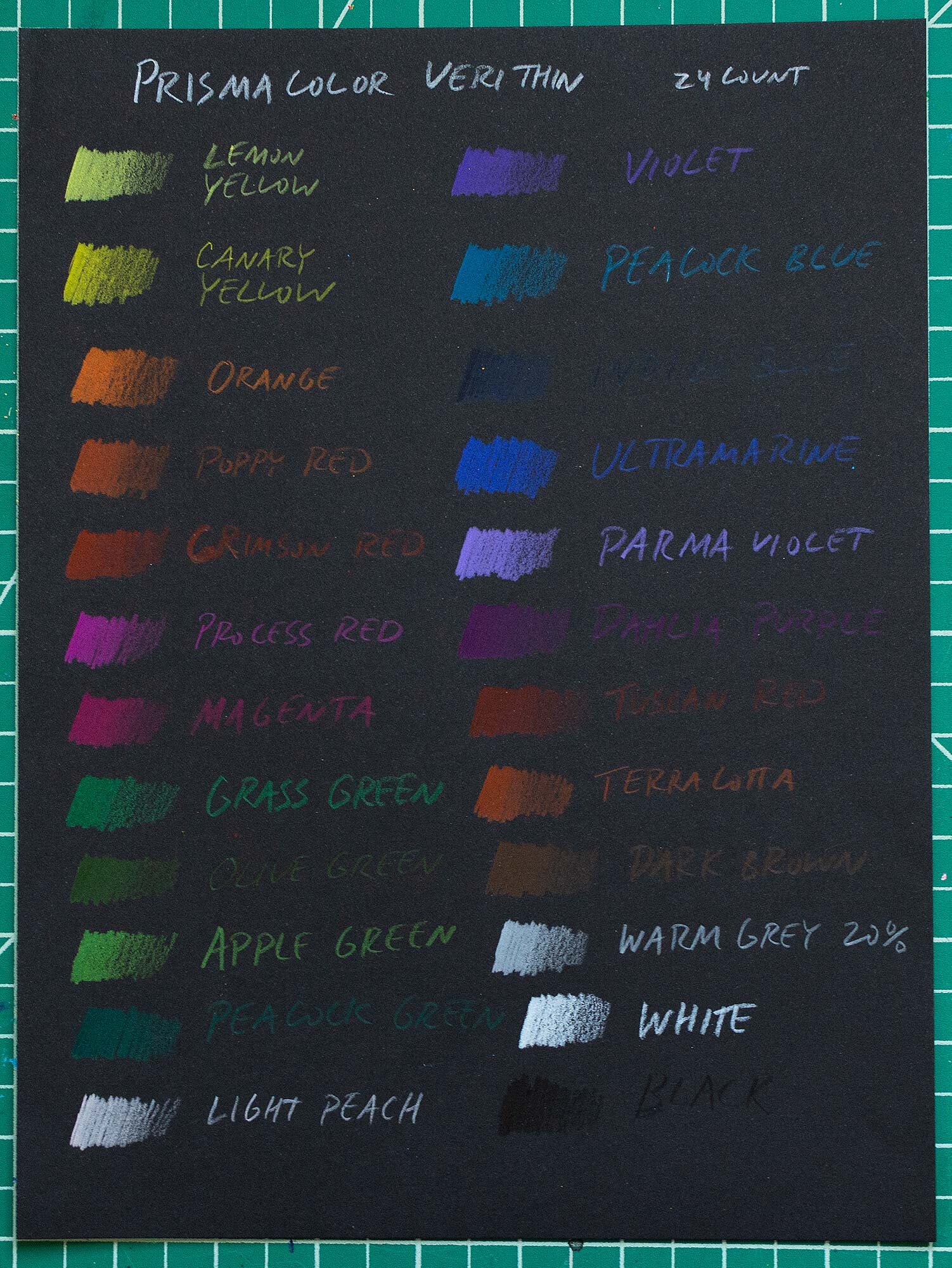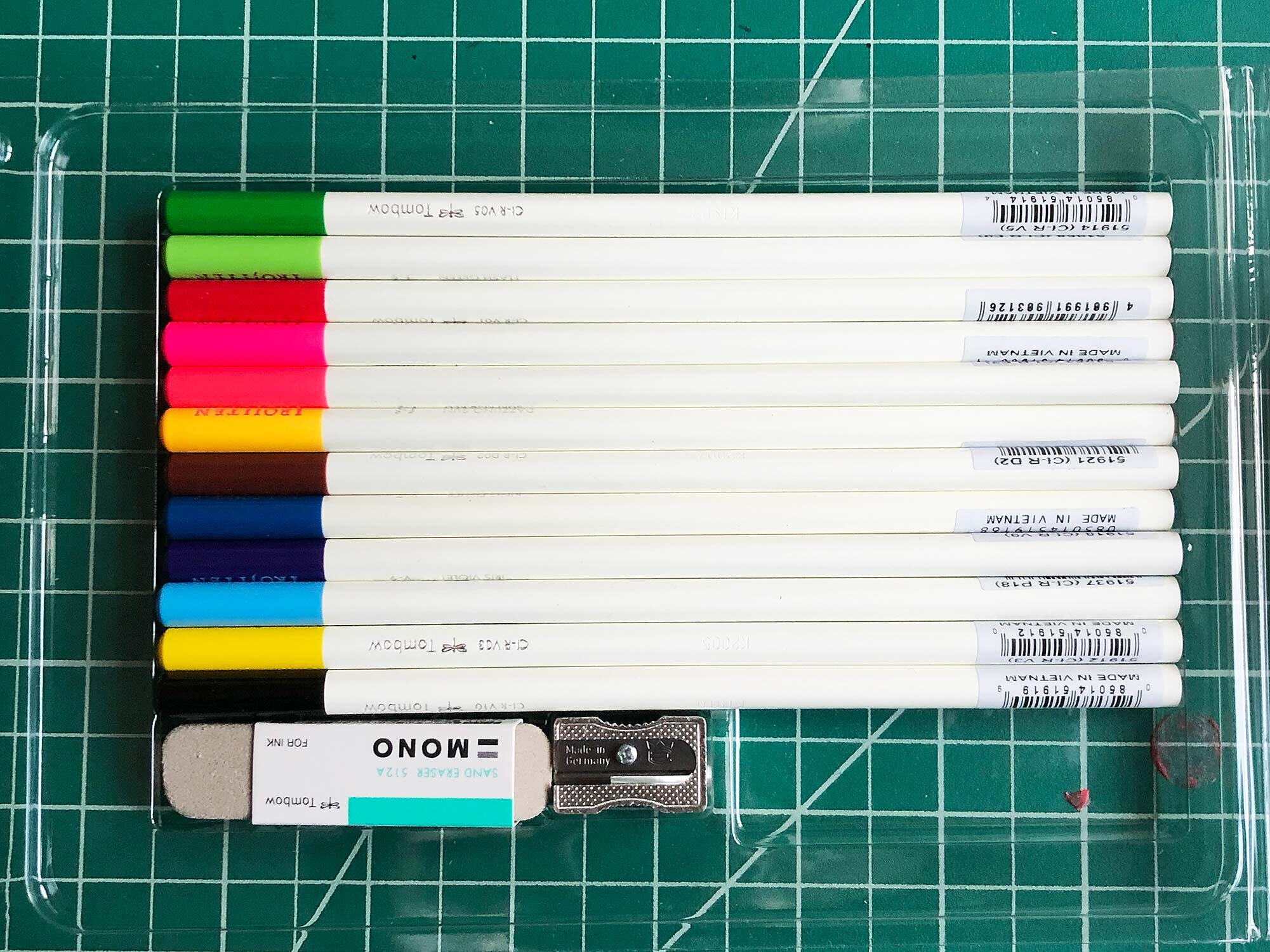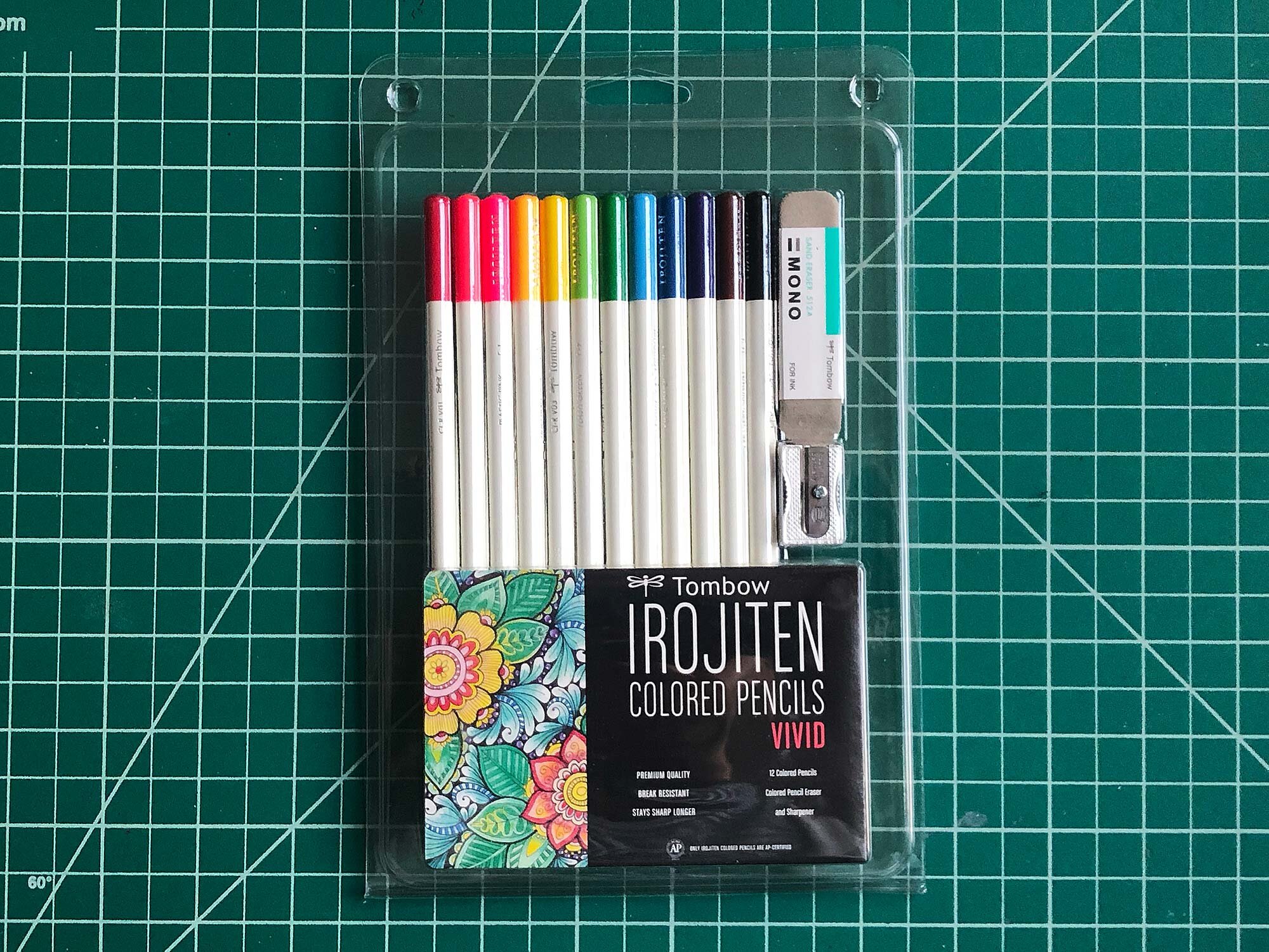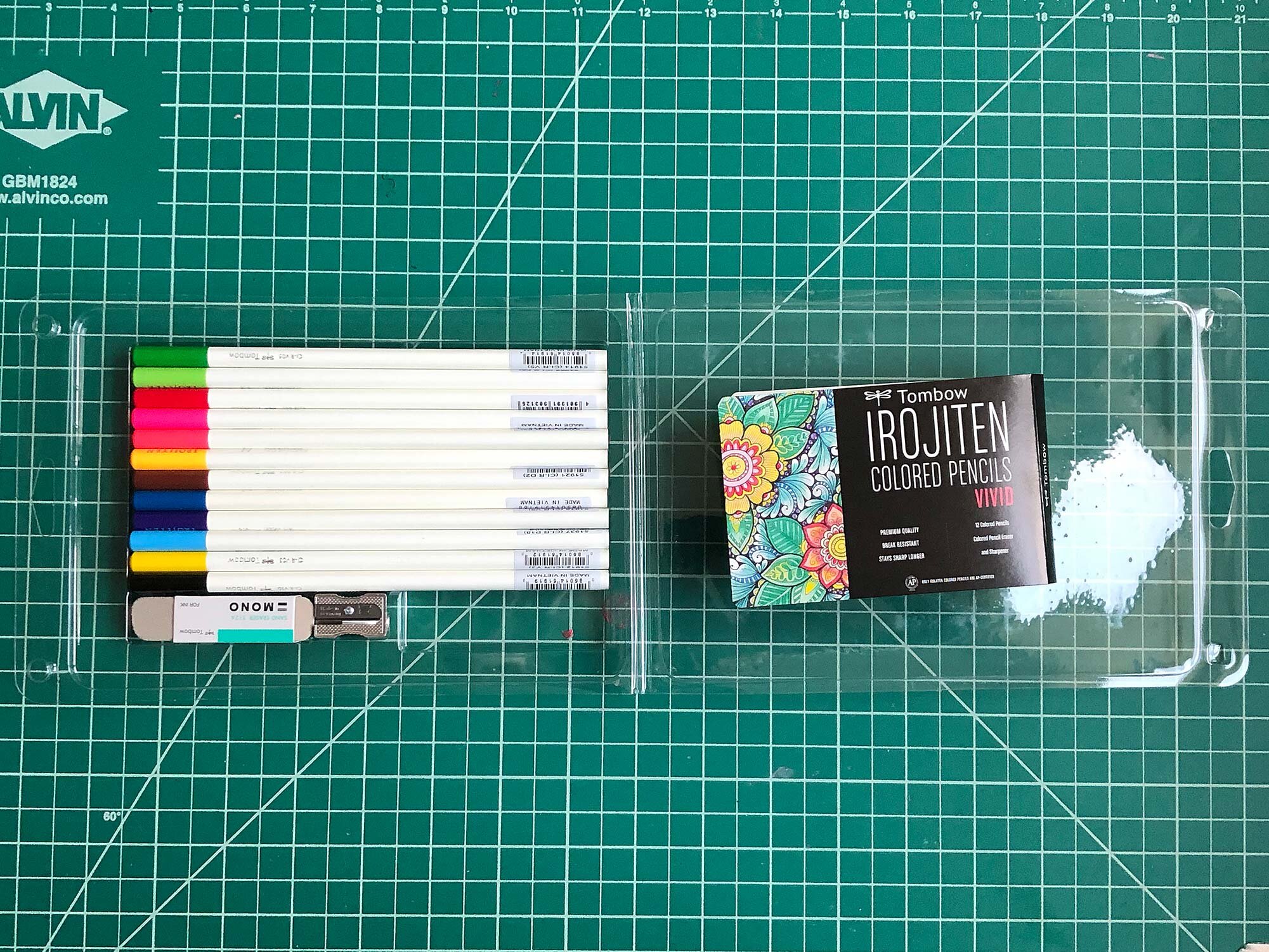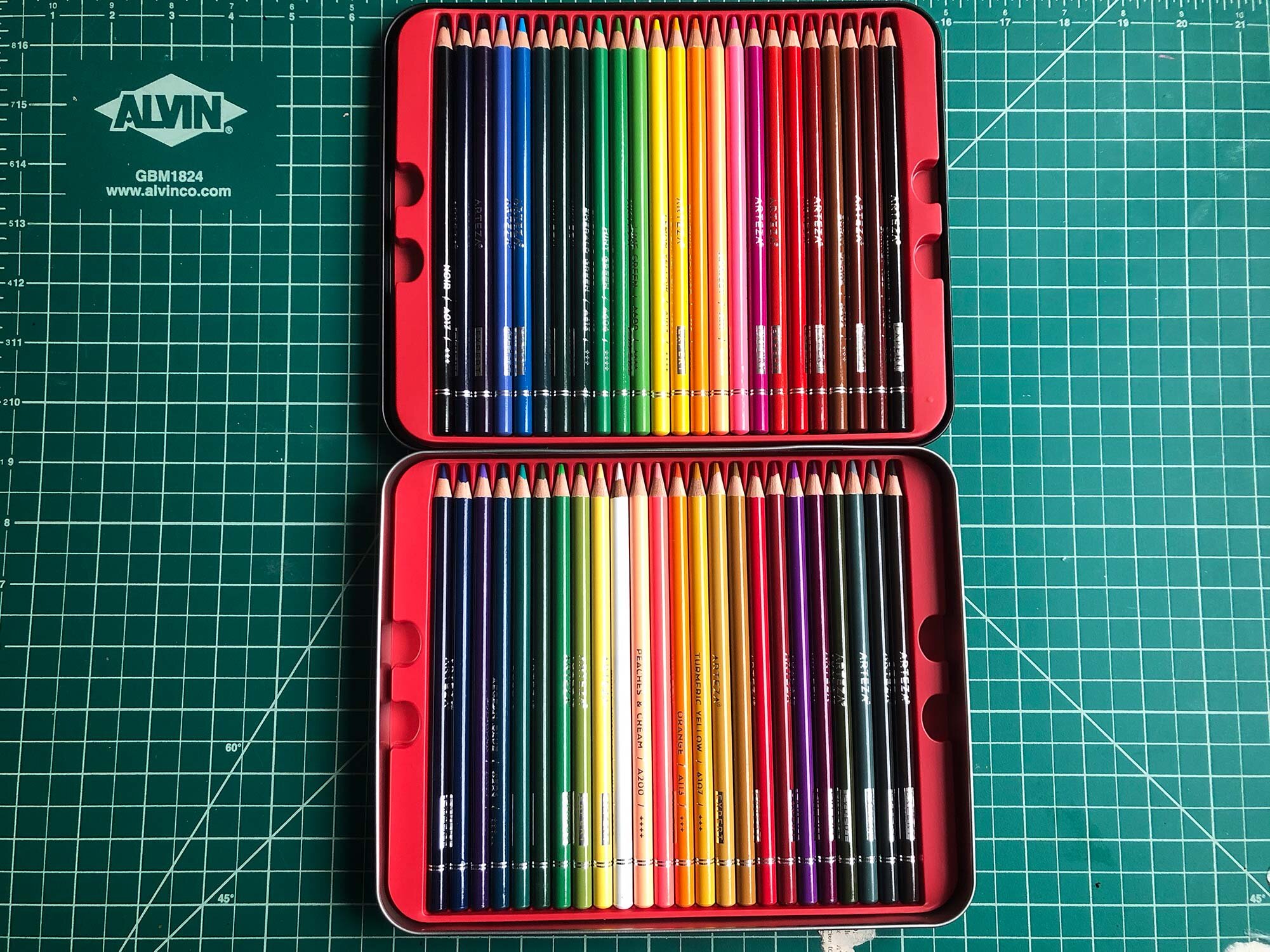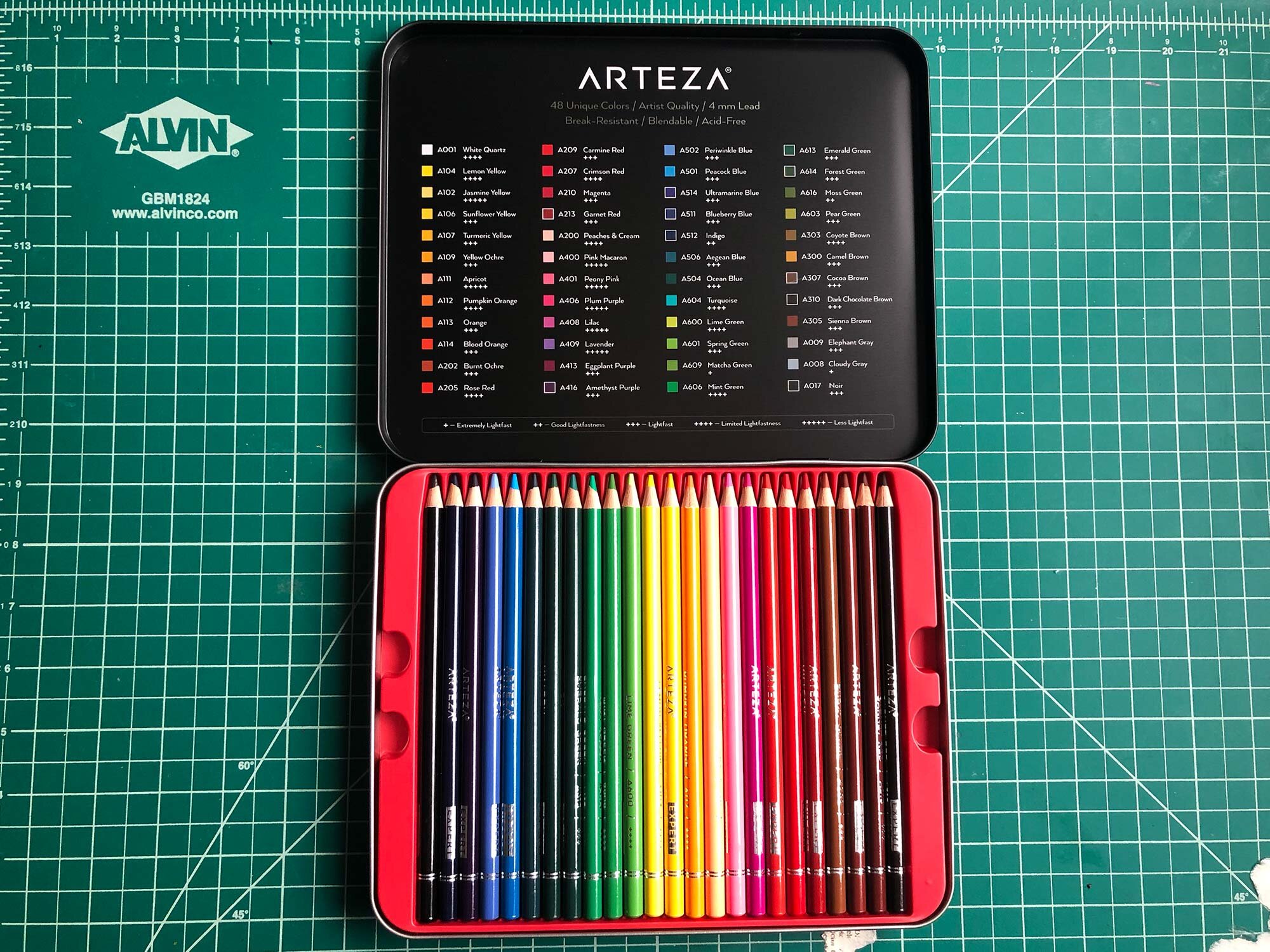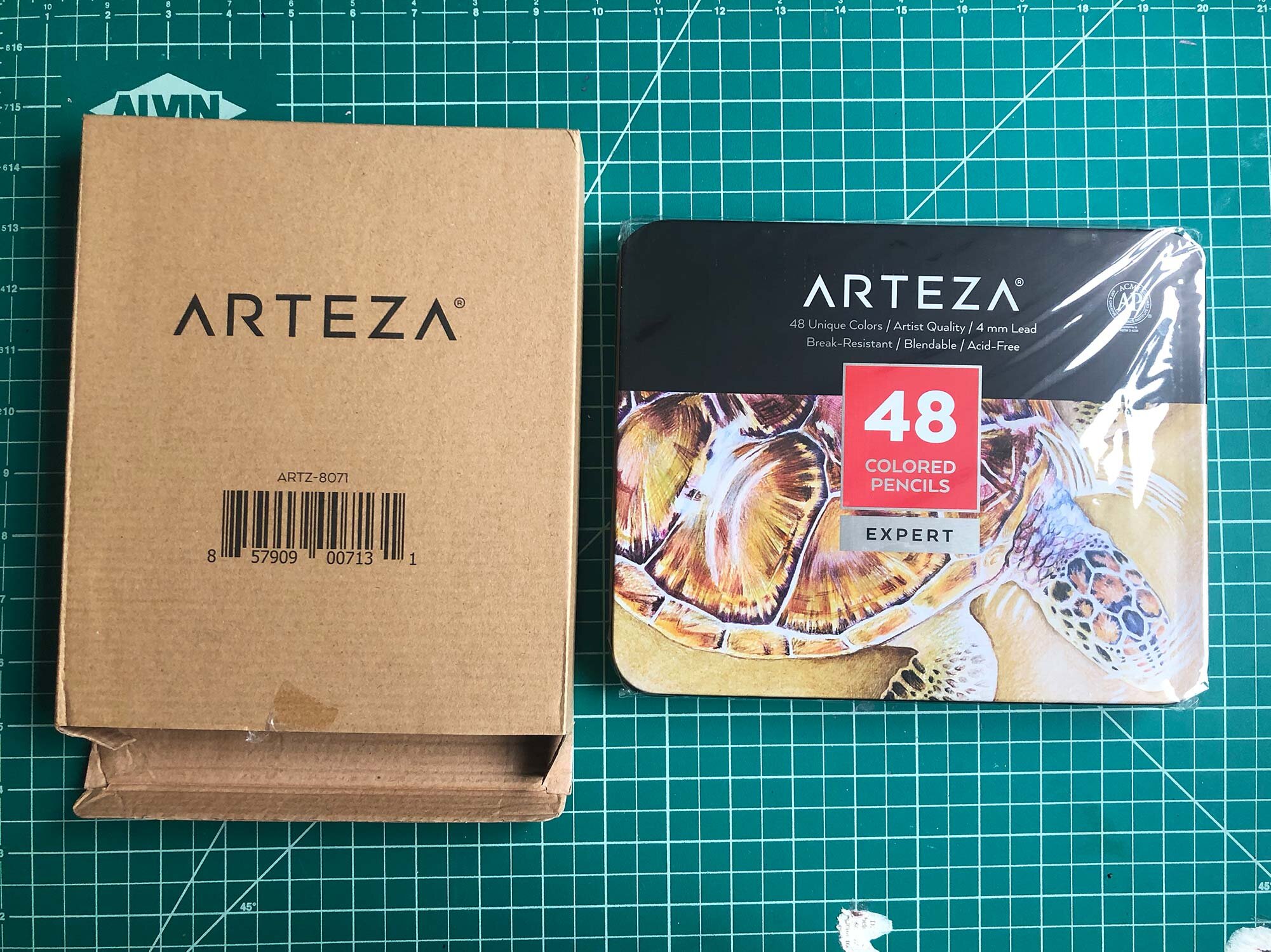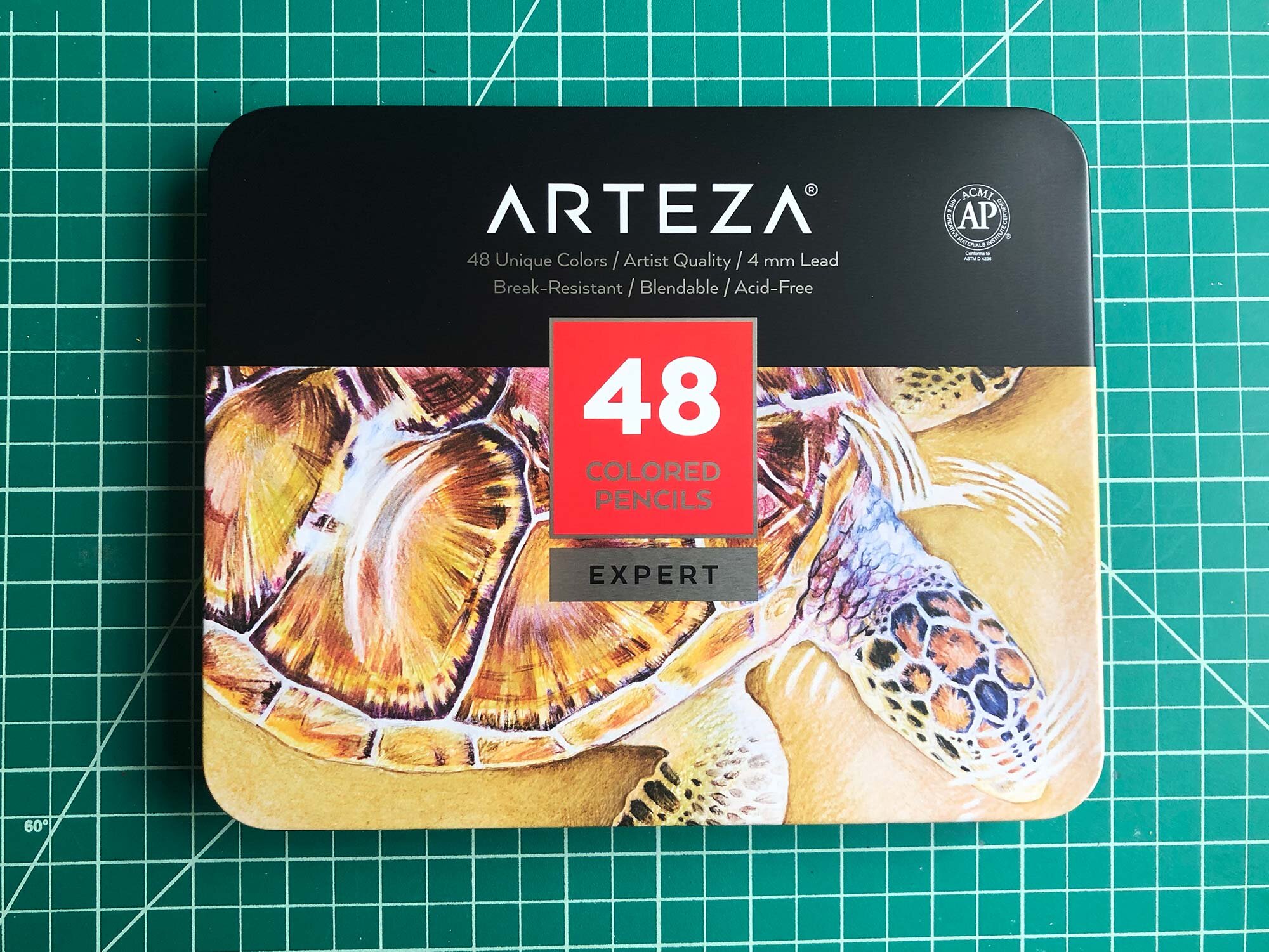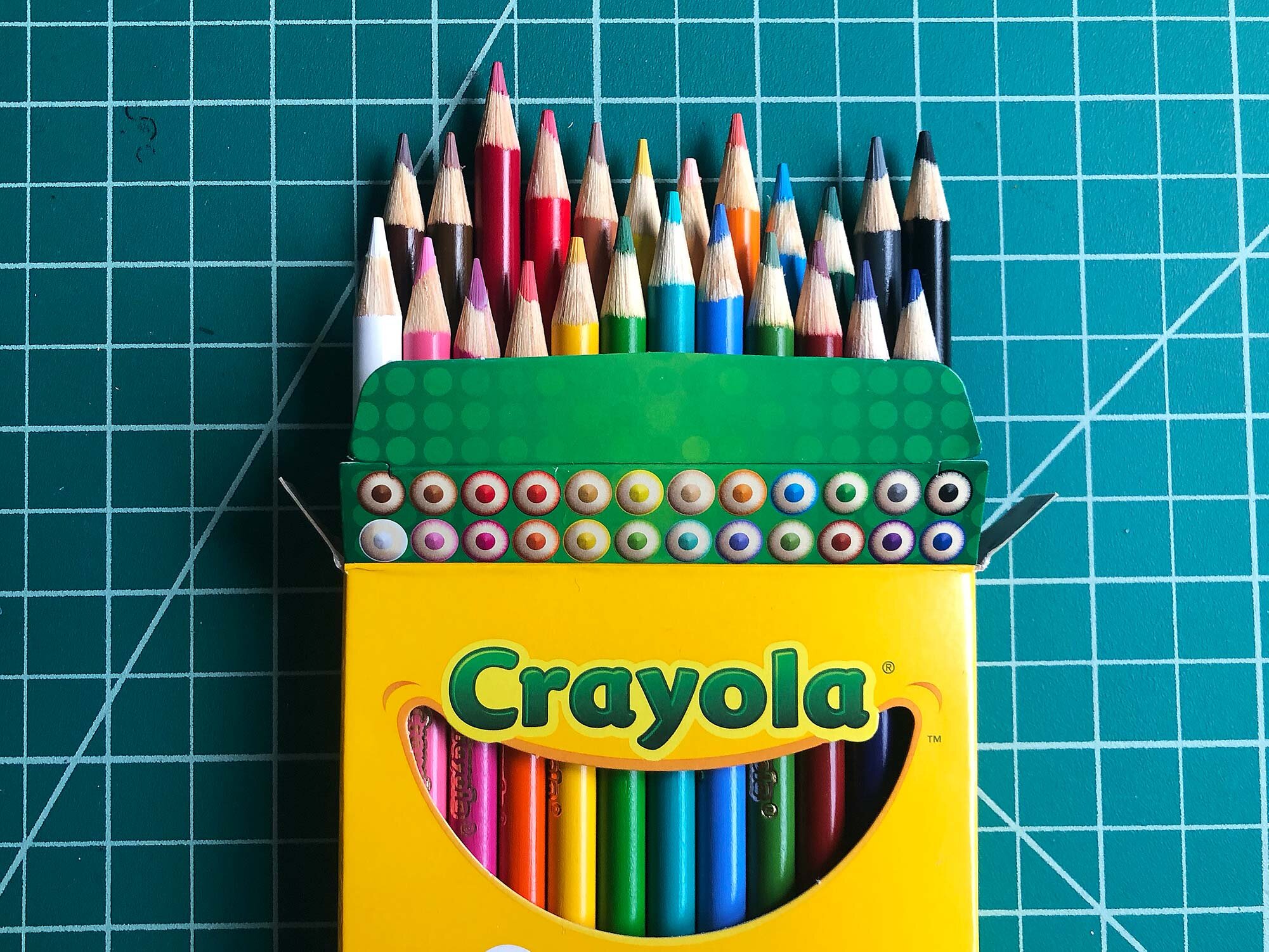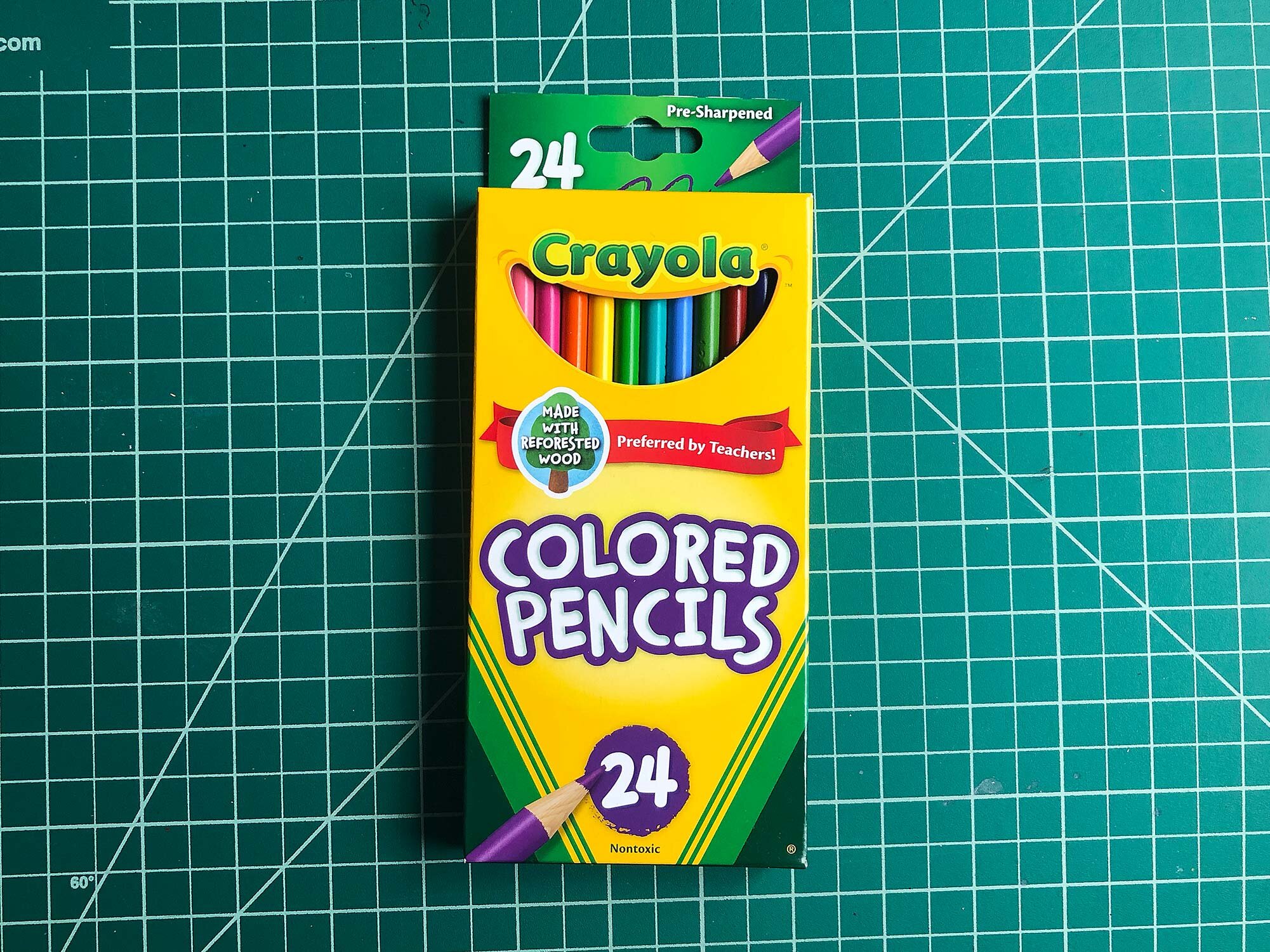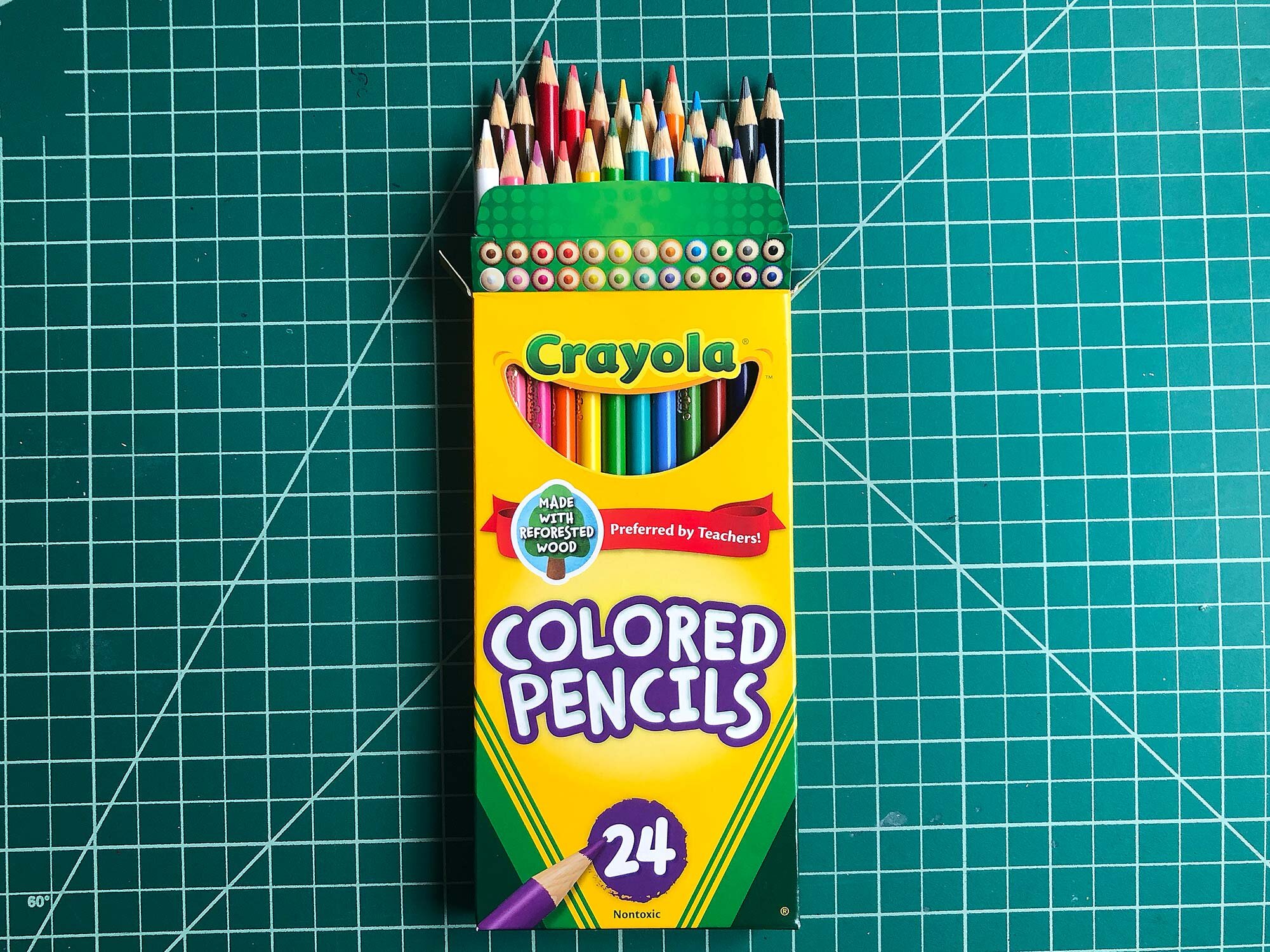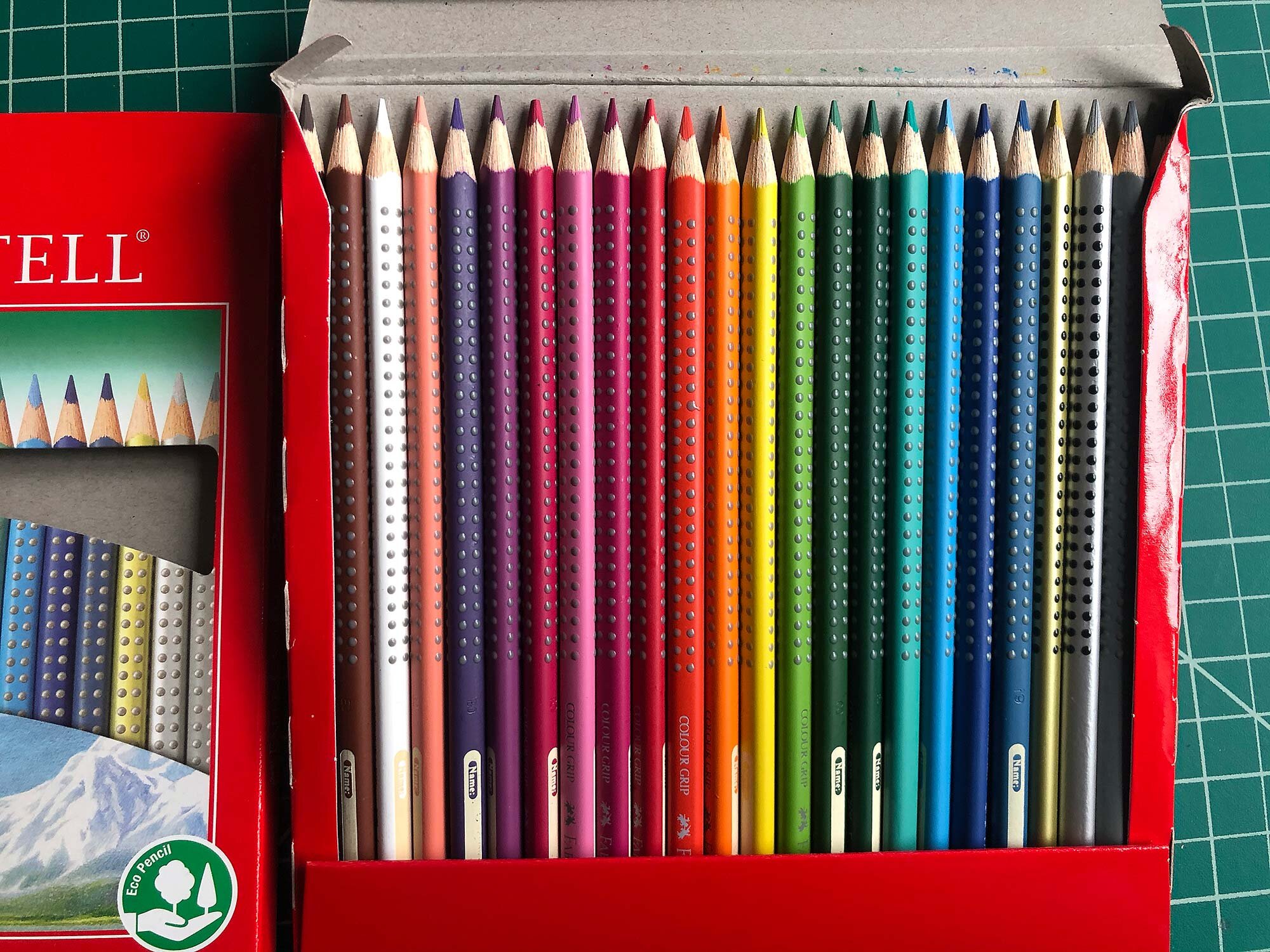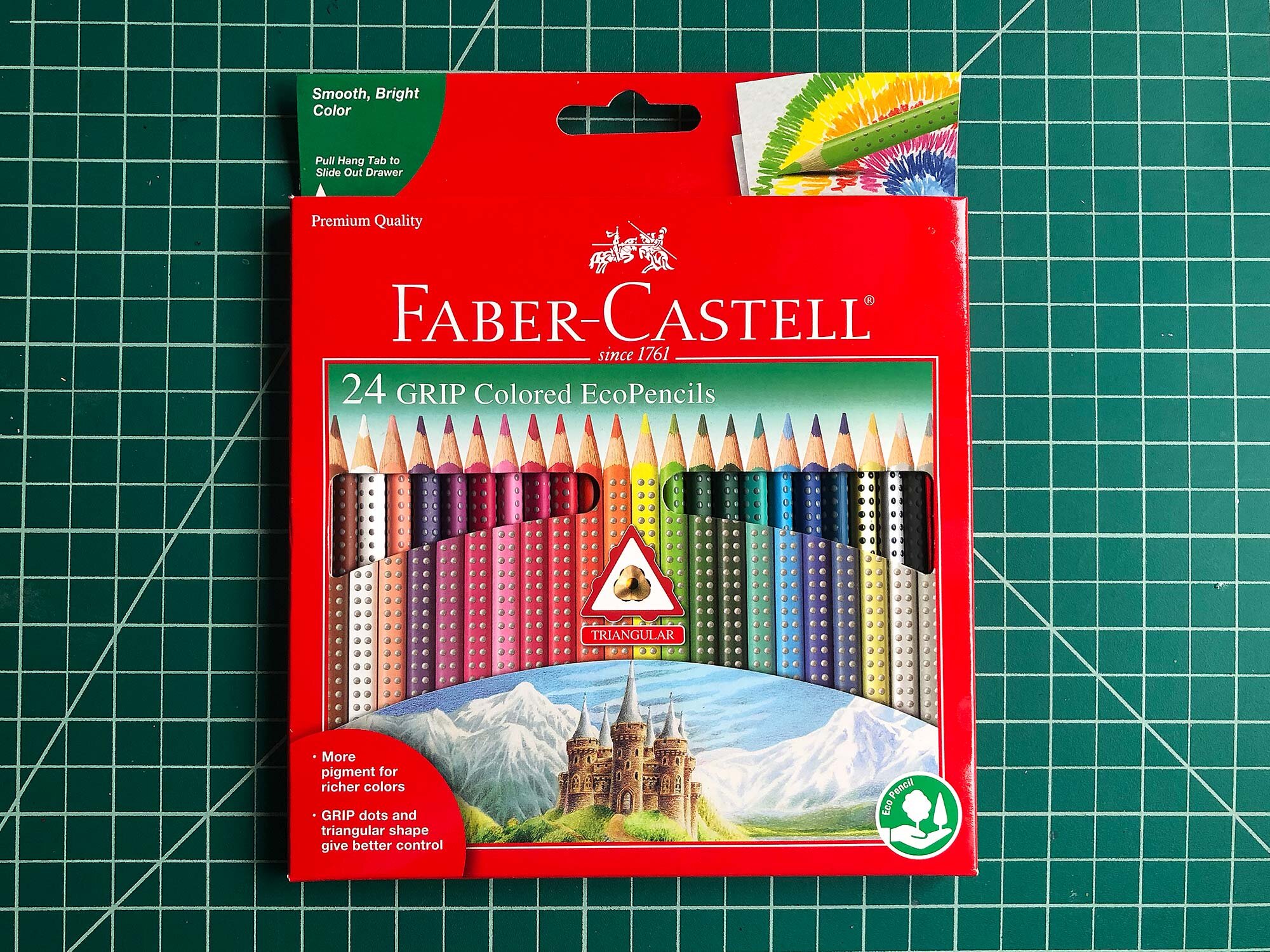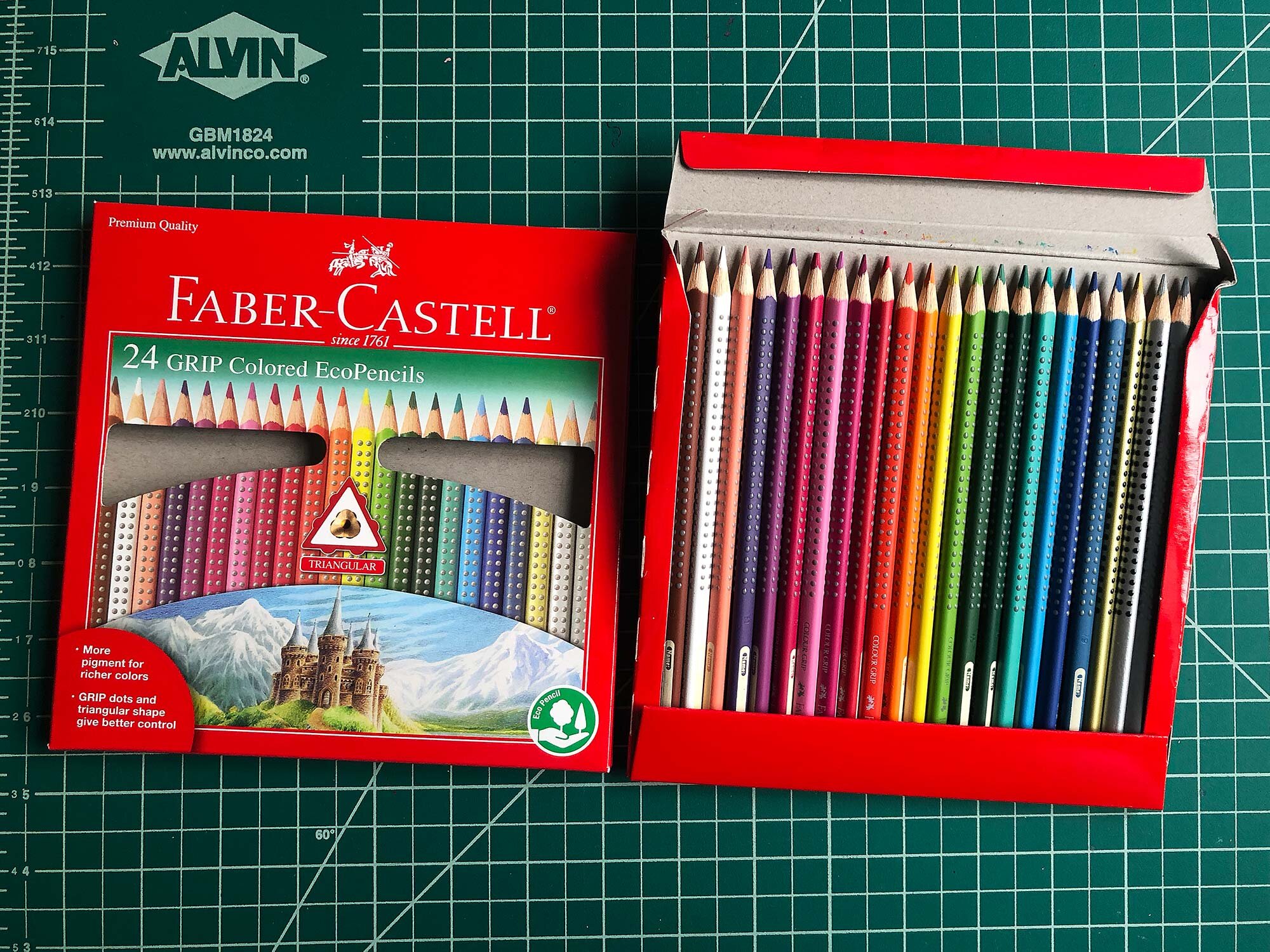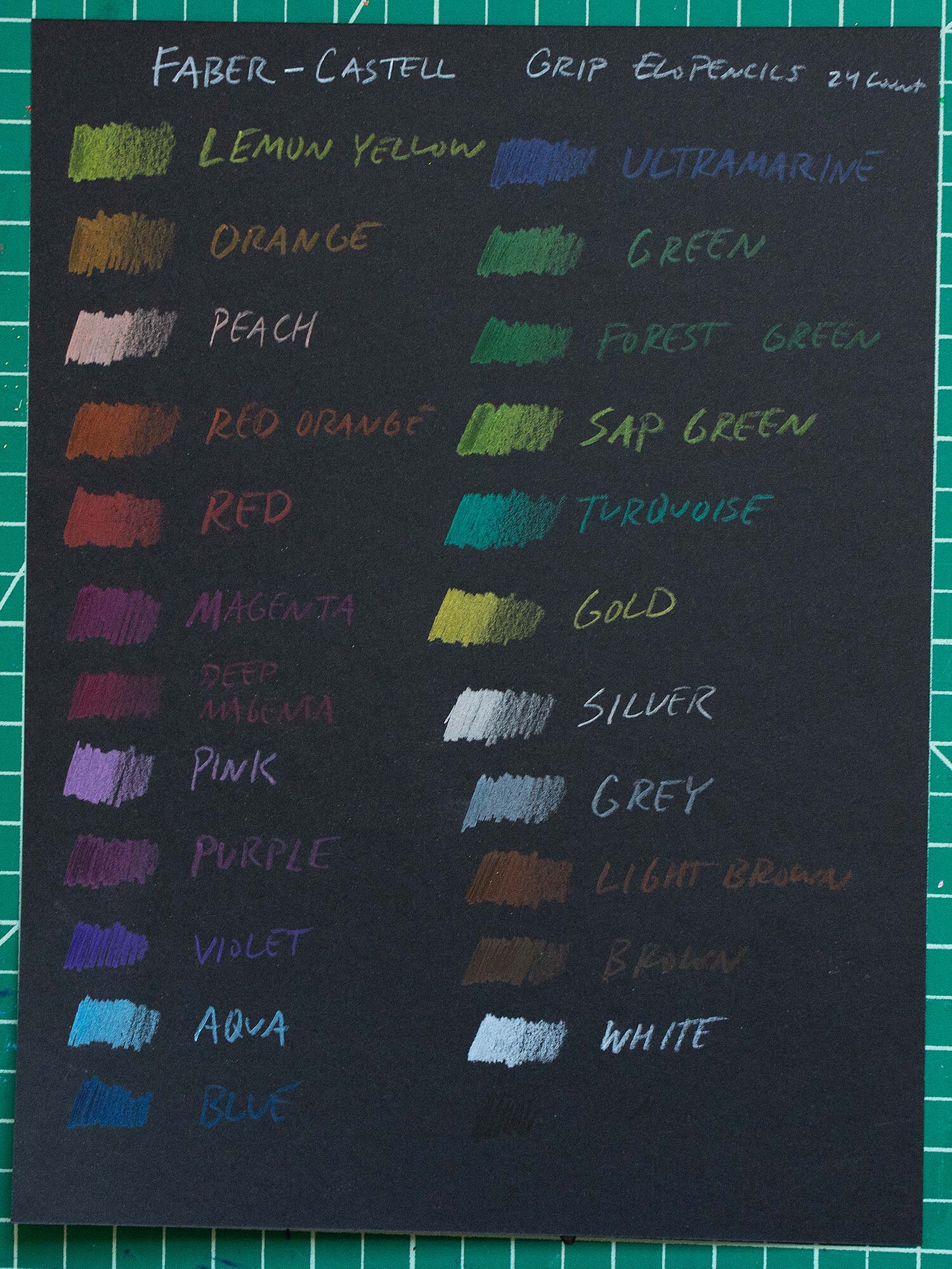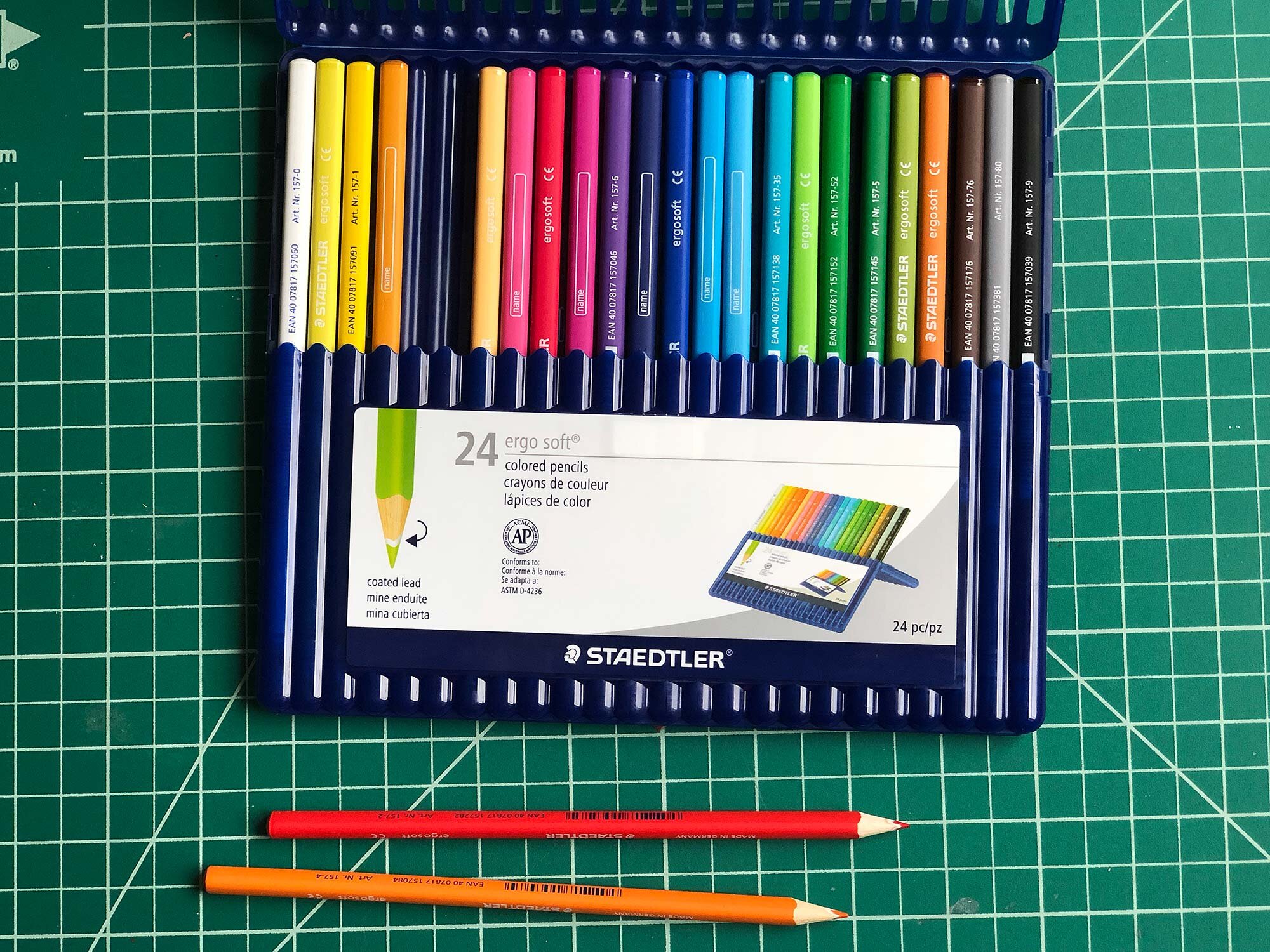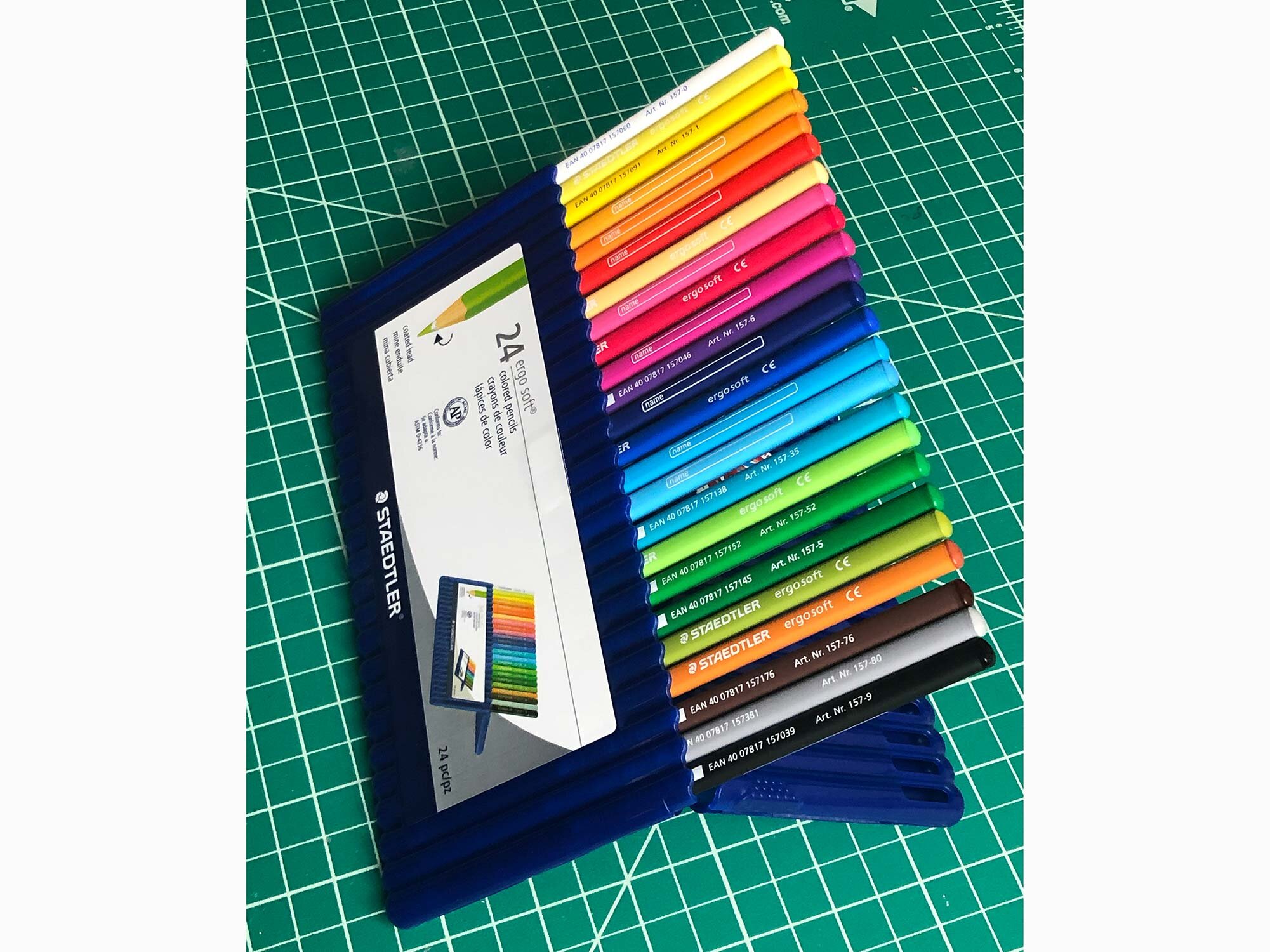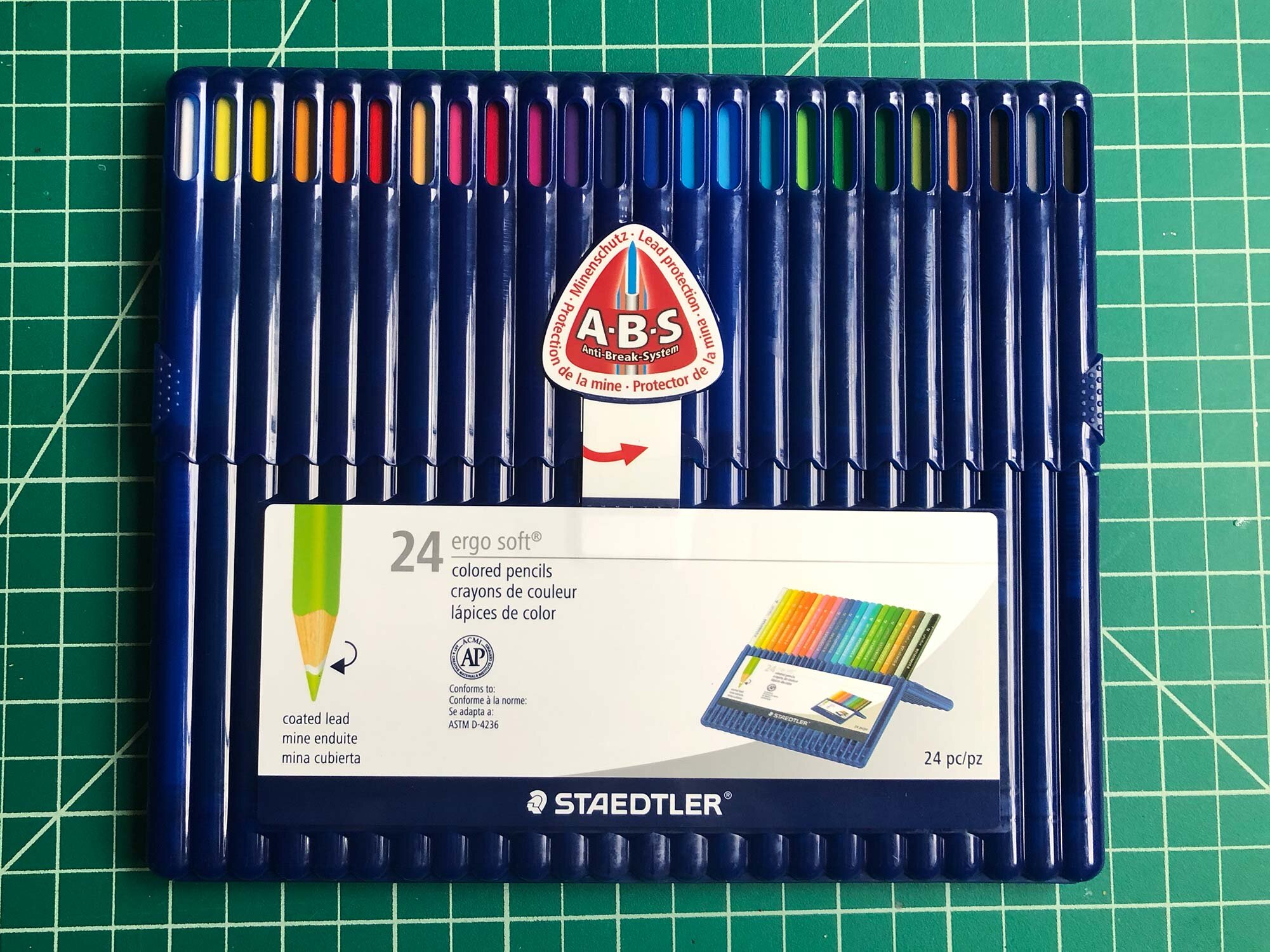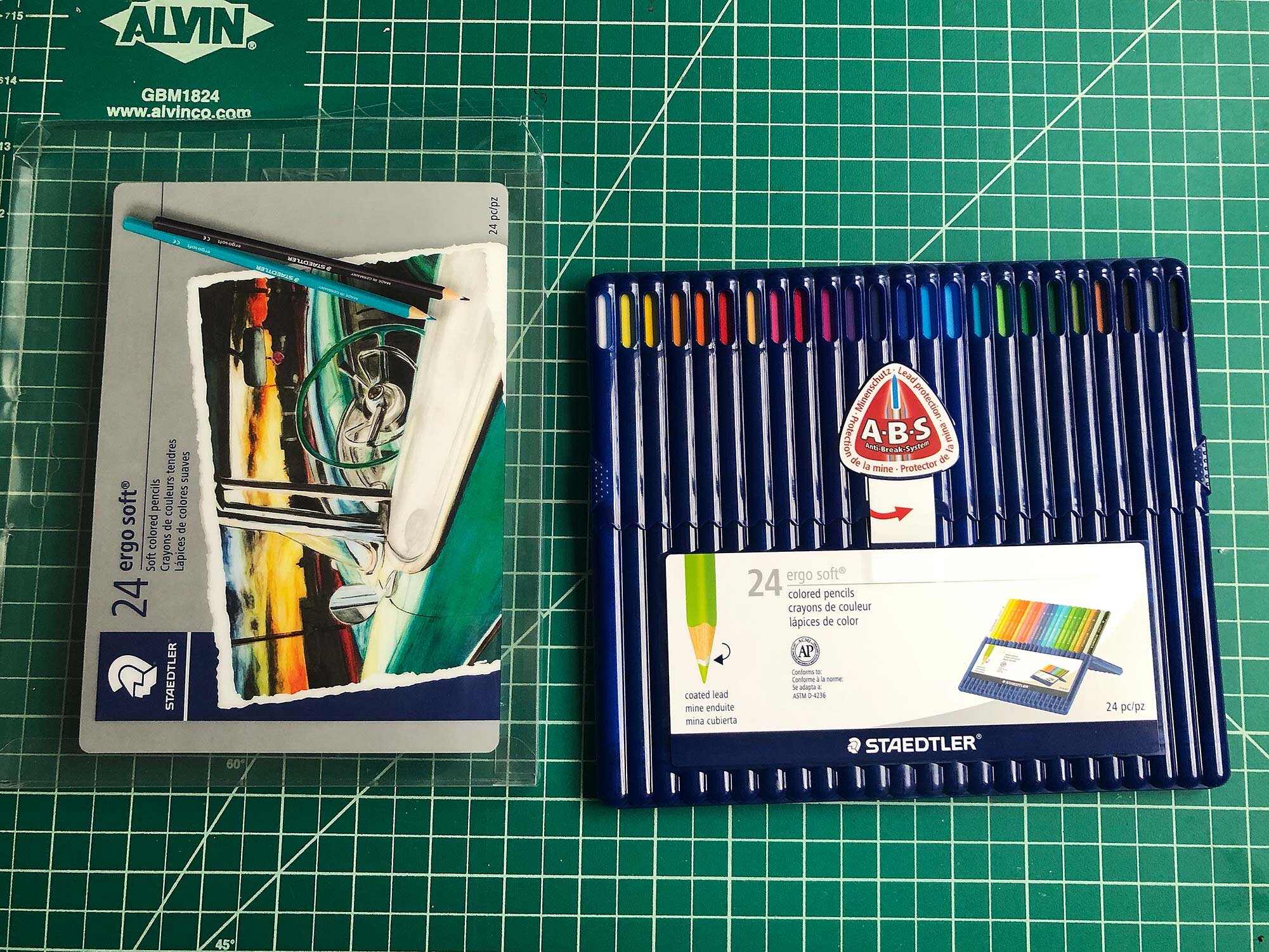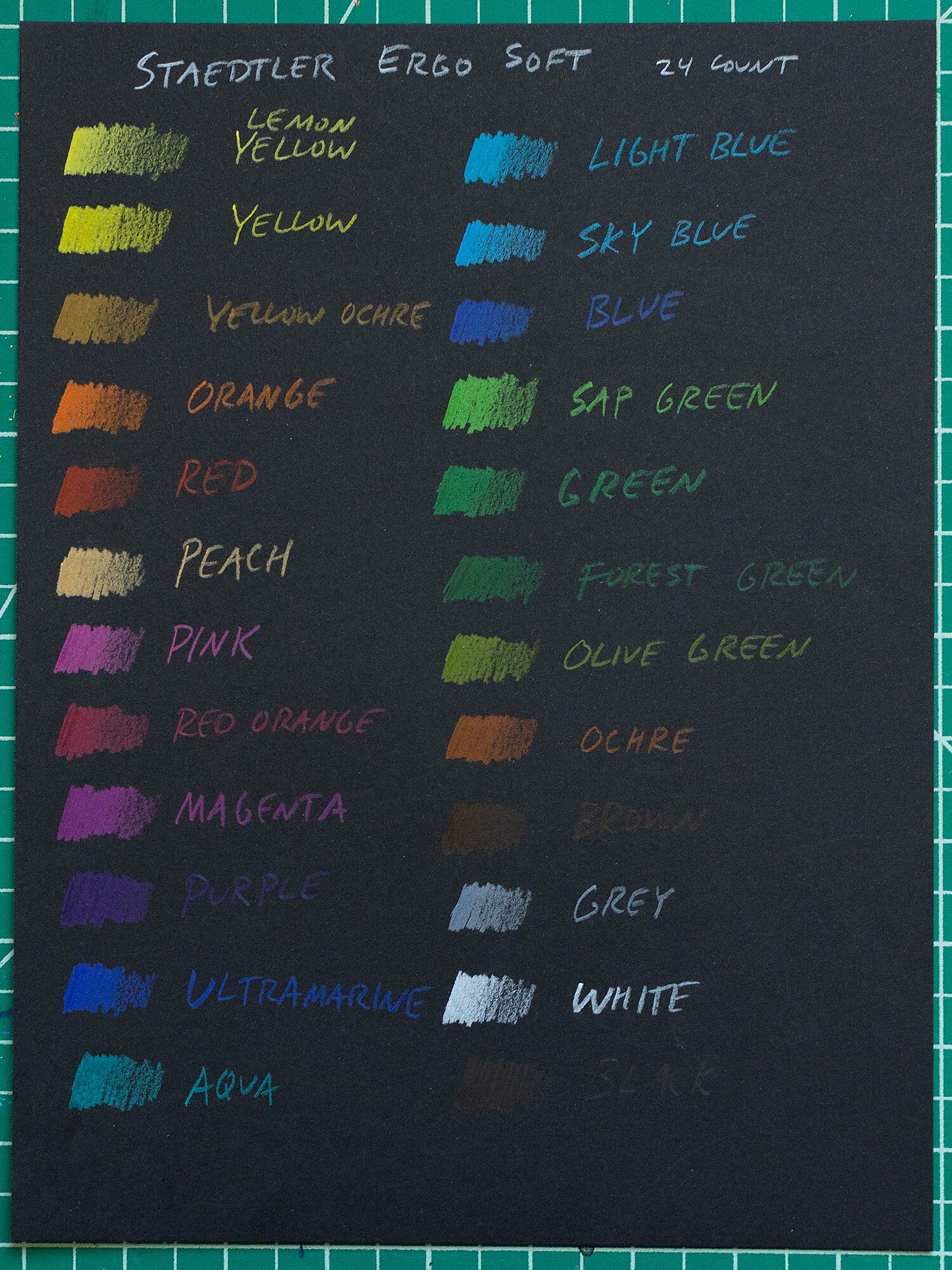For this post, 15 colored pencil brands were tested including 11 artist-grade pencils and 4 student grade. The goal was to find the best pencil for artists, along with the best set for coloring book enthusiasts and students. Special attention was paid to lightfastness ratings, which helps gauge how long the colors will stay vibrant and true. Other considerations included color range, vibrancy, materials, ease of use, shininess or “wax bloom,” if pencils are available individually, and cost.
I was hoping this head-to-head test would result in one clear favorite, but instead I’d be very comfortable recommending six of the pencils tested including (in alphabetical order) the Caran D’Ache Luminance or Pablo; the Derwent Coloursoft or Lightfast; Faber-Castell Polychromos; Holbein Artists’ Colored Pencil; and Prismacolor Premiers. Any of these, or a combination of these pencils, will give you everything you need in the studio. Other pencils will work too, but these six lines stood out for their bright, vibrant colors and lightfastness qualities that indicate artist-quality pencils.
But if you want a judgement, here’s my top picks.
Best Artist-Grade Pencil: Derwent Lightfast
After testing and comparing , the best artist-grade pencil is Derwent Lightfast. It’s a chunky, round-barreled, oil-based pencil with 100 colors that are all lightfast, which means they should hold up under museum conditions for 100 years or longer. The colors lay down with a matte quality with good vibrancy and ability to blend or smudge. The Lightfast line was a bit cheaper than the other 100% lightfast line, the Caran D’Ache Luminance. The Derwent Lightfast colors do have a more muted color palette than other sets, but overall these are the best pencils for artists who want their work to stand the test of time.
Derwent Lightfast 24 count tin
Best All-Around Artist Pencil: Faber-Castell Polychromos and Prismacolor Premier
Faber-Castell Polychromos 24 count tin
Faber-Castell Polychromos and Prismacolor Premiers are some of the most popular colored pencils and when considering quality, lightfastness, and price, I felt that a combo of these two would be best for most artists. Prismacolors are soft, waxy and have vibrant, intense colors. They are also affordable, have decent lightfastness, and really show up on black paper. The Faber-Castell Polychromos are a harder, oil-based pencil that is more matte, easier to layer, stays sharper longer, and can still achieve saturated colors. (I also liked the Caran D’Ache Pablo pencils, but felt Polychromos gave a similar result at a lower price) A combination of Polychromos and Premier will give you the best of both worlds and if lightfastness is a concern, both manufacturers provide lightfast ratings. (Prismacolor Premier shopping links in next section)
Best for Adult Coloring or Advanced Students: Prismacolor Premier
This is a harder distinction, as most of the student-grade (and cheaper) pencils tested were not as vibrant and pigment-rich as the artist-grade pencils. The Staedtler Ergosoft are a quality pencil designed to resist core breakage, and the Arteza Experts have lots of colors at a budget price but both of these have colors that lack intensity and depth. With that in mind, I think most artists and hobbyists would be happy with a soft, waxy pencil such as Prismacolor Premier. The main drawback with Premiers is that their soft cores are prone to breaking. But given that they cost less than $1.00 per pencil when purchased in sets, I’d choose the bright, saturated colors over the occasional broken core. The Premiers are a great option for coloring book enthusiasts or artists of any age. Even younger children will appreciate the bright colors and soft quality that is way more fun to use than the standard Crayola schoolroom pencils. And the Premiers are the best colored pencil to use on black paper of any set tested.
Comparison Charts
All the pencils tested in alphabetical order. Test was done on Canson XL 98lb Mix Media paper, 11x14” size.
All the pencils tested in alphabetical order. Test was done on Canson XL Black 92lb Drawing Paper, 9x12” size.
Before jumping into individual reviews I wanted to share these comparison charts, which played a big role in analyzing the performance of colors versus each other. All of the pencils tested look ok on white paper. What’s harder to see is that the waxier pencils can develop shininess or “wax bloom” especially when viewed from the side, while the oil-based pencils have a more matte quality that looks good from all angles. Avoiding wax bloom is one of the main reasons to upgrade to artist-quality pencils.
On black paper, you can really see the difference in the pigment intensity in the artist-grade brands. To my eye, the pencils from Caran D’Ache, Derwent, Faber-Castell Polychromos, Holbein, and Prismacolor Premiers really stood out. The waxy, soft Prismacolor Premiers seemed to “pop” the most on the black paper.
A note on images: All the color charts in this test were made on the same paper, photographed at the same time, and edited exactly the same. They should be “true” to each other. White paper tests were done on Canson XL 98 lb Mix Media Paper; Black paper tests were done on Canson XL 92 lb Black Sketching Paper.
Table of Contents
Introduction
Comparison Charts
Artist’s Grade Colored Pencils Reviews:
Blick Studio Colored Pencils; Caran D’Ache Luminance; Caran D’Ache Pablo; Derwent Coloursoft; Derwent Lightfast; Faber-Castell Polychromos; Holbein Artists’ Colored Pencil; Lyra Rembrant Polycolor; Prismacolor Premier; Prismacolor Verithin; Tombow Irojiten
Student Grade Colored Pencil Reviews
Arteza Expert; Crayola Colored Pencils; Faber-Castell Grip EcoPencil; Staedtler Ergosoft
Lightfastness Background and Information
Oil vs Wax in Colored Pencils
Testing Methodology
Summary
Artist Grade Pencil Reviews
These reviews detail individual characteristics of 11 different brands and models of colored pencils aimed at professional artists. Artist-grade pencils have a richer pigmentation, 72 or more pencil colors, are made with higher-grade materials and pigments, and can be purchased individually as “open stock” in stores and online. The following reviews are presented in alphabetical order.
Blick Studio Artist's’ Colored Pencils
The Blick Studio Artists’ Colored Pencils 24 count on white paper.
Blick Studio Artists’ Colored Pencils are available online and at Blick stores in North America. Made in the Czech Republic, the round pencils are economical and available in a range of 91 colors both in sets and open stock. The 24 count set tested came in a metal tin with a plastic tray liner. Blick produces a variety of sets, so that is an advantage if you are looking for smaller sets in a narrow color range, such as Landscape or Portrait.
The cores are on the stiffer side and harder to blend than other brands, but they do hold a decent point and there were no issues with breakage. Coverage was best on white paper while disappointingly, the colors were more muted on black paper.
The Blick Studio Artists’ Colored Pencils 24 count on black paper.
These pencils are thicker than Prismacolors but not as chunky as Derwent pencils, I’d estimate somewhere around 7.8mm in thickness. For lightfastness, only about 27 percent of the line rates as a top Lightfast 1 or 2 rating. For the economical price, this is ok, but the majority of the pencils would not be suitable for artists concerned with artwork longevity.
To conclude, these are fine pencils, especially if you are on a budget. But with so many options on the market, I would look to other economical brands that are a bit softer and more vibrant, such as Prismacolor Premiers. But these would be great colored pencils for a student, older child, or someone looking for high-quality pencils for adult coloring books.
Blick Studio Artists’ Colored Pencils typical pricing:
12 count: $12.22 ($1.02 per pencil)
24 count: $17.67 ($0.73 per pencil)
36 count: $25.74 ($0.72 per pencil)
48 count: $33.49 ($0.70 per pencil)
72 count: $49.49 ($0.69 per pencil)
Individual / open stock: $1.21 per pencil
Caran D’Ache Luminance
Caran D’Ache Luminance 20 count set on white paper.
Caran D’Ache Luminance are premium, 100% lightfast, oil-based colored pencils made in the Switzerland and available in sets or individual pencils. In 2020, the line was upgraded to a total of 100 colors. Every pencil has a lightfastness rating of I or II, meaning that the under low-light museum conditions, the colors will stay true for at least 100 years. It’s an impressive set only rivaled by the Derwent Lightfast line. The manufacturer claims 80 percent of the line is a Lightfast 1 rating, while 20 percent is Lightfast 2.
Caran D’Ache Luminance 20 count set on black paper
The round pencils are chunky and light in the hand, and the cardboard box has a foam liner which is easy to use and protects the pencils. The lead is highly pigmented with beautiful, intense color on both white and black paper. The colors lay down evenly and stay matte, with no glossy “wax bloom.” They are also a joy to layer. I found that I really liked the look of the color on the page, finding it intensely pigmented with a matte, slightly chalky pastel quality.
The tradeoff of working with 100% lightfast pencils is a more muted palette. There’s a good range of colors but you won’t find any neons or colors like that. The core on the Luminance line is also on the harder, chalkier side. When pressing hard, this resulted in quite a few small bits gathering on the side of the pencil lead and crumbling off onto the page. It didn’t ruin any drawings, but I had to keep a dry brush handy to clean the page and occasionally, the tip of the pencil. To me, this was the main drawback on this line and why I went with the Derwent Lightfast as the top pick.
The Derwent Lightfast line would be the main competition for the Luminance. In comparing the two, I find the Luminance colors to be more matte and chalkier, while the Derwent Lightfast is just a tinge waxier. These are expensive pencils, there is no doubt about that, perhaps best reserved for artists and serious hobbyists. Some of the colors, such as the Anthraquinoid Pink and Russet are truly extraordinary colors on black paper.
Caran D’Ache Luminance colored pencils typical price
12 count: $40.83 ($3.40 per pencil)
20 count: $55.19 ($2.76 per pencil)
40 count: $110.99 ($2.77 per pencil)
76 count $233.69 ($3.07 per pencil)
80 count wood box: $349.99 ($4.37 per pencil)
Individual / open stock: $4.71 per pencil
Caran D’Ache Pablo Colored Pencils
Caran D’Ache Pablo 18 count set on white paper
Caran D’Ache Pablo colored pencils are Swiss-made with a hexagonal, cedar barrel that is thinner than the other Caran D’Ache offering, the Luminance. These wax-based pencils are neither hard nor soft but instead have a classic kind of colored pencil feel that results in a beautiful lay down on paper. The complete line has 120 colors. Rather than a lightfast rating, these go by the older 1, 2 or 3 stars method. Forty Five (37.5%) of the 120 colors have the top, 3-star lightfastness rating, 68 (56.6%) have a 2 star rating, and 7 (5.8%) have a 1 star or lowest lightfastness rating.
The 18 count tin tested had a good range of colors that worked well on both white and black paper. The core will hold a good point and the pencils are a pleasure to use, with the ability to stay light or quickly build up intense color. There were no problems with lead breaking or issues while sharpening.
Caran D’Ache Pablo 18 count set on black paper.
The Pablo line would fit well in anyone’s studio. Drawbacks include the relatively high price and the star rating system which doesn’t exactly conform to the latest lightfastness standards. You may need to do your own testing to determine if these pencils will hold up. When thickly applied, these pencils can be subject to the glossiness known as “wax bloom,” but careful work or avoiding excessive layering should prevent that problem.
In testing, I really enjoyed using these pencils but in the end, I feel that the Faber-Castell Polychromos offer similar results at a slightly lower price. But, with an impressive 120 color system and impeccable craftsmanship, these are a good deal at less than $2 per pencil when bought as the set.
Caran D’Ache Pablo colored pencils typical prices:
12 count set: $21.80 ($1.82 per pencil)
18 count set: $30.44 ($1.69 per pencil)
30 count set: $63.19 ($2.11 per pencil)
40 count set: $68.99 ($1.72 per pencil)
80 count set: $170.37 ($2.13 per pencil)
120 count set: $209.99 ($1.75 per pencil)
Individual / open stock: $2.80 per pencil
Derwent Coloursoft Colored Pencils
Derwent Coloursoft 24 count set on white paper.
Derwent Coloursoft are UK-made colored pencils with a round, 8mm barrel. As advertised, these are soft pencils with a crayon-like lay down similar to Prismacolor Premiers. One of the more affordable colored pencils in Derwent’s lineup, these worked equally well on black and white paper with an especially intense white on black paper.
For artists concerned with lightfastness, these are decent. Derwent uses the 1 through 8 blue wool lightfastness scale, 8 is the best, 7 is very good, and 6 is good. Twenty seven out of 72 are rated 8, 13 are rated 7, and 7 more rate a six. Overall, that’s 47 out of 72 pencils that rate top lightfastness. Derwent also provides complete lightfast ratings (click here) along with information such as which pencils are vegan. The company seems responsive to offering the most information possible on their pencils, which is much appreciated.
Derwent Coloursoft 24 count set on black paper.
In use, I did experiencing one lead breaking a few times, but this is to be expected with softer leads. And with heavy application, the dreaded wax bloom can develop. I also noticed that some pencils felt a bit harder than others, so there is some variation within this line.
Overall, this is a great set of colored pencils. I love thicker, chunkier pencils so these felt good right from the beginning. And I appreciate the straightforward lightfastness info from Derwent. If that’s of concern to you—purchase the individual pencils that have top lightfastness ratings. In the end, Prismacolor Premiers offer a lot of the same results at a lower price than the Coloursofts, but these pencils do have a wider barrel and higher “build quality” that feels great in the hand and most importantly, the colors look good on paper.
Derwent Coloursoft Colored Pencils typical prices:
12 count: $18.59 ($1.55 per pencil)
24 count: $38.84 ($1.62 per pencil)
36 count: $49.99 ($1.39 per pencil)
72 count: $89.52 ($1.24 per pencil)
Individual / open stock: $1.61
Derwent Lightfast Colored Pencils
Derwent Lightfast 24 count set on white paper.
Derwent Lightfast is a line of oil-based colored pencils made in the UK where each of the 100 colors is in the top-rated Lightfast I or Lightfast II category. A direct competitor to the Caran D’Ache Luminance line, the Lightfast have a similar chunky feel with lightly finished, unpainted cedar barrels. The oil-based lead is on the harder side (like all oil-based leads) and in conforming to the Lightfast standards, these are more of an earth tone line of colors.
The main selling point of these is their lightfast ratings: 62 of the 100 are rated Lightfast I and 38 are Lightfast II. Derwent even provides a breakdown here.
Derwent Lightfast 24 count set on black paper.
A super-sharp tip will break under pressure, but overall I found that these pencils kept a good point and would provide a lot of coverage before needing to be sharpened. There were no issues with lead breakage during sharpening. In comparing to the similar Caran D’Ache Luminance, (which developed lots of crumbs under heavy pressure,)the Lightfast had a cleaner lay down. But it still was not as smooth as a soft wax-based pencil such as the Derwent Coloursoft or Prismacolor Premier.
In comparing all the harder oil-based lines (Caran D’Ache Luminance and Pablo, Faber-Castell Polychromos, Holbein, and Lyra) I felt that these had one of the best feels while drawing and though the colors were more muted than most of those other sets, this was the top pick because of the 100% lightfast rating. However, you could also pick and choose colors from various sets to build your own lightfast palette.
In use, these were not as chalky as the Luminance, but still had a matte quality to a heavy application without any shine or gloss. Surprisingly, I felt that these didn’t “pop” as much on black paper and some of the earth tones seemed to fade a bit on white paper. But overall, I really like the chunky 8 mm Derwent barrel and certain colors were real favorites such as Heather, Venetian Red on black paper, and the Mallard Green on white paper.
Derwent Lightfast colored pencil typical prices:
12 count: $26.66 ($2.22 per pencil)
24 count: $57.49 ($2.40 per pencil)
36 count: $82.11 ($2.28 per pencil)
72 count: $176.99 ($2.46 per pencil)
100 count: $235 ($2.35 per pencil)
Faber-Castell Polychromos colored pencils
Faber-Castell Polychromos 24 count set on white paper.
Faber-Castell Polychromos are an oil-based colored pencil made in Germany. Favored by many artists, there are 120 colors in the series and while these are on the thicker side, they seemed a millimeter or two thinner than the Derwent pencils. The 24 count set tested had a classic range of colors and came in a hinged tin with a plastic liner tray.
Lightfastness for the Polychromos is rated on a 3 star scale by the manufacturer: 100 colors have the best 3 star rating and 20 have a 2 star rating. What this means in terms of lightfastness by the latest standards is unclear, but there is no doubt that this is the pencil that many artists swear by and are comfortable using.
As with all oil-based colored pencils, the Polychromos has a harder lead that holds a point well and provides good coverage before needing to be sharpened. The colors are intense and looked great on white paper but seemed a bit more muted on black paper when compared to other top pencils. The colors are matte on the page but when viewed at an angle, I did see a few developing the dreaded “wax bloom” shininess when viewed at an angle.
Faber-Castell Polychromos 24 count set on black paper.
These pencils are easy to layer, have a good color palette, and really just give you everything you need in a colored pencil. I could see how these could become my go-to studio pencils, but I would want to do my own lightfastness tests to determine which colors were best for final drawings. It would be great to see Faber-Castell embrace the latest Lightfastness standards (now about 15 years old) and provide testing results on their pencils such as the info provided by Derwent, Caran D’Ache, and Prismacolor.
In the scheme of things, the Polychromos are a good value, costing about $1.40 each when purchased in sets or $2.25 individually. This is a lot more than Prismacolors, but quite a bit cheaper than artist-grade pencils from Caran D’Ache or the Derwent Lightfast series. If you’ve only ever used soft colored pencils such as Prismacolor or cheaper student-grade pencils, the Faber-Castell Polychromos are a good introduction to premium pencils. For many artists, it’s been the go-to colored pencil for decades. Based on the relatively low cost when compared to other brands, and above average lightfastness, these were my all around pick for best colored pencil.
Faber-Castell Polychromos typical prices:
12 count: $16.40 ($1.37 per pencil)
24 count: $32.80 ($1.37 per pencil)
36 count: $49.20 ($1.37 per pencil)
60 count: $82.08 ($1.37 per pencil)
120 count: $176.98 ($1.47 per pencil)
Individual / open stock: $2.23 per pencil
Holbein Artists’ Colored Pencils
Holbein Artists’ Colored Pencil 12 count set on white paper.
Holbein Artists’s Colored Pencils are oil-based pencils made in Japan. There are 150 colors in the line, and the 12 count set tested came in a hinged tin with a corrugated paper liner.
In appearance, the Holbein look very similar to the Faber-Castell Polychromos and they also follow the same 3 star Lightfastness rating. As in the Polychromos, star ratings are displayed on the barrel. For Holbein, the star rating breaks down to 72 pencils with the top 3 star rating, 60 pencils with 2 stars, 12 with 1 star, and 6 newer colors that are not rated.
Holbein Artists’ Colored Pencils 12 count set on black paper.
The Holbein colored pencils have a soft and smooth lay down. The core is softer than the Polychromos but not soft like the waxier Prismacolor Premier or Derwent Coloursoft. The colors look best on white paper, they were a bit muted on black paper.
In North America, Holbein colored pencils can be hard to find but they are available online. They are on the more expensive side, costing over $3 each unless you buy the complete 150 count set. Based on price, I would choose the Polychromos or the Pablo over these, but if the Holbeins were cheaper they would definitely find a place in my studio. As the prices stand, I’d be more inclined to choose one of the 100% lightfast lines over these, or go with the Polychromos or Pablo lines.
Holbein Artists’s Colored Pencils typical prices:
12 count: $39.48 ($3.29 pencil)
24 count: $78.72 ($3.28 per pencil)
36 count: $117.72 ($3.27 per pencil)
50 count: $158.40 ($3.17 per pencil)
100 count: $316.00 ($3.16 per pencil)
150 count: $425.00 ($2.83 per pencil)
Individual / open stock: $3.16 per pencil
Lyra Rembrandt Polycolor Colored Pencils
Lyra Rembrandt Polycolor 24 count set on white paper.
Lyra Rembrandt Polycolor Colored Pencils are a line of oil-based pencils made in Germany. There are 72 colors in the line and the 24 count set tested came in a hinged tin with a plastic liner.
Oil-based pencils are known for their hardness but these were definitely the hardest colored pencils in this test. The result is a beautiful matte surface with no gloss or wax bloom, but the drawback is it can be hard to lay down the color or build up areas of intensity. The Polycolors look good on white paper, but either due to the hardness or possibly a lack of pigment intensity, the colors faded away on black paper, seeming on par with student-grade pencils.
Lyra Rembrandt Polycolor 24 count set on black paper.
For lightfastness, the Polycolors use the 3 star system with 47 colors receiving the highest 3 star rating, 21 with 2 stars, and 4 with 1 star. The star ratings are not included on the barrel of the pencil. The barrels are on the narrow side with a clear, natural color with the color displayed on the endcap.
Pricewise, these are right in the range of standard artist-grade pencils, costing about $1.25 to $1.50 in sets or $2 individually. The Polycolors have the 2nd thinnest barrel of the oil-based pencils tested, so if that’s your preference you may want to check these out. But overall, due to the somewhat limited color palette and the hard lead, I don’t recommend these pencils.
Lyra Rembrandt Polycolor Colored Pencils typical prices:
12 count: $16.20 ($1.35 per pencil)
24 count: $38.15 ($1.59 per pencil)
36 count: $43.59 (1.21 per pencil)
72 count: $97.99 ($1.36 per pencil)
Individual / open stock: $2.00
Prismacolor Premier Colored Pencils
Prismacolor Premier 24 count set on white paper.
Prismacolor Premier Colored Pencils are wax-based pencils made in Mexico for the US-based Newell Office Products. Known for bright, intense colors, there are 150 colors in the Premier line. The 24 count set tested came in a metal tin with a removable lid, and two plastic trays.
Prismacolor Premier spans the range of an artist pencil that is also used by hobbyists, adult coloring book fans, and kids. I would recommend Premiers for anyone, even kids as young as 8 or 10. The colors look great on white and black paper. In testing, they were the brightest, most intense colors on black paper.
Prismacolor Premier 24 count set on black paper.
Known for it’s waxy, soft cores and crayon-like laydown, many online forums reviewing artists coloring pencils will compare Prismacolor Premiers vs Faber-Castell Polychromos as the two most popular artist-grade pencils. In the United States, you can’t walk into an art store without seeing a large display of these pencils and other Prismacolor products. I have long used these myself and many of my artist friends do too. I will continue to use them but they have their drawbacks.
The main complaint against Prismas is broken cores. I have generally had good luck with these pencils over the years but I ordered a new 24 count tin for this test and one pencil (black) did have a broken core that took an inch of sharpening to resolve. A few others had minor breaks after the first sharpen (I only sharpen colored pencils by hand.) But this is the tradeoff with a soft core. The similarly soft Derwent Coloursoft was the only other pencil in this test that had some issues with breakage.
The other tradeoff, when considered as an artist-grade pencil, is the relatively low lightfastness rating. Prismacolors are very affordable, so they may actually overperform on the lightfastness charts relative to cost, but if you are using these in final drawings just be aware: 59 out of 150 (39%) are rated the best Lightfast I, 26 colors (17%) are Lightfast II, and 65 colors (43%) are rated below museum grade at Lightfast III through V. For individual colors, this chart from Prismacolor details the Lightfastness rating.
Another consideration with Prismacolors (and all wax-based pencils) is that they are not as good at layering and mixing colors as the harder and more matte oil-based pencils. And these colors will definitely get shiny and waxy with a heavy buildup.
With those caveats, the Prismacolor Premiers are a great deal, costing as little as $0.60 per pencil if you get the 150 count set, or $1.35 each when purchased individually. That’s a great value! I have long used these pencils and will continue to do so, but I will pull the Lightfast I and II pencils aside so that I can make drawings with the best possible materials. If you are not as concerned about Lightfastness, then these are great pencils that are a pleasure to use and easily get intense, solid colors. Great for kids and adults, these are the most popular and top recommended pencil for a reason, and that’s why I recommend a combo of these and Faber-Castell Polychromos for artists, and recommend these alone as the top pencil for coloring book enthusiasts and students.
Prismacolor Premier Colored Pencils typical prices:
12 count: $15.28 ($1.27 per pencil)
24 count: $22.03 ($.92 per pencil)
36 count: $29.59 ($0.82 per pencil)
48 count: $37.42 ($0.78 per pencil)
72 count: $53.98 ($0.75 per pencil)
132 count: $85.13 ($0.64 per pencil)
150 count: $90.14 ($0.60 per pencil)
Individual / open stock: $1.35 each
Prismacolor Verithin Colored Pencils
Prismacolor Verithin 24 count set on white paper.
Prismacolor Verithin Colored Pencils are a line of wax-based colors made in Mexico for the US-based Newell Office Products. The hexagonal barrels are thinner than the Premiers and the line has just 36 colors, but the Verithins are distinguised by a harder core that will hold a sharper point than the Premiers. Available in sets or individually, the 24-count set tested came in a cardboard box that can be converted to a stand. The line has just a total of 40 colors and the pencils come unsharpened.
Prismacolor Verithin 24 count set on black paper.
In testing, the colors are fine on white or black paper, but they are definitely less intense than the Premiers. In the head-to-head testing, the Verithins sort of fade away on black paper in a similar manner to student-grade pencils. But broad, intense coverage isn’t the main use for these pencils, instead think of them as harder pencils for detail work in combination with other pencils.
In terms of Lightfastness, 11 out of 36 are Lightfast I, 7 are Lightfast II, and the remaining 22 are rated below museum grade at Lightfast III through V.
The Verithins are affordable and would make a good complement to a set of Prismacolor Premiers. But, if a harder core was your goal, I would recommend trying a harder oil-based pencil such as the Faber-Castell Polychromos. Because of their relatively low-impact colors due to the core hardness, I wouldn’t recommend these as your only set of colored pencils.
Prismacolor Verithin Colored Pencils typical prices:
12 count: $8.35 ($0.70 per pencil)
24 count: $13.53 ($0.56 per pencil)
36 count: $18.89 ($0.52 per pencil)
Individual / open stock: $1.08 each
Tombow Irojiten Colored Pencils
Tombow Irojiten Vivid 12 count set on white paper.
Tombow Irojiten Colored Pencils are wax-based pencils made in Vietnam for the Japanese brand Tombow. An interesting addition to this test, the pencils are sold as 12 count sets (such as the “Vivid” pack tested here) or in three 30-packs that build a “color library.” The tested set came in a plastic case with a Tombow “sand” colored pencil eraser and a small sharpener. The pencils are unsharpened and there are a total of 90 colors in the line.
Tombow Irojiten Vivid 12 count set on black paper.
The pencils have a hard core and are very good at holding a point. This makes light application a breeze, but it can be harder to get more saturated, intense colors. But, in the test the colors did look good on white paper and ok on black paper.
Regarding Lightfastness, there was no information I could find on the product or online. You would need to do your own testing to determine which colors are lightfast. The pencils will layer well and the neon colors of the Vivid set are particularly intense.
Given the lack of Lightfastness and set packaging, I wouldn’t recommend these as artist-grade pencils (though you can buy individual pencils.) But, these could be great for adult coloring books or as a gift set. I did really love the colored pencil eraser from Tombow, so it is nice that they package everything as an all in one set.
Tombow Irojiten Colored Pencils typical prices:
12 count set: $22.04 ($1.84 per pencil)
30 count set: $53.99 ($1.80 per pencil)
Individual / open stock: $2.39
Student Grade Colored Pencils
The main goal of this test was to find the best, high-quality artist grade colored pencil. But I included these four sets in the testing because of other online reviews, and to determine if the artist-grade prices are really worth paying for. As can be seen in the head-to-head tests at the top of this post, these 4 sets look fine on white paper when compared to other brands, but the colors really fade away on black paper, indicating a lack of pigmentation. These options only come in sets, so if you can’t replace just one or two colors that you may use often. They also have middle-of-the-road lightfastness ratings (Arteza) or no lightfastness info at all. Some, such as Crayola, had very hard cores that were just not fun to use. I realize many are on a tight budget. If I had to pick one of these, I would say the Artezas for their many colors at a budget price. But in general, I think most people would be happier upgrading to Prismacolor Premiers or some of the other artist brands recommended above.
Arteza Expert Colored Pencils
Arteza Expert Colored Pencils 48 count set on white paper.
Arteza Expert Colored Pencils are wax-based pencils made in China for the US-based Arteza. Available only in sets, this is a popular and well reviewed online brand that you might also find in stores. With Lightfastness ratings included on each pencil, this line has aspirations of being artist quality but after testing and reviewing, I would place these pencils in the student / hobbyist category. They simply aren’t intensely pigmented or have the lightfastness rating of an artist-grade pencil.
Arteza Expert 48 count set on black paper.
The round pencils are on the 8mm chunky side and have a soft quality that still seems a bit harder than Prismacolor Premiers. There were no issues while sharpening or with core breakage. These looked best on white paper, the colors were muted on black paper.
Some of the colors were a bit softer than others, and those softer colors usually had the most intense pigmentation. Others were a bit harder and that resulted in a lighter application.
The Arteza Experts were the only set tested that had a noticeable smell. It smelled like wood with a slight chemical undertone. It wasn’t bothersome, but was noticeable.
Regarding lightfastness, I couldn’t find much online but I did appreciate Arteza’s one through five “plus mark” ratings (essentially stars) displayed on each barrel and the inside of the tin. I hope that Arteza’s plus systems corresponds with a Lightfast I–V rating, but there was no indication of that. For the 48 count set, 2 pencils had the top rating, another 2 were rated two pluses, 27 pencils had 3 pluses (similar to a below-average Lightfast III), and the remaining 17 pencils were rated a 4 or 5. For the budget price, this middle of the road lightfastness is to be expected.
The entire line has 120 colors, and the pencils are sold in sets of 48, 72, or 120. They are not available individually. The pencils are very affordable but given the drawbacks of the below-average pigmentation and lack of lightfastness, I would recommend paying a bit more for Prismacolor Premiers.
Arteza Expert Colored Pencils typical prices:
48 count: $24.99 ($0.52 per pencil)
72 count: $34.35 ($0.48 per pencil)
120 count: $77.99 ($0.65per pencil)
Crayola Colored Pencils 24 count on white paper.
Crayola Colored Pencils
Crayola Colored Pencils are an extremely affordable schoolroom classic with 100 wax-based colors. Although this review is focused on artist-grade colored pencils, I added these to see how they might stand up. After testing I would say they too hard to recommend to anyone. Even the youngest artists will appreciate using something that is softer and more vibrant.
Crayola Colored Pencils 24 count set on black paper.
The Crayola Colored Pencils have hard 3.3mm cores that are easy to sharpen and hold a point. They provide decent coverage but appear lighter on the page than other brands, even on white paper. On black paper, the lack of pigment with these pencils really shows. Even a heavy application did not result in saturated colors on the page.
One plus of the harder cores is that the colors really resist smudging, which might actually be a feature when thinking of young children. But in the end, even for the youngest children I’d recommend better quality pencils such as the student-grade options from Faber-Castell, Staedtler (see below), or even Prismacolor Premiers.
Crayola Colored Pencils typical prices:
8 pack: $2.02 ($0.25 per pencil)
12 pack: $2.42 ($0.20 per pencil)
24 pack: $4.62 ($0.19 per pencil)
36 pack: $8.35 ($0.23 per pencil)
50 pack: $8.87 ($0.18 per pencil)
100 pack: $14.97 ($0.15 per pencil)
Faber-Castell Grip EcoPencils 24 count set on white paper.
Faber-Castell GRIP Colored EcoPencils
Faber-Castell GRIP Colored EcoPencils are a student-grade line of pencils made in Indonesia for Faber-Castell, the venerable German pencil company. Available in sets of 12 or 24, these are aimed at children, but they would work for adult coloring if you like a triangular pencil.
The pencils are unlabeled but the color on the barrel matches the core. Running along each side are grey or black “GRIP dots” that aim to give kids better control.
Faber-Castell GRIP EcoPencils 24 count set on black paper.
Using these on the page is fine, although like all student-grade pencils these have washed-out colors when compared to artist-grade pencils. These worked best on white paper. On black paper, I found these to be a bit more dull than the comparable Staedtler Ergosoft pencils.
There is no lightfastness ratings on these pencils as they are not really designed with artists in mind. The best price I found worked out to about $0.54 per pencil, putting them in the same range as the comparable Arteza Experts, however Arteza offers a significantly wider range of colors with their pencils.
The cardboard container is easy to use (as opposed to Crayola’s doubled-up box) but don’t expect it to last too long. If you press hard enough, these pencils will give good coverage. And they are easier to use than the ultra-budget Crayola. Just don’t think of these as a replacement for artist-grade pencils.
Faber-Castell GRIP Colored EcoPencils typical prices:
12 count: $6.50 ($0.54 per pencil)
24 count: $13.00 ($0.54 per pencil)
Staedtler Ergosoft Colored Pencils
Staedtler Ergosoft 24 count set on white paper.
Staedtler Ergosoft 24 count set on black paper.
Staedtler Ergosoft are wax-based pencils with a distinctive plastic coating on the core made by Staedtler in Germany. The triangular pencils come in sets of 12, 24 or 36 with a distinctive plastic carrying case that can transform into a stand-up easel.
On the page, these pencils outperform their student grade , with good colors on white paper and decent, semi-saturated colors on black paper. The waxy cores are semi-soft and will achieve good coverage without too much effort. They are not as waxy—but also not as bright—as Prismacolor Premiers, but they did outperform the other student-grade pencils in this test. The cores are relatively narrow and are surrounded by a white plastic coating. It doesn’t affect use and the pencils I tested had no problems with breakage or sharpening.
Like the Faber-Castell GRIP, these do not have color names on the barrel, but the entire barrel matches the core color. The barrels themselves have a rubbery, grippy coating that is pleasant to use (and that I’d love to see on some artist-grade pencils!) There is no lightfastness rating as these are not intended as artist pencils.
Regarding cost, these are on the higher side for student-grade pencil, costing between $1.04 and $1.29 each. The line also has a limited set of colors, but the 24 count set tested did have a classic array of colors.
I would recommend these for adults looking for a quality coloring set in a distinctive case, but for artist-grade pencils I would say skip these and go with the cheaper and more intensely pigmented Prismacolor Premiers.
Staedtler Ergosoft Colored Pencils typical price:
12 count: $12.51 ($1.04 per pencil)
24 count: $26.16 ($1.09 per pencil)
36 count: $46.50 ($1.29 per pencil)
Colored Pencils Comparison Chart
Click links in chart to shop at Blick.| Pencil | Number of Colors | Open Stock? | Materials | Typical Individual Price |
Barrel Shape | Core thickness | Barrel thickness | Country of origin |
Lightfastness |
|---|---|---|---|---|---|---|---|---|---|
| Blick Studio | 91 | Yes | Wax | $1.33 | round | 3.8mm | 7.8mm | Czech Republic | 27.5% LF1 or LF2 |
| Caran D'Ache Luminance |
100 | Yes | Oil | $5.13 | round | 3.8mm | 8mm | Switzerland | 100% LF1 or LF2 |
| Caran D'Ache Pablo |
120 | Yes | Oil | $2.66 | hexagonal | 3.7mm | 6.7mm | Switzerland | 94% 3 or 2 stars |
| Derwent Coloursoft |
72 | Yes | Wax | $1.77 | round | 4mm | 8mm | UK | 47% LF1 or LF2 |
| Derwent Lightfast |
100 | Yes | Oil | $3.88 | round | 4mm | 8mm | UK | 100% LF1 or LF2 |
| Faber-Castell Polychromos |
120 | Yes | Oil | $2.23 | round | 3.8mm | 8mm | Germany | 100 colors 3 star, 20 colors 2 star |
| Holbein Colored Pencils |
150 | Yes | Oil | $3.29 | round | 3.8mm | 7.8mm | Japan | 72 colors 3 star, 60 colors 2 star |
| Lyra Polycolor |
72 | Yes | Oil | $1.81 | round | 7.4mm | 8mm | Germany | 47 colors 3 star, 21 colors 2 star |
| Prismacolor Premier |
150 | Yes | Wax | $1.51 | round | 3.8mm | 7.4mm | Mexico | 56.7% rated LF1 or LF2 |
| Prismacolor Verithin |
36 | Yes | Wax | $1.07 | hexagonal | 3mm | 7mm | Mexico | 50% rated LF1 or LF2 |
| Tombow Irojiten |
90 | Yes | Wax | $2.39 | round | 3.8mm | 8mm | Vietnam | No info |
| Student Grade Pencils | |||||||||
| Arteza Expert |
120 | No | Wax | only sets | round | 4mm | 7.8mm | China | 3.3% rated LF1 or LF2 |
| Crayola Colored Pencils |
100 | No | Wax | Only in sets | round | 3.3mm | 7.2mm | Brazil | Not applicable |
| Faber-Castell GRIP EcoPencils |
24 | No | Wax | only in sets | Triangular | 3.5mm | 7.4 | Indonesia | Not applicable |
| Staedtler Ergosoft |
36 | No | Wax | only in sets | Triangular | 3.3mm | 7.4 | Germany | Not applicable |
Lightfastness Background and Information
Lightfastness rates how colors will hold up over time, and are one way of gauging which pencils are right for you. Lightfastness is of utmost concern to artists who are selling their work, but should be a consideration for anyone who is making something they hope will last for the long term. It can be confusing to determine lightfastness, as different manufacturers use different standards, and manufacturer will even use different scales for their various lines. It’s frustrating. One option is to do your own test by making a chart, cover 1/2 of the color, and expose the other side to the sun for a period of weeks, then compare to the original colors.
Lightfast is rated I through V with LF I being the best with colors that will stay true for 100 years in low-light museum conditions. Another scale is the Blue Wool 1 through 8 scale, where 8 is the best. Finally, the older model still employed by many manufacturers is 1, 2 or 3 star scale, with 3 being the most lightfast. The star scale is hard to parse in comparison to Lightfast or Blue Wool, but a comparison of Lightfast and Blue Wool is below.
Although companies have been rating their pencils for decades, the official standards with a Lightfast I – V scale were first released in 2003 by the standards organization ASTM International (formerly known as the American Society for Testing and Materials) in collaboration with the Colored Pencil Society of America. If you join the CPSA, you will have access to the society’s proprietary testing results. Since this Lightfast standard was released, companies have developed premium pencil lines that conform to these standards and with every color receiving the top Lightfast I or II rating, such as the Derwent Lightfast and the Caran D’Ache Luminance lines.
Lightfastness Comparison
| Description | ASTM Lightfast rating | Blue Wool rating | Normal Condition Longevity |
|---|---|---|---|
| Very poor lightfastness | V | 1 | less than 2 years |
| Poor lightfastness | IV | 2 3 |
2–15 years |
| Fair lightfastness | III | 4 5 |
15–50 years |
| Very good lightfastness | II | 6 | 50-100 years |
| Excellent lightfastness | I | 7 8 |
over 100 years |
Oil vs Wax in Colored Pencils
If you read through online forums and reviews, many will tout oil-based pencils as the “best.” Typically, the oil-based pencils do have harder cores, are easier to layer, and have a more matte appearance. They are also more expensive. But it’s not as if it’s an either/or situation with wax or oil. Manufacturers don’t release their proprietary core blends, but you can assume that every colored pencil is made with some wax in it. It’s just some also have an additional oil-based binder.
In general, I like drawing with softer pencils but I see the advantage of the oil-based pencils and I do really like the matte quality of the resulting color. In testing, I did note that wax-based lines such as Derwent Coloursoft and Prismacolor Premier are generally brighter and more vibrant, but also were more prone to the waxy build up and shiny quality known as wax bloom.
To get the best results, I recommend finding a combination of pencils that work for you. To start, I believe most artists should try the wax-based Prismacolor Premiers and the oil-based Faber-Castell Polychromos. If you want 100% lightfast, try the Derwent Lightfast line for an upgrade pick.
Of the six pencils I would recommend based on this test, two are wax based (Derwent Coloursoft and Prismacolor Premiers) and four also have oil in them (Caran D’Ache Pablo and Luminance, Derwent Lightfast, and Faber-Castell Polychromos).
Testing Methodology
The first part of this test was deciding which pencils to test. My initial criteria was to look for pencils that have at least 72 colors in the line and are available for individual or open stock purchases. (As an artist, you know you’ll use certain colors more and it makes sense to be able to replace those as needed without buying a whole set.) From this initial criteria, I found 10 lines of pencils that met these qualifications. Next, I added Prismacolor Verithins to test as sort of detail pencil, and I also picked 4 well reviewed and popular student-grade lines for comparison to see if the artist grade pencils were really worth the extra expense. Next, I ordered all the pencils online to see if shipping would cause any problems with breakage. I tried to buy 24 count sets for comparison sake, but had to modify based on ability and how pencil sets are packaged.
After receiving the pencils, I made doodles and sketches, and sharpened the pencils by hand. I also researched manufacturers websites, read through reviews online, watched YouTube review videos, and also read customer comments on shopping websites. Finally, I made the color charts on white and black paper. While writing this review I was constantly going back to these notes, along with retesting each pencil to really understand the individual characteristics.
To my knowledge, this is the most comprehensive and exhaustive review of artist-grade colored pencils. There are many sites that review individual pencils, but this is a head-to-head review of high quality pencils with hands-on testing as opposed to sites that just reprint information they have found elsewhere.
Summary
For this post, 15 colored pencils were tested to determine the best colored pencil for artists. After rigorous use and testing, reading reviews online, and comparing lightfastness and other product information, recommendations were made.
In the end, I would be comfortable recommending six different lines of artist-grade pencils. A combination of 2 or more of these lines will give you everything you need in the studio.

